- Stranger Things Season 5
- Deadpool and Wolverine
- The Batman 2
- Spider-Man 4
- Yellowstone Season 6
- Entertainment

Star Trek vs. Star Wars: which one is better in 2023?

For as long as both entities have existed, fans of science fiction and fantasy have debated the merits of Star Trek and Star Wars . But for most of the 45 years that the two franchises have overlapped, Star Trek and Star Wars haven’t actually had much in common, apart from their cosmic setting. Star Trek is an aspirational sci-fi series set in humanity’s future, while Star Wars is a bombastic fantasy adventure that takes place in a far-off galaxy. One has primarily lived on weekly television, while the other has broken big-screen box office numbers.
Star Trek and Star Wars have both leaned heavily into fan service
The streaming era has let both franchises experiment.
- The streaming bubble is forcing Star Trek and Star Wars to pump the brakes — and that’s good
However, in recent years, both Star Trek and Star Wars have become tentpoles for their parent companies’ subscription streaming services , Paramount+ and Disney+ , respectively, each pumping out a steady stream of content in an ever-widening array of formats. This has led them to encroach further into each other’s territory than ever before. Star Trek vs. Star Wars is no longer an apples-to-oranges comparison — they are directly competing products, sharing some of the same ambitions and struggling against the same environmental forces.
We will likely never settle on which space franchise is the greatest of all time, but we can take a moment to ask: Which is better right now?
- The Acolyte’s first trailer embraces the Dark Side of Star Wars
- One year ago, Andor changed Star Wars forever
- At SDCC, Strange New Worlds goes full musical and more Star Trek trailers
Studios have become increasingly risk-averse during the streaming era, and that’s meant relying on recognizable brands with loyal fanbases who will remain subscribed to a service as long as there are new releases within their favorite fictional universe. However, this dependence has also left streamers at the mercy of those same fans, who can now use social media to converse with creators or even make demands. While this can lead to crowd-pleasing moments like the return of popular characters or the inclusion of fan-promoted memes back into the product, it can also create a feedback loop in which creators continue to serve audiences slight variations on whatever fans say they like rather than expanding their worlds or telling new stories.
Over the past two years, both Star Trek and Star Wars have released series that are representative of this shamelessly fan-oriented approach. In 2022, Paramount+ released the first season of Star Trek: Strange New Worlds , a prequel series set aboard the original USS Enterprise and starring Anson Mount as Captain Kirk’s predecessor Captain Christopher Pike. This series was prompted by a vocal fan campaign after legacy characters Pike, Mr. Spock, and Number One were featured in the second season of Star Trek: Discovery in 2019. A petition to give these characters their own spin-off received over 30,000 signatures, eventually leading to Strange New Worlds receiving a series order. Happily, the fans were right about this one, and Strange New Worlds has become more than just a nostalgic throwback to classic Trek , but exactly the shot in the arm the franchise needed. The series retains the episodic format of pre-streaming Trek series, but benefits from modern production values, a charming cast, and a sense of joy and wonder that the serialized Trek shows Discovery and Picard have yet to deliver.
The recent third season of Star Trek: Picard has also been a serious crowd-pleaser, reuniting the cast of Star Trek: The Next Generation for one last 10-hour adventure. Though certainly the most recursive and least imaginative new installment of Trek’s streaming era, it has been wildly popular among fans, well-received by critics, and is the first Trek series to make a dent into Nielsen’s weekly Top 10 streaming charts. A petition to launch a sequel series featuring Picard ’s younger cast members has surpassed the one that demanded a spin-off for Pike’s Enterprise, with over 44,000 signatures to date. There is a vocal online contingent that wants to hand the keys to the franchise to this season’s showrunner, gushing Star Trek fanatic Terry Matalas.
The current state of the Star Wars Galaxy should be a warning against that particular future for Star Trek . While ascended fan and George Lucas apprentice Dave Filoni has produced some of the best Star Wars television, such as the animated Star Wars Rebels and the incredible final season of The Clone Wars , his insistence upon building every new series directly on the back of the last one has left the Star Wars galaxy feeling both smaller and more confusing than it has in decades. Characters’ stories weave between animated and live-action series, making each product harder to follow on its own. Important character beats for the main characters of The Mandalorian are resolved in The Book of Boba Fett . Ahsoka is a live-action spin-off for the popular Clone Wars character, but is also a sequel to Rebels , seeded in a number of Mandalorian episodes . Die-hard fans will have no trouble following this and delight in getting to see their favorite animated characters brought to life in live-action follow-ups, but this comes at the expense of what has always been Star Wars ’ greatest advantage over Star Trek : accessibility.
Meanwhile, the desire to tickle fans’ nostalgia glands with returning characters from the franchise’s past has resulted in creative misfires like the most recent Star Wars feature film, The Rise of Skywalker , the underwhelming Obi-Wan Kenobi streaming series, and the ghoulish practice of digitally applying the faces of young Mark Hamill or the late Carrie Fisher onto new actors. These are indications that even the unstoppable forces of time and death will not dissuade Disney from recycling the most popular Star Wars elements ad infinitum. That way lies madness.
Point: Star Trek
Prior to the streaming wars, Star Trek and Star Wars each had their own clearly defined lanes. Star Trek was weekly television that occasionally spun off into feature films, aimed at adults but also fostering a family audience; Star Wars was a film series that very rarely dabbled in TV, fun for all ages but plainly angling for a toy-buying audience. There had never been a Star Trek series specifically for kids (not even the short-lived 1970s Star Trek: The Animated Series ), nor had there been a Star Wars release that was made solely for adults. Over the past two years, however, both franchises have set their sights on the other’s target audience, with encouraging results.
In 2021, Paramount+ and Nickelodeon debuted Star Trek: Prodigy , a 3D animated action-adventure series aimed at kids under 12. Sporting a cast of colorful alien teenagers and a decidedly Star Warsian tone, Prodigy explores the Star Trek Universe from the perspective of complete outsiders, making it a perfect on-ramp for a young new fan. Prodigy is like no other Star Trek show before it, and yet it is still essentially Star Trek — a show about curiosity, cooperation, communication, and tolerance — winning it the enthusiastic approval of many adult Trekkies. It’s also a lot of fun, the sort of show that could easily capture the same sort of audience that The Clone Wars garnered during its earliest, most kid-friendly seasons. Naturally, it has spawned a toy line and a tie-in video game but is unlikely to compete with Star Wars to become a merchandising juggernaut.
Conversely, 2022 saw the release of Andor , the first Star Wars offering that feels totally adult-targeted. While still not explicitly sexual or any more graphically violent than the feature films, Andor is a slow, dense, character-driven drama that would bore most kids to tears. It is, nevertheless, one of the best new shows on television, the sort of series that could ably compete with Succession or Better Call Saul in the acting, writing, and directing categories at next year’s Emmys. Even after the relatively gritty Rogue One: A Star Wars Story , to which Andor serves as a prequel, few fans predicted that a new Star Wars series would emerge that had so little interest in being commercial or toyetic.
And yet, its radical politics and revolutionary vigor are a perfect modern extrapolation of George Lucas’ original intent behind Star Wars , a film inspired by the Vietnam War in which the well-armed, well-funded government and military are the bad guys. It’s the side of Star Wars that was buried under mountains of merchandise as Lucas built his own Empire. Rival Star Trek has always been more overtly political, but with Andor , Star Wars has delivered an incisive dose of agitprop that would make Gene Roddenberry blush.
Point: Star Wars
The streaming bubble is forcing Star Trek and Star Wars to pump the brakes — and that’s good
As recently as 2022, both Disney and Paramount were betting the farm on streaming, spending unbelievable sums to pump out new installments of their most expensive franchises year-round. Disney+ debuted three live-action event series ( The Book of Boba Fett , Obi-Wan Kenobi , Andor ) and a set of animated shorts ( Tales of the Jedi ), totaling 23 weeks of new Star Wars content on the app. That same year, Star Trek hit critical mass, with a whopping 51 new episodes premiering on Paramount+ across all five of their ongoing series ( Discovery , Picard , Lower Decks , Prodigy , and Strange New Worlds ). As both services continue to hemorrhage money, it’s become clear that this breakneck pace of new content is not sustainable. Returning Disney CEO Bob Iger has ordered Lucasfilm and Marvel to slow the rollout of their planned streaming series in favor of more theatrical releases, and a trio of new Star Wars films was announced at 2023’s Star Wars Celebration event. Meanwhile at Paramount, Star Trek: Section 31 , once planned as an ongoing series, is being retooled as a TV movie, with plans for new standalone Trek specials every two years . This strategy may allow Executive Producer Alex Kurtzman’s “Phase Two” of streaming Star Trek to explore new angles for the franchise without committing each of them to a pricey ten-episode season order.
While it’s true that a more conservative approach to either franchise could result in fewer big swings like Andor , it could also strike a blow against mediocrity. During the peak streaming era, mediocre installments like Picard season 2 or The Book of Boba Fett did little damage to their streamers’ credibility, as there was always another release right around the corner that might potentially make up for it. This pattern could continue uninterrupted for years, with a steady stream of good, fine, or outright bad Star Trek or Star Wars and very little great Star Trek or Star Wars . The less we get, the more valuable each new chapter will be, and the more invested everyone — from creators to fans — will be in its quality.
Individually, both upcoming franchises’ upcoming slates represent an exciting variety. Star Trek ’s most uneven pillars, Discovery and Picard , are wrapping up, but Strange New Worlds , Prodigy , and the animated sitcom Lower Decks continue to go boldly in markedly different directions from each other (though Strange New Worlds and Lower Decks have a crossover episode coming up this year). Section 31 promises to be something totally new for Trek , a spy-fi adventure starring Oscar-winner Michelle Yeoh. A new series, Starfleet Academy , is also in early development. Across the divide, Star Wars has the hotly anticipated Ahsoka coming out this summer, with more Andor and The Mandalorian on deck. Star Wars: Visions , the exciting anthology of animated shorts created by studios around the world, is back for another season this year, and the trailer looks positively dazzling. Middling animated series The Bad Batch is coming to an end, seemingly putting the Clone Wars-adjacent era to bed for a while, while upcoming series The Acolyte and the three unnamed feature films will each take place in a different time periods, expanding a galaxy that has started to feel strangely claustrophobic.
Both of these upcoming slates look promising, but the sheer variety of announced Star Wars projects is simply too enticing to deny. However, whatever your individual preference, fans of space sci-fi will have plenty to argue over for years to come.
Point and overall winner: Star Wars
Editors' Recommendations
- Disney+ reveals the first trailer for Star Wars: Tales of the Empire
- Star Wars could’ve had Christopher Walken as Han Solo and Jodie Foster as Princess Leia
- Did Andor ruin Ahsoka, and maybe the entire Star Wars franchise, by being too good?
- Han Solo vs. Indiana Jones: Which one is Harrison Ford’s greatest role?
- How do I get into Star Trek? A guide to how to watch the beloved sci-fi franchise
- The Mandalorian

The writers' strike has lasted about one-and-a-half months so far, and it doesn't appear to be ending anytime soon. And now, Disney is making some major schedule changes to almost all of its upcoming franchise films. Avatar fans are going to feel it the most. Avatar 3 has been pushed back a year from December 2024 to December 19, 2025. The other sequels, Avatar 4 and Avatar 5, have been delayed to December 21, 2029, and December 19, 2031, respectively. That's a three-year delay for both titles from their previous release dates.
Marvel's 2024 slate is also getting a big shake-up, with Captain America: Brave New World moving away from its summer opening slot on May 3, 2024, to July 26, 2024. The Thunderbolts movie is shifting from July 26, 2024, to December 20, 2024, the former release date for Avatar 3. That will make it only the second MCU movie to be released in December after Spider-Man: No Way Home.
Star Wars eras are defined as much by their villains as by their heroes. While Emperor Sheev Palpatine is the overarching evil mastermind behind the entire Skywalker Saga, he’s never truly been the face of the franchise. That honor falls to the grim reaper of the galaxy, Darth Vader. His intimidating stature (provided by bodybuilder David Prowse), booming voice (courtesy of James Earl Jones), and menacing helmet (designed by Ralph McQuarrie and sculpted by Brian Muir) have made him an immortal pop culture icon. But what about his successor from the Star Wars Sequel Trilogy, Kylo Ren (Adam Driver)? Positioned as the new hotness among merciless enforcers of space fascism, it seems the man once called Ben Solo never really got his due as a top-shelf villain in cinema’s most inescapable franchise. With the Skywalker Saga now years in our rearview, it’s time to reevaluate the question: Who is the better character, Darth Vader or Kylo Ren?
Darth Vader is unquestionably cooler than Kylo Ren
In the long and storied history of TV, there have been plenty of great sitcoms. From All in the Family to Friends to Seinfeld, popular, critically-acclaimed situational comedy shows tended to bring plenty of awards with them, and they also ran for an insanely long time. Two of the more recent shows to vie for entries in the pantheon of all-time great sitcoms are undoubtedly The Office and The Big Bang Theory.
Although the two shows overlapped in their runs, they represent two fundamentally different approaches to sitcom storytelling. The question remains, though, as to which show is actually better. Let's break it down in a couple of crucial ways: Which one is funnier?
Covering the business and politics of space
Star Trek vs Star Wars Debate at 39th Space Symposium: Who Won?

- Click to share on X (Opens in new window)
- Click to share on Facebook (Opens in new window)
- Click to share on LinkedIn (Opens in new window)
- Click to share on Reddit (Opens in new window)
- Click to email a link to a friend (Opens in new window)
- Click to share on Clipboard (Opens in new window)

The clash of the titans finally happened, and it wasn’t between starships in a distant galaxy but rather between fervent fans of two of the most iconic science fiction franchises: Star Trek and Star Wars.
The battleground? The RedWire booth at the 39th Space Symposium, where passions flared, arguments flew and a winner was declared by none other than former NASA Administrator Jim Bridenstine himself.
Moderated by SpaceNews Senior Staff Writer Jeff Foust, the April 11 debate saw Team Star Trek, represented by Redwire Chief Growth Officer Mike Gold and NASA Chief Technologist A.C. Charania, go head-to-head with Team Star Wars, consisting of Jessica Noble, general counsel at iSpace Technologies U.S., and Camille Bergin, better known as The Galactic Gal.
The event was no mere clash of fandoms; it was a battle of ideologies, with each side arguing the merits of their beloved franchise. Team Star Trek argued for its optimistic vision of humanity’s future, spearheaded by the ideals of exploration, diplomacy and cooperation, as epitomized by the Federation and its starship crews. Team Star Wars, meanwhile, championed the epic saga’s timeless themes of heroism, destiny and the eternal struggle between light and dark, not to mention Ewoks, Han and Chewie.
Bridenstine, who dodged the “Star Trek or Star Wars?” quagmire during his tenure by citing Space Balls as his personal favorite, ultimately judged Team Star Wars to be the winner of the Redwire debate.
However, the outcome wasn’t without contention. Team Star Wars walked away with the victory, but the crowd audibly leaned in favor of the arguments put forth by Team Star Trek.
Watch and decide for yourself!
Brian Berger
Brian Berger is editor in chief of SpaceNews.com and the SpaceNews magazine. He joined SpaceNews.com in 1998, spending his first decade with the publication covering NASA. His reporting on the 2003 Space Shuttle Columbia accident was... More by Brian Berger

Sign up for a SpaceNews newsletter
Get top stories, military space news and more delivered to your inbox.
Star Trek vs. Star Wars

Star Trek , originally a TV series, is a space western science fiction that centers around a crew who serves in Starfleet , a space-based peacekeeping and humanitarian armada. Star Wars , originally a trilogy, is a space opera fantasy franchise set in the distant past of a fictional galaxy, revolving around princes, princesses, knighthood, and chivalry. Both these highly popular and successful franchises are now being revived with new movies directed by J.J. Abrams.
Until the recent movies, Star Trek has been more of a cult phenomena than Star Wars , and therefore did not have the same level of mainstream fandom and cultural influence. Star Wars is grander in scope and has a complex web of political agendas, alien species, personal feuds, and galaxy-wide domination. The Star Trek world is modern, sleek, and shiny, while some of Star Wars' settings are dirty and grimy.
Comparison chart
Originally a television series, Star Trek has generally used the same basic plot setup: an altruistic crew is placed in situations of moral dilemma, which are often allegorical nods to current social and political issues. Issues covered include imperialism, war and peace, racism, class warfare, feminism, and human rights. The core characters, Captain Kirk , Spock, Scotty, Uhura, and Pavel Chekov, comprise humans and humanoid alien species. Star Trek only gained mainstream fame after the release of its films in 2009 and 2013. The video below briefly touches on the history of Star Trek :
Star Wars uses archetypes of the fantasy genre, such as princesses, knighthood, and chivalry, and action unfolds in a contest between good and evil. The Star Wars universe is laden with political science elements and historical inspiration. The plot climax of the Rebel Alliance fights for freedom from the Galactic Empire was drawn from the fall of the Roman Republic and the formation of an empire. This 10 minute video gives a retrospective look into the original trilogy of Star Wars :
Science and Fantasy
Common belief is that Star Trek is science fiction, while Star Wars is science fantasy. The technology in Star Trek is supposed to be at least loosely grounded in science or potential future science , rather than supernatural forces or magic. The most visible technologies include personal communication and triangulation devices (inspirations for modern day smart phones), warp drive travel for space ships, and teleporting ( “Beam me up, Scotty” ). The chief technologist for Google Earth has said that the tricorder’s mapping capability was one inspiration for Google Earth.
Star Wars , on the other hand, is not focused on the real-world viability of its science, as it is more science fantasy than science fiction. One of the core elements of its stories is the existence of the “Force”, an omnipresent energy that surrounds all living things and that can be harnessed by those with special abilities. The Force allows for acts of telekinesis, mind control, clairvoyance, and precognition, and can also make a person more physically capable.
Production History
After two Star Trek pilots were made, the original series aired for three years in the late sixties. Despite a fervent fan base, ratings were disappointing, and the show was canceled. Except for an animated series in the mid 70s, no new Star Trek productions were released until the first feature film in 1980. This revived the franchise , and 11 more movies followed, along with overlapping television series running until 2005. The Star Trek reboot films in 2009 and 2013 directed by J.J. Abrams brought a new style to the franchise, and functioned as broad-appeal blockbusters, rather than just being events for long-standing fans of the show.
Unlike Star Trek , Star Wars began as a motion picture rather than a television series. Universal Studios first agreed to make George Lucas’s Star Wars in 1971, but it took several years and multiple script revisions for the project to begin. The original film was finally released in 1977 to worldwide fanfare and became a pop culture phenomenon. Two sequels were released at three year intervals. 16 years after the third film, the first film in a new prequel trilogy was released. A third trilogy has recently been announced: Star Wars Episode VII will be released in 2015, and is being directed by J.J. Abrams, the same director who was in charge of the Star Trek reboot.
Political and Social Elements
When Roddenberry conceived the original show, he did so with a highly progressive, liberal agenda in mind, reflecting the counter culture movement sweeping the nation in the 1960s, although he was not totally forthcoming with the television networks about this element of the show. Star Trek was Roddenberry’s vision of what society could become in the future if humanity learned from its past mistakes. It was one of the first shows to have a mixed race cast.
Star Wars is a classic epic of good versus evil. The Jedi use the Force for good, while the Sith use the Force for evil. Star Wars functions less as commentary on specific social issues, but operates on the grander operatic struggle of dark vs light, dictatorships versus democracies, etc. However, many have attempted to draw parallels between Star Wars and the reality of history and politics , as seen in this video :
Pop Culture and Legacy
Star Trek has a devoted cult following of hardcore fans known as “Trekkies”. There are various Trekkie conventions all over the world where fans dress up in costumes and may have a chance to meet cast members, or to discuss the issues of the show. Some Trekkies even learn the show’s constructed language , Klingon. There was a Star Trek -themed attraction in Las Vegas for 10 years. Two museum exhibits of props travel the world. A NASA space shuttle was named after the crew’s ship , the Enterprise.
The Star Wars movies have expanded into a massive web of spinoffs and products, including books, video games , made-for-TV movies, comic books, animated series, theme park attractions. Even several animal species have been named after Star Wars characters. References to Star Wars are common in movies and the media.
Famous Quotes
- "KHAAANNNN!" -Captain Kirk
- "It can be argued that a human is ultimately the sum of his experiences." --Benjamin Sisko
- "I would be delighted to offer any advice I can on understanding women. When I have some, I'll let you know." -Captain Picard
- "Excuse me… Excuse me. I’d just like to ask a question… What does God need with a starship?" -Captain Kirk
- "What we leave behind is as important as how we’ve lived. After all, Number One, we’re only mortal." -Picard "Speak for yourself, sir. I plan to live forever. -Riker
- The truth is usually just an excuse for a lack of imagination. -Garak
- "May the Force be with you."
- “Do. Or do not. There is no try.” -Yoda
- “Help me Obi-Wan Kenobi. You’re my only hope.” -Luke Skywalker
- “You don’t need to see his identification … These aren’t the droids you’re looking for … He can go about his business … Move along.” - Obi-Wan Kenobi
- “Use the Force, Luke.” - Obi-Wan Kenobi
- “I find your lack of faith disturbing.” -Darth Vader
- “Fear is the path to the dark side…fear leads to anger…anger leads to hate…hate leads to suffering.” -Yoda
- “When I left you, I was but the learner, now I am the master.” -Darth Vader “Only a master of evil, Darth.” -Obi-Wan Kenobi
- “I’ve got a very bad feeling about this.” - Han Solo
- “Wars not make one great.” -Yoda
- “A Jedi uses the Force for knowledge and defense, never for attack.” -Yoda
Star Trek Stills
Star wars stills.
- Wikipedia: Star Wars
- Wikipedia: Star Trek
- Wikipedia: Comparison of Star Trek and Star Wars
- The Official Star Wars Blog
- The Official Star Trek Website
- The 10 Best Yoda Quotes - Star Wars Blog
- Top 10 Star Trek Quotes - Science Channel
- Star Trek Trivia - IMDB
- Star Wars: Episode IV Trivia - IMDB
Related Comparisons

Share this comparison via:
If you read this far, you should follow us:
"Star Trek vs Star Wars." Diffen.com. Diffen LLC, n.d. Web. 11 Apr 2024. < >
Comments: Star Trek vs Star Wars
- Captain Kirk vs Captain Picard
- Bruce Lee vs Chuck Norris
- Batman vs Superman
- Disneyland vs Disney World
- American Dad! vs Family Guy
- Harry Potter vs Lord Of The Rings
- Batman vs Robin
- Batman vs Spiderman
Edit or create new comparisons in your area of expertise.
Stay connected
© All rights reserved.
‘Obi-Wan Kenobi’ Was Stuck in Star Wars’ Past. Here’s How ‘Star Trek: Strange New Worlds’ Does It Better
By Alan Sepinwall
Alan Sepinwall
This post contains spoilers for the whole first season of Obi-Wan Kenobi (now streaming on Disney+ ) and the season to date of Star Trek : Strange New Worlds (now streaming on Paramount+ ).
There’s plenty of overlap between the audiences for Star Wars and Star Trek , yet for decades the two fan bases have been pitted against each other like reluctant gladiators dropped into an arena (whether the one where a shirtless Captain Kirk fought in “The Gamesters of Triskelion” or the one where Padme Amidala got her midriff exposed in Attack of the Clones ). Which is superior, they have argued: the action-adventure bent of Star Wars or the more philosophical science fiction of Star Trek ? Which stoic group of people is more compelling: the mystical Jedi knights, or the logic-driven Vulcan race? Is Jim Kirk a more charming rascal than Han Solo? And on and on and on.
This spring saw the arrival of new streaming series from both franchises — Obi-Wan Kenobi and Star Trek: Strange New Worlds — and with them yet another point of contention: Which prequel show did a better job of maneuvering around famous points of continuity?
On paper, it may resemble a tie. Both series seem to run roughshod over what was established in earlier movies and shows. But the answer is more complex than that, and ultimately seems to favor Star Trek over Star Wars .
Obi-Wan Kenobi is set roughly a decade before the events of the original Star Wars adventure, with Ewan McGregor from the prequels reprising the title role. It appears to repeatedly contradict lines of dialogue and other events of the 1977 film. In the movie, Darth Vader implies he hasn’t seen Obi-Wan in a very long time, since he was a student and Obi-Wan was the master; yet here we see them having a fight only 10 years after Obi-Wan left his former pupil Anakin Skywalker for dead at the end of Revenge of the Sith . In the movie, Princess Leia’s video message to Obi-Wan reminds him that he served alongside her father in the Clone Wars, but makes no mention of the plot of this show, where he repeatedly saved the life of Leia as a little girl. Luke Skywalker’s whole character arc in the first film depends on him having lived an unremarkable life to that point, untouched by the Empire, the Jedi, etc., yet in the Obi-Wan finale, he is pursued and nearly killed by a lightsaber-wielding Imperial Inquisitor named Reva (Moses Ingram).
Editor’s picks
The 250 greatest guitarists of all time, the 500 greatest albums of all time, the 50 worst decisions in movie history, every awful thing trump has promised to do in a second term.
Strange New Worlds begins with roughly the same narrative distance from the events of the 1966 Star Trek TV show, mixing younger versions of famous characters like Spock (Ethan Peck) and Uhura (Celia Rose Gooding) with a mix of figures who are either brand-new to the franchise or only appeared briefly, the latter including Anson Mount as Captain Christopher Pike. As with Obi-Wan Kenobi , there are moments where what happens on the new series doesn’t quite mesh with what we know from earlier adventures. Spock and his fiancée T’Pring (Gia Sandhu), for instance, have a much deeper and stronger relationship than the one implied by the famous Star Trek episode “Amok Time,” where she bitterly pitted the long-absent Spock against Kirk as a way to marry someone else. The new characters, meanwhile, include security chief La’an Noonien-Singh, who is the descendant of infamous despot Khan Noonien-Singh, and who openly (if with embarrassment) discusses being related to him. Yet when Khan emerges from suspended animation in the original series’ “Space Seed” episode, Spock does not seem to know who he is. The technology also appears far more advanced than anything Jim Kirk got to use, and the Enterprise seems to have far more alien crew members, when on the original show, Spock was presented as something of an anomaly in Starfleet at the time.
Now, both series also allow you to hand-wave away some or all of these apparent discrepancies, and at times go out of their way to make it possible. In the Obi-Wan finale, Anakin/Darth refers to Obi-Wan as “Master,” and Obi-Wan is once again able to best him as if Darth is still the learner. In a later scene, Obi-Wan tells Leia that they must always keep their adventures together a secret for… reasons? And young Luke never really sees Reva use her lightsaber or the Force, and is told by his Uncle Owen that they are being attacked by Tusken Raiders. “Space Seed,” meanwhile, contradicts itself a few times on exactly how well-known Khan is in the 23rd century. It’s entirely possible that before Strange New Worlds is finished, Spock will do something unforgivable to T’Pring that turns her into the cold manipulator of “Amok Time.” And the Scott Bakula-fronted Star Trek: Enterprise series, set a hundred years before the original series, also featured multiple alien crew members, including another Vulcan.
'Star Wars': 'The Mandalorian & Grogu' Making Jump to Big Screen in May 2026
‘a gentleman in moscow’: ewan mcgregor gets stuck in a four-star purgatory, how to watch 'a gentleman in moscow' online.
The issue, though, isn’t whether you can reconcile this stuff, but whether either show is getting enough dramatic value out of the changes to make them worth the bother. And it’s here that Strange New Worlds is out way ahead.
Prequels are hard. Everyone knows this. Better Call Saul is the exception, not the rule, and even that show periodically finds itself hemmed in by viewers’ knowledge of what’s to come on Breaking Bad . (A recent episode featured a tense climax featuring one character who did not appear on the parent show and several who did; guess who didn’t survive that scene?) And, for that matter, both of these franchises have had to bend over backward in the past to explain apparent contradictions, like Obi-Wan’s ghost in Return of the Jedi telling Luke that what he once told him about how his father was dead “was true, from a certain point of view.”
But watching both seasons so far ( Obi-Wan is complete, while Strange New Worlds still has a few episodes to go), it’s hard not to see Strange New Worlds as a show thrilled to be able to play in this famous toy box, and Obi-Wan as a show very nervous about messing up so much as the packaging of the individual toys.
Strange New Worlds , in fact, weaponizes the audience’s very knowledge of future events, which usually makes prequels so hard. The original series’ “The Menagerie” two-parter presents Pike (who was the hero of an unsold earlier attempt at a Star Trek pilot) as severely disabled and disfigured in the wake of him sacrificing himself to save several Starfleet cadets from an accidental radiation discharge. When the Anson Mount version of Pike was appearing in Season Two of Star Trek: Discovery , he was confronted with a vision of that terrible future, and it has defined his character arc on the new show. This Christopher Pike knows that his life as he knows it will end in about 10 years, but rather than run from his nightmarish fate, he chooses to embrace it. He will live the fullest, most noble life he can for the next decade, and then willingly give that up to protect other people. It fuels so much of what’s appealing about Mount’s performance, and about the optimistic ethos of Strange New Worlds in general.
And many of the other things that seem to violate continuity are primarily about correcting period-specific flaws of the original series, particularly its rampant sexism. T’Pring in “Amok Time” is a two-dimensional villain, while the ship’s chief nurse in the Sixties, Christine Chapel, had as her sole character trait a hopeless, thoroughly unrequited crush on Mr. Spock. T’Pring here is a much more complex and nuanced character, and so is the new Nurse Chapel (now played by Jess Bush), who still has some burgeoning feelings for her half-Vulcan crew mate — and he, perhaps, for her — but also a far richer life and personality beyond that. If doing better by these characters — or by Dr. M’Benga (Babs Olusanmokun), a minor figure on the old show and a thoroughly lovable one here (not to mention the centerpiece of the emotionally overwhelming conclusion to this week’s episode) — contradicts things from the Gene Roddenberry days, so be it. It’s unclear whether La’an’s familial link to Khan will have more payoff beyond fan service (and a reason for her to be briefly mistrustful of Rebecca Romijn’s genetically-enhanced first officer, Una Chin-Riley), but on the whole she’s been a fine addition to the ranks of Star Trek crew members.
Strange New Worlds does have the advantage of acting like a television show, where Obi-Wan is structured as a very long movie. (It began life, in fact, as a standalone film, before the story evolved and expanded into the weekly Disney+ version.) Strange New Worlds can tell lots of largely standalone stories that have little to no connection to Trek lore, and only touch the third rail of continuity when it wants to. Obi-Wan , on the other hand, spends its entire time running between the raindrops of established Star Wars mythology, frequently asking its audience to step outside of the story to wonder how certain developments make sense within the franchise’s past(*).
(*) There’s a very good — and now likely out-of-continuity — novel called Kenobi , by John Jackson Miller, about Obi-Wan’s earliest days on Tatooine. It’s basically a Western where he’s the mysterious stranger who wanders into town, does battle with nefarious groups (both Tusken Raiders and gangsters affiliated with Jabba the Hutt), and then rides off to another adventure. The lack of other significant Star Wars characters probably made it unappealing for a live-action adaptation — and now some of the Tusken material would feel redundant with The Book of Boba Fett — but it would have avoided a lot of the prequel-itis issues that plagued the actual show.
But the main problem is that Obi-Wan was too sloppy to justify the mental contortions necessary to make its pieces fit together with what we’ve seen of the larger Star Wars puzzle. Again, you can explain the seeming contradictions, at least by the letter of the law, if not the spirit. (The Darth/Obi-Wan confrontation in Star Wars feels much richer if it’s their first encounter since Revenge of the Sith .) And you can also read other aspects of Obi-Wan’s character from the films into what happens here: Haja, the fake Jedi with a heart of gold played by Kumail Nanjiani, may have made Obi-Wan more willing to trust the similarly slick-but-good Han Solo when he had to hire a pilot to get himself and Luke off Tatooine. But so much of it requires the viewer to do the work that the show itself hasn’t done properly, along with explaining plot developments within individual episodes. (The climax to the third episode, with Reva somehow getting ahead of Leia in a secret tunnel, and Darth Vader being stopped by a wall of fire only moments after we saw him use the Force to get past a similar one, was probably the worst offender.)
Obi-Wan has its moments, because McGregor is just so good in the role, because other actors like Moses Ingram and Indira Varma (as a rebel agent working undercover in the Empire) brought their A-games, and because the relationship between Obi-Wan and Anakin is so fraught. But even that final confrontation between master and pupil, with Darth’s armor damaged enough so that we hear a mix of Hayden Christensen’s Anakin voice and James Earl Jones’ more mechanical Darth cadences, was largely a rehash of a similar fight Darth had with his own former pupil, Ahsoka Tano, in an episode of the animated Star Wars: Rebels series.
There’s also the matter of Obi-Wan once again leaving a wounded Darth Vader alone on a planet without delivering the killing blow. In Revenge of the Sith , it can be explained away as him assuming Anakin will soon die from his wounds or the lava, plus Obi-Wan not having the heart to kill his longtime comrade. But part of the point of their battle here is Obi-Wan accepting that the Anakin he knew is dead, and that the villainous Darth Vader is all that’s left. This is meant to, again, apply some plaster to cracks in the mythology: It explains why Obi-Wan calls him Darth in Star Wars , and why he would believe he was telling Luke the truth “from a certain point of view.” But it also means that Obi-Wan is leaving a genocidal monster alive to go on killing innocent people. As with so many other parts of the show, you can rectify it if you choose to — say, Obi-Wan is still too heartbroken over the loss of his friend to do it — but it’s yet another development that pulls you out of the story, when the actual answer is simply that Obi-Wan can’t kill Darth because Darth is alive in Star Wars .
In The Last Jedi — a Star Wars film for which there is universal acclaim, if I recall correctly without checking my notes — Kylo Ren declares, “Let the past die. Kill it if you have to. It’s the only way to become who you were meant to be.” That movie was attempting to forge a new direction for the whole franchise, before Rise of Skywalker came along and undid almost everything from its predecessor in the dumbest ways possible. Since then, Star Wars has mostly tried to live in its past, with The Mandalorian and The Book of Boba Fett set between the original trilogy and the sequels, and now this show set between the prequels and the first film.
The past doesn’t have to be a dead end. The Mandalorian is mostly a delight, as is Star Trek: Strange New Worlds . (Perhaps not coincidentally, The Mandalorian also embraces its nature as a television show with distinct episodes.) But the degree of difficulty is much higher — at times too high for the effort to pay off. As one of Christopher Pike’s successors as captain of a starship Enterprise will later say (albeit on the mostly middling Star Trek: Picard ), “The past is written, but the future is left for us to write.” If you don’t have something clear and good to say about the past of your franchise, it’s probably best to look to the future instead and see if you can say something new.
Ryan Gosling Initially Turned Down 'I'm Just Ken' Oscars Performance Ask Before Unleashing Inner Pop Star
- Couldn't Miss the Moment
- By Larisha Paul
Sebastian Stan Looks Ready to Violate the Fair Housing Act as Donald Trump in 'The Apprentice'
More 'jinx': see trailer for hbo's 'part two' docuseries about robert durst.
- 'killed them all'
- By Daniel Kreps
'Bridgerton' Season 3 Trailer: Penelope and Colin Begin a Classic Friends-to-Lovers Storyline
- Dear Reader
- By Jodi Guglielmi
Flying iPhones, Break-Dancing Knights, and $10,000 Worth of Corn: How ‘Fallout’ Came To Life on TV
- Okie-Dokie!
- By Christopher Cruz
Most Popular
Jodie foster pulled robert downey jr. aside on their 1995 film set and told him: 'i’m scared of what happens to you next' because of addiction, where to stream 'quiet on set: the dark side of kids tv' online, sources claim john travolta is ‘totally smitten’ with this co-star, angel reese signs multiyear agreement with panini america, you might also like, ‘the talk’ ending at cbs after 15 seasons, final show set for december, gabriela hearst makes life decisions based on two things, sustainability and tarot cards, the best swim goggles for men, according to competitive swimmers, maya hawke says that it will be a ‘long time’ before she collaborates with joe keery on music, spirit of st. louis: ufl’s battlehawks are proof of league’s concept.
Rolling Stone is a part of Penske Media Corporation. © 2024 Rolling Stone, LLC. All rights reserved.
Verify it's you
Please log in.
10 Fundamental Differences Between Star Wars & Star Trek
Star Trek and Star Wars are similar, but there are fundamental differences make it seem like they belong in two different genres.
Star Wars has long been one of pop culture's biggest franchises, a juggernaut that brought sci-fi to the masses in a way few other movies or TV shows have. Star Wars has left an indelible mark on the world with over eleven movies , multiple TV shows, comics, and novels. However, for Star Wars to run, Star Trek had to walk.
RELATED: 10 Greatest Star Trek Villains Of All Time, Ranked
Whether it be its award-winning TV shows or its many movies, Star Trek has been a standard-bearer for complex sci-fi concepts. Star Trek and Star Wars are similar, but there are fundamental differences make it seem like they belong in two different genres.
10 Star Wars Takes Place In Another Galaxy And Time
Star Trek takes place in the 22nd, 23rd, and 24th centuries in the Milky Way galaxy, with humanity having joined other interstellar races to ensure peace and prosperity for as much of the galaxy as possible. Star Wars, on the other hand, doesn't take place in the Milky Way. It doesn't even take place close to contemporary times.
Each movie begins with the words, "A long time ago in a galaxy far, far away." This huge difference sets the stage for every Star Wars movie, but doesn't exactly clear up when it takes place.
9 Star Trek Feels More Futuristic While Star Wars Feels Weirdly Contemporary
Star Trek' s characters, especially the human ones, represent an evolution that completely recasts society. While not every species is as enlightened as those of the Federation, like the Klingon, Ferengi, or Cardassians, the characters don't seem like ordinary people. They act as if they come from a society that has evolved.
Even though it takes place in another galaxy, Star Wars feels contemporary in many ways – a dirty, corrupt galaxy with characters that the viewer can relate to. There are differences between the Jedi and the Sith and how they comport themselves , but Star Wars and Star Trek characters have massive differences in viewpoint.
8 In Star Trek, Technobabble Saves The Day
Star Trek emphasizes the science in "science fiction" way more than Star Wars. Even the original series, which was more known for philosophy , used a lot of technobabble, something later shows and movies would lean into. Star Trek shows even brought on science advisors to give the show's science some grounding as time went by.
RELATED: Star Wars: The Clone Wars: 5 Ways Season 7 Was Worth The Wait (& 5 It Wasn't)
"Reversing the polarity" of something is one of many tropes that Star Trek brought to the pop culture lexicon. There are so many episodes where Data, O'Brien, or Scotty employ some hardcore technobabble that saves the day, using science to solve problems.
7 Star Wars Is Way More Mystical
Star Trek likes to use realistic-sounding science to solve problems, but Star Wars goes in a completely different direction. While there is a lot of high technology in Star Wars , it's not nearly as important to the plots of the shows and movies as the mysticism is.
The main crux of Star Wars is the conflict between the light and dark sides of the Force, as exemplified by the Jedi and the Sith . While not every bit of Star Wars lore deals with mystical parts of the universe, it's much more prevalent than in Star Trek, where the amount of actual mysticism is just about nil.
6 Star Trek Plays With Philosophy And Questions Morality In Complicated Ways
The Star Wars Universe is a black and white place where there are good and evil, but very few shades of grey in between. Star Wars is extremely simplistic with its outlook on things, and while it sometimes tries to grasp deeper topics, it rarely manages to do so in a thoughtful way.
Star Wars is as subtle as a brick to the head. Star Trek has always been known for getting more philosophical, musing on the nature of morality. Star Trek delves into how a futuristic society should comport itself, how people should treat each other, and more.
5 Star Wars Is More About The Spectacle Than Anything Else
The limit of television production budgets means that Star Trek isn't as visually stunning as Star Wars . Some of the most memorable parts of Star Wars have been the explosive action, fantastic set pieces, and the lightsaber battles. Spectacle has always been one of the most important parts of Star Wars, overshadowing just about everything else.
4 Star Trek Characters Are More Realistic
One of Star Trek's strengths over Star Wars is how realistic the characters can be in comparison. Part of this is how much more screen time Star Trek characters get than Star Wars ones. With Star Wars, there's not enough time to get too far into the characters – even the TV shows concentrate more on the action than the characters for the most part.
RELATED: 15 Strongest Star Trek Ships, Ranked
Star Trek 's characters go through so much more than Star Wars' because there's more content . This makes the characters more realistic, allowing audiences to understand them and their complexities better.
3 Star Wars Is All About War
Star Wars has a big difference with Star Trek right in its name – the word war instead of trek. This focus on war has stayed with Star Wars throughout its existence; pretty much every piece of Star Wars media deals with conflict.
The only parts of Star Wars canon that hasn't entirely dealt with war are The Mandalorian and The Phantom Menace – both of which have conflict and looming war at their core. This focus on war limits the stories that Star Wars can tell. While it makes for exciting viewing, it doesn't make for diverse storytelling.
2 Star Trek Is About Exploration And Learning To Get Along
Star Trek has always gone in a different direction. Most Star Trek shows are about exploration and bringing people together, shining light on contemporary issues. While there are conflicts in Star Trek, it's not the focus, and even when it was – like in Star Trek: Deep Space Nine – it was more about the price of war and how it affected those who fought it than the war itself.
While newer Star Trek shows get flack because they focus more on the action than the philosophy and exploration, for the most part, Star Trek is more humanistic in its approach to fiction and storytelling.
1 Star Wars Is Inspired By Joseph Campbell's Monomyth Structure
When George Lucas wrote Star Wars and structured the story, he borrowed heavily from Joseph Campbell's Hero With A Thousand Faces. Campbell looked at myths from around the world and found a similar story structure. Lucas used this structure when creating the Star Wars narrative, which helped the stories resonate with audiences worldwide.
This familiar story structure helped the Star Wars Saga scratch an itch for heroic storytelling that made it appeal to a broader audience. Combining Campbellian monomyth with science fiction was an inspired choice, one that paid dividends.
NEXT: Star Wars: 10 Things Luke Skywalker Can Do Without His Lightsaber
20 reasons Star Trek is better than Star Wars
Commentary: In the long-running Star-Trek-or-Star-Wars debate, strong arguments can be made for both sides. Here, we offer some points that Luke won't appreciate.
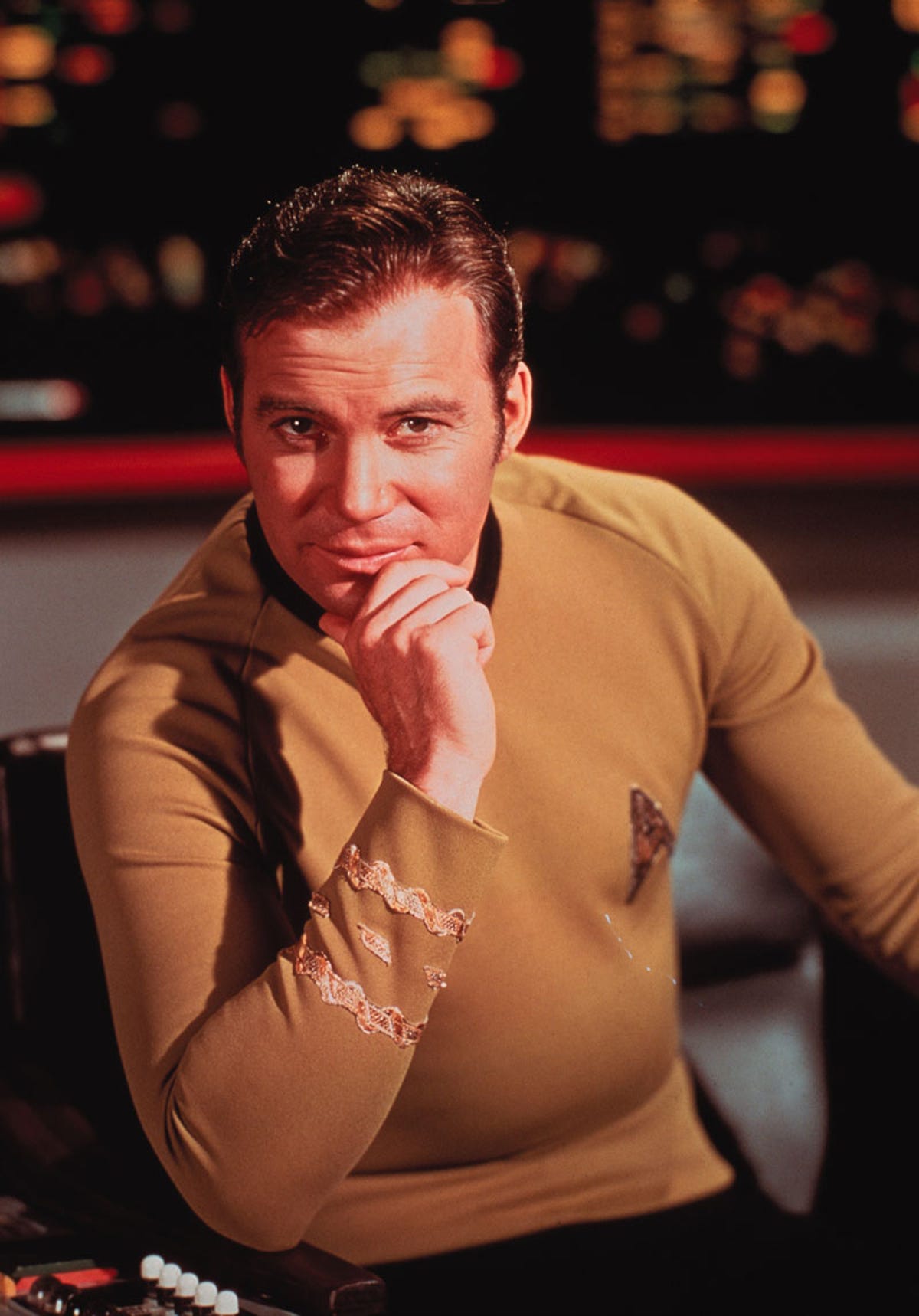
Why Star Trek > Star Wars
When it comes to nerd rivalries, it's hard to beat the decades-long siege pitting fans of Star Wars against devotees of Star Trek. In anticipation of "Star Wars: The Force Awakens" arriving in December, we corralled a couple Star Wars and Star Trek fanatics from CNET parent company CBS for a friendly (mostly) installment in the long-running debate over which is best -- and why.
As you can see by the gallery's title, this is the pro-Star Trek side, fronted by Leslie Gornstein. (Don't worry, Jedi knights. We have your response here. )
The first reason why Star Trek will always trump Star Wars? This guy. Before Han went Solo, Captain James Tiberius Kirk was slinging his earthy swagger in the furthest reaches of the galaxy. And thanks to the amazing maneuverability of the Enterprise, you can bet he could make the Kessel Run in way fewer than 12 parsecs.
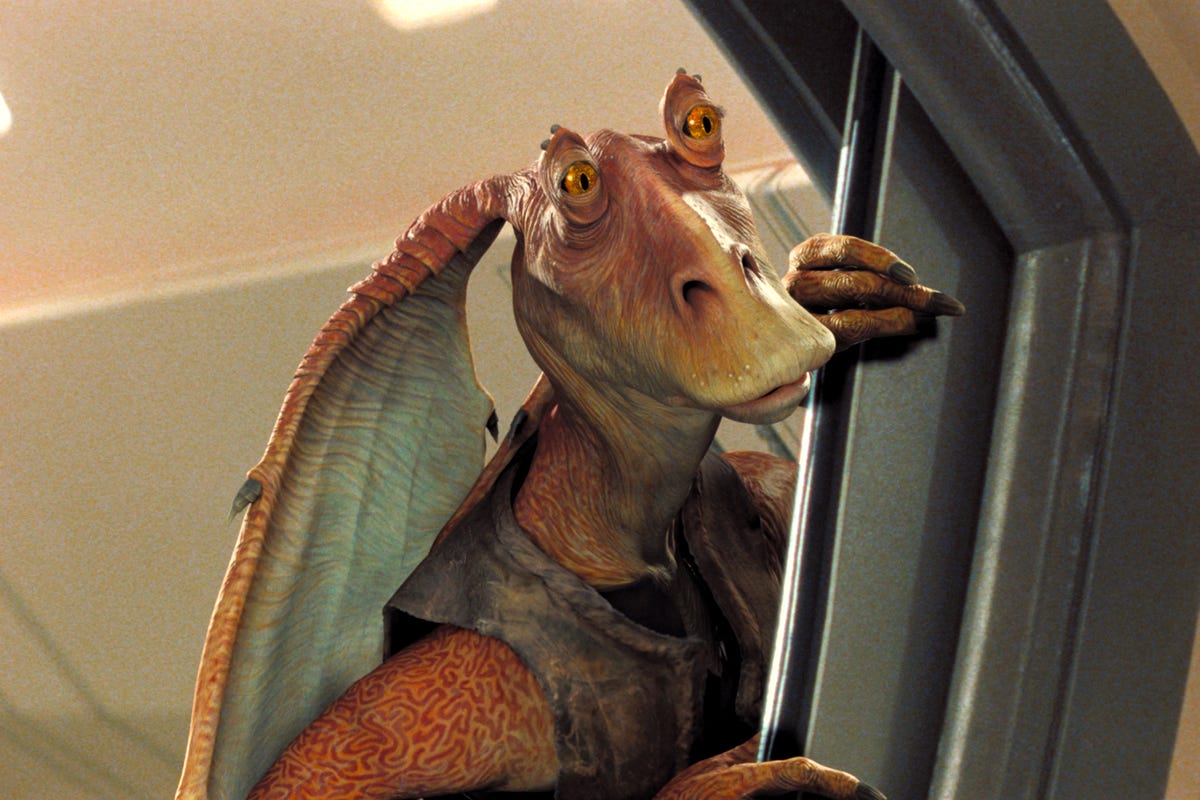
None of this guy
There are no Gungans in the Star Trek universe. And that is a big plus, given that Jar Jar often feels both crassly commercial and evocative of racial stereotypes. (Wall Street Journal critic Joe Morgenstern once famously called Binks a "Rastafarian Stepin Fetchit on platform hoofs, crossed annoyingly with Butterfly McQueen.")
Star Trek, meanwhile, is also void of Ewoks, which, according to many fans, reek of a naked merchandising grab -- "essentially Native American teddybears," Indiewire once said , "ready to be snapped up and snuggled by countless children the world over."
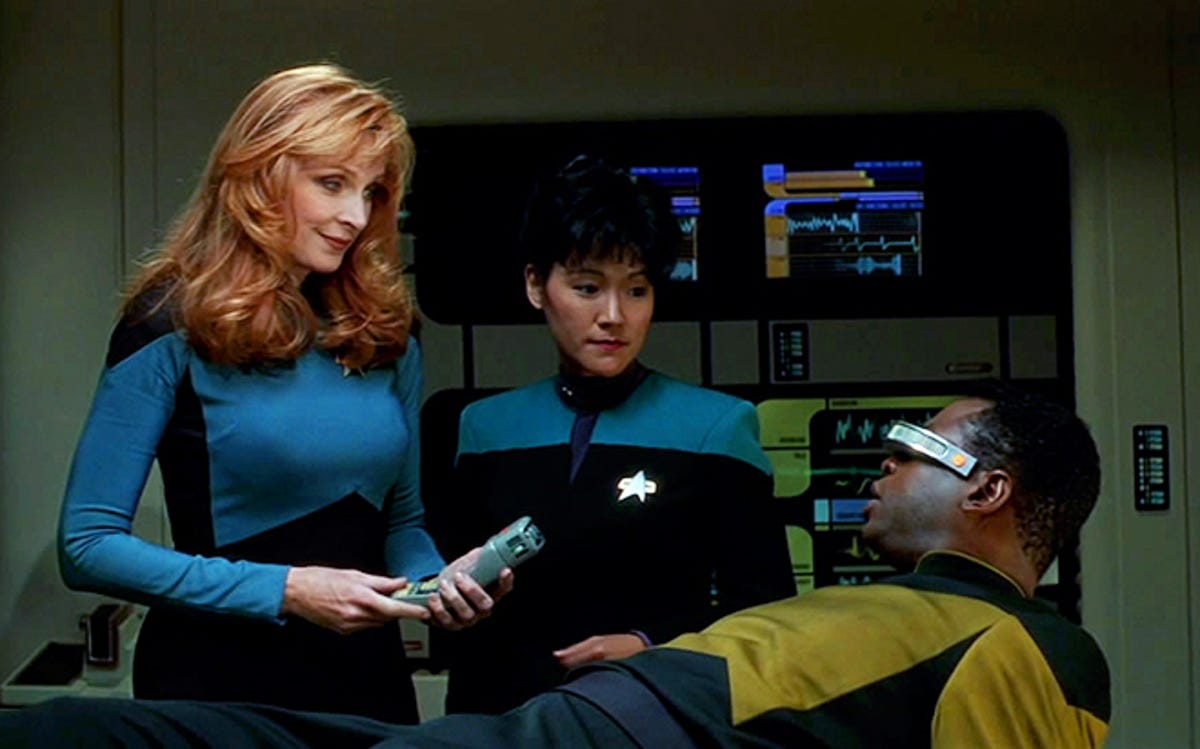
The tech is real
Star Trek was influenced by an all-American vision of a space-age future. In turn, America's future is now being influenced by Star Trek. Tricorders (like Dr. Crusher's, there), communicators and other devices once reserved for the Paramount lot are now, slowly but surely, making their way to the rest of us.
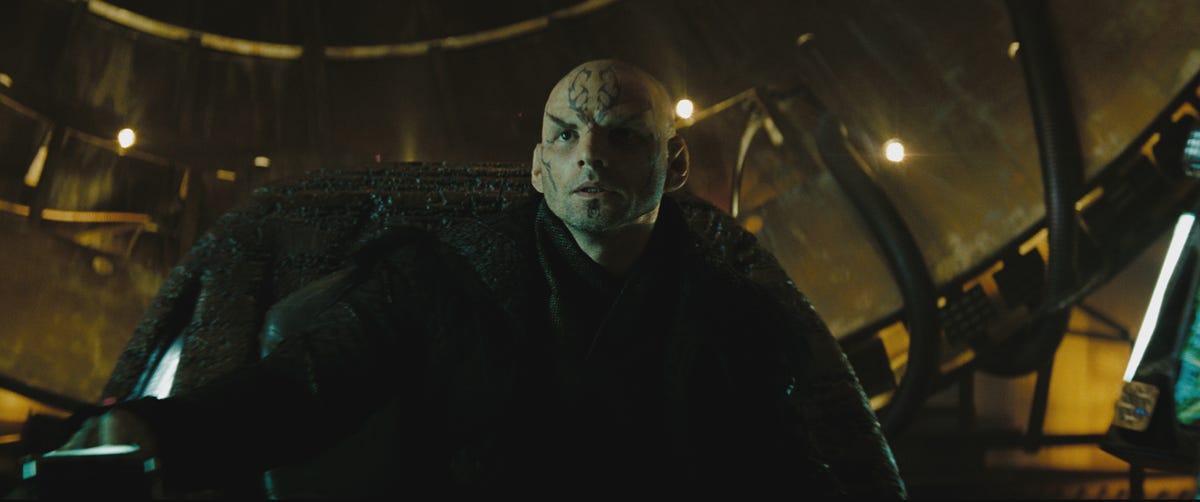
Time travel
Time travel shows up all over the place in the Star Trek franchise, including as a pivotal part of the 2009 movie reboot. Star Wars has, um, hyperdrive?
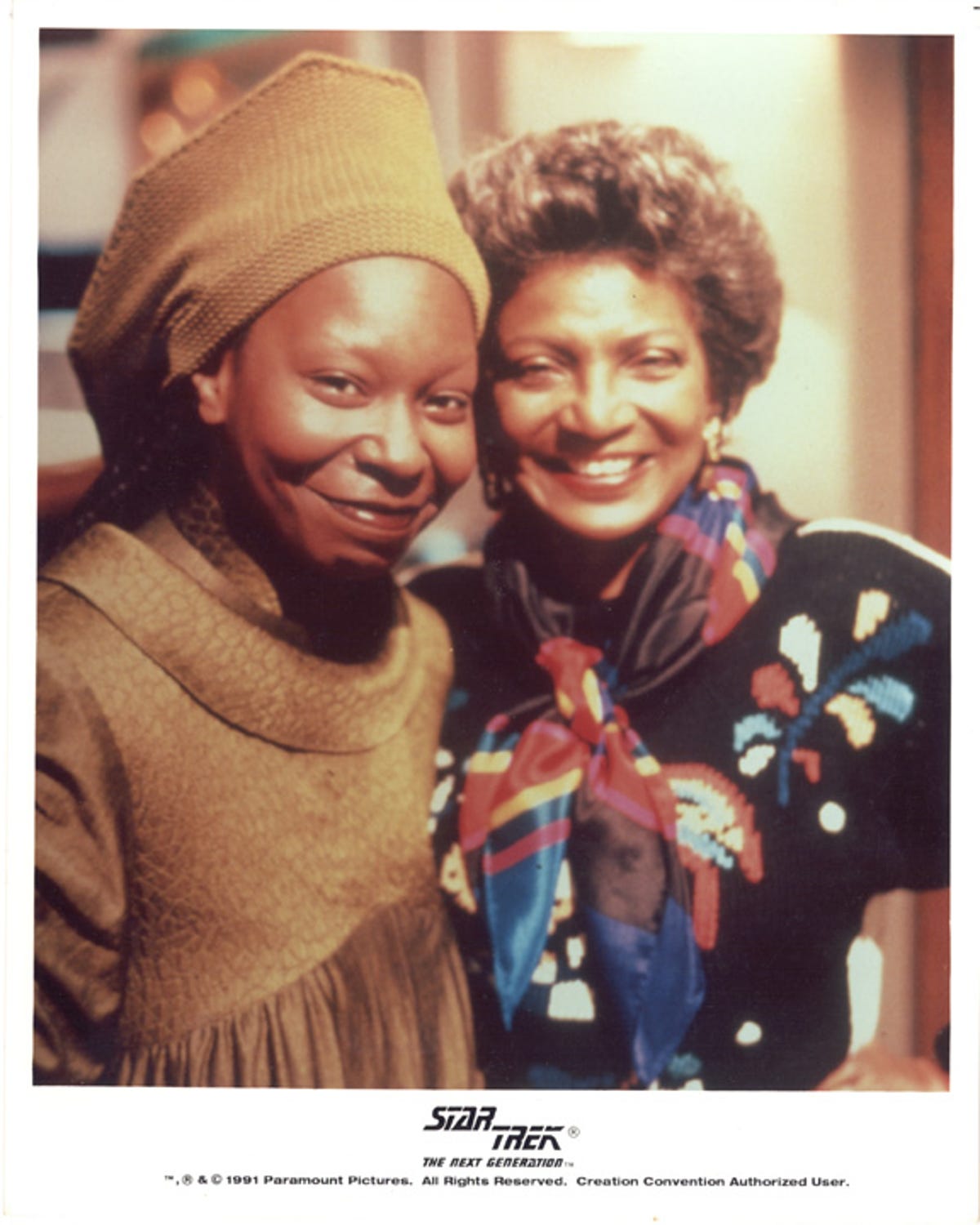
Badass women
Sure, Leia and Padma can handle their blasters, Ahsoka Tano is the fastest Jedi to bear a lightsaber, and Asajj Ventress is just scary.
But count the number of battle-ready women in the core Star Trek universe with their counterparts in the very extended Star Wars universe, and there's really no comparison. Uhura the Greater (that would be Nichelle Nichols) begat the steely-eyed Uhura the Lesser (aka Zoe Saldana); Kate Mulgrew helmed an entire ship as Captain Janeway; Tasha Yar (Denise Crosby) brought invaders to their knees as head of Enterprise security; Shahna of Triskelion (Angelique Pettyjohn) is cited by scholars as a prime example of an early female TV gladiator; and genocide survivor Guinan (Whoopi Goldberg) held it down in Ten Forward. The list goes on and on.
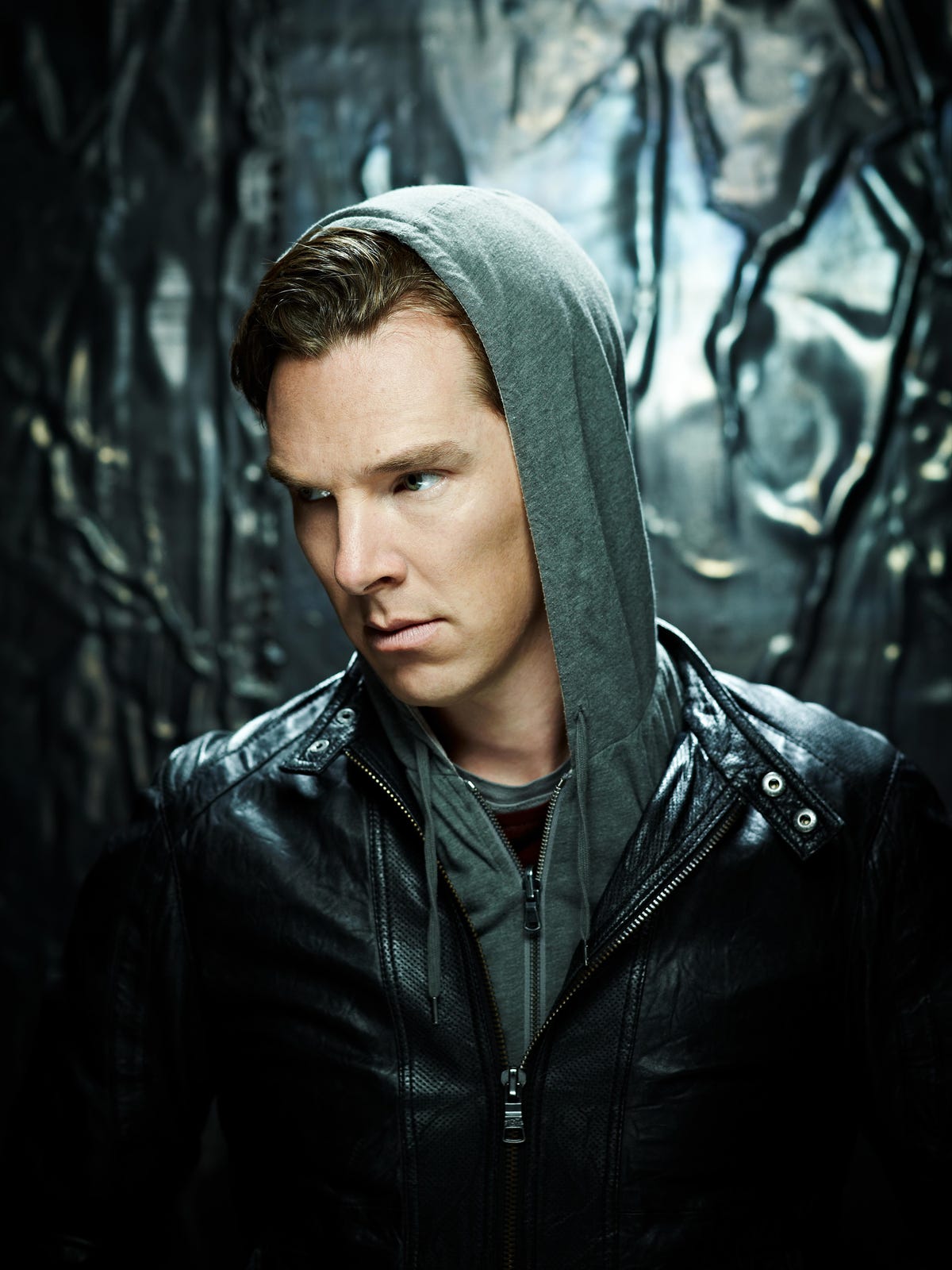
Smarter villains
Darth Vader is cool, what with the breathy mask and lightsaber skills and intimidating cloak. Darth Maul could sure put up a fight. But when it comes to villains with smarts as well as strength, the Star Trek universe wins. Just think of Khan, whose superior brainpower comes from selective breeding, versus Vader, whose dark-side powers come from being, well, super angry.
(Khan, by the way, has been played by two actors with deep wells of fans: Ricardo Montalban in the original series and "Star Trek II: The Wrath of Khan" and Benedict Cumberbatch in 2013's "Star Trek into Darkness.")
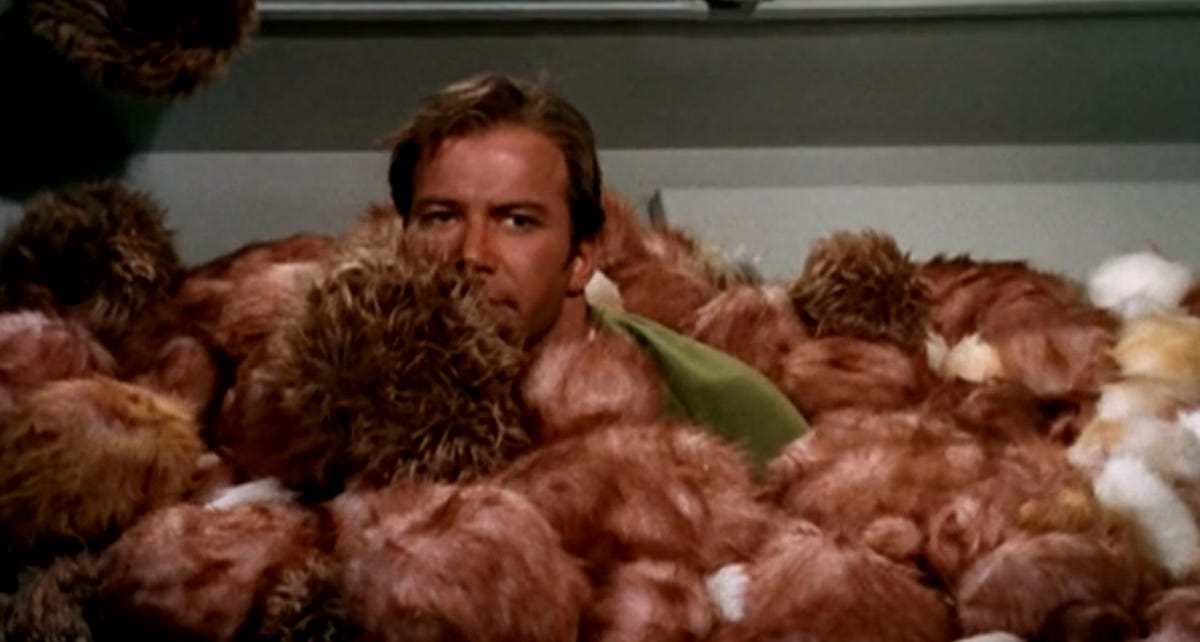
Well, OK. It's not just tribbles. It's Star Trek's whole approach to humor -- smart, subtle, something that builds and often stems from the characters themselves. Star Wars? Sure. It has humor. If you think Jar Jar Binks is funny.
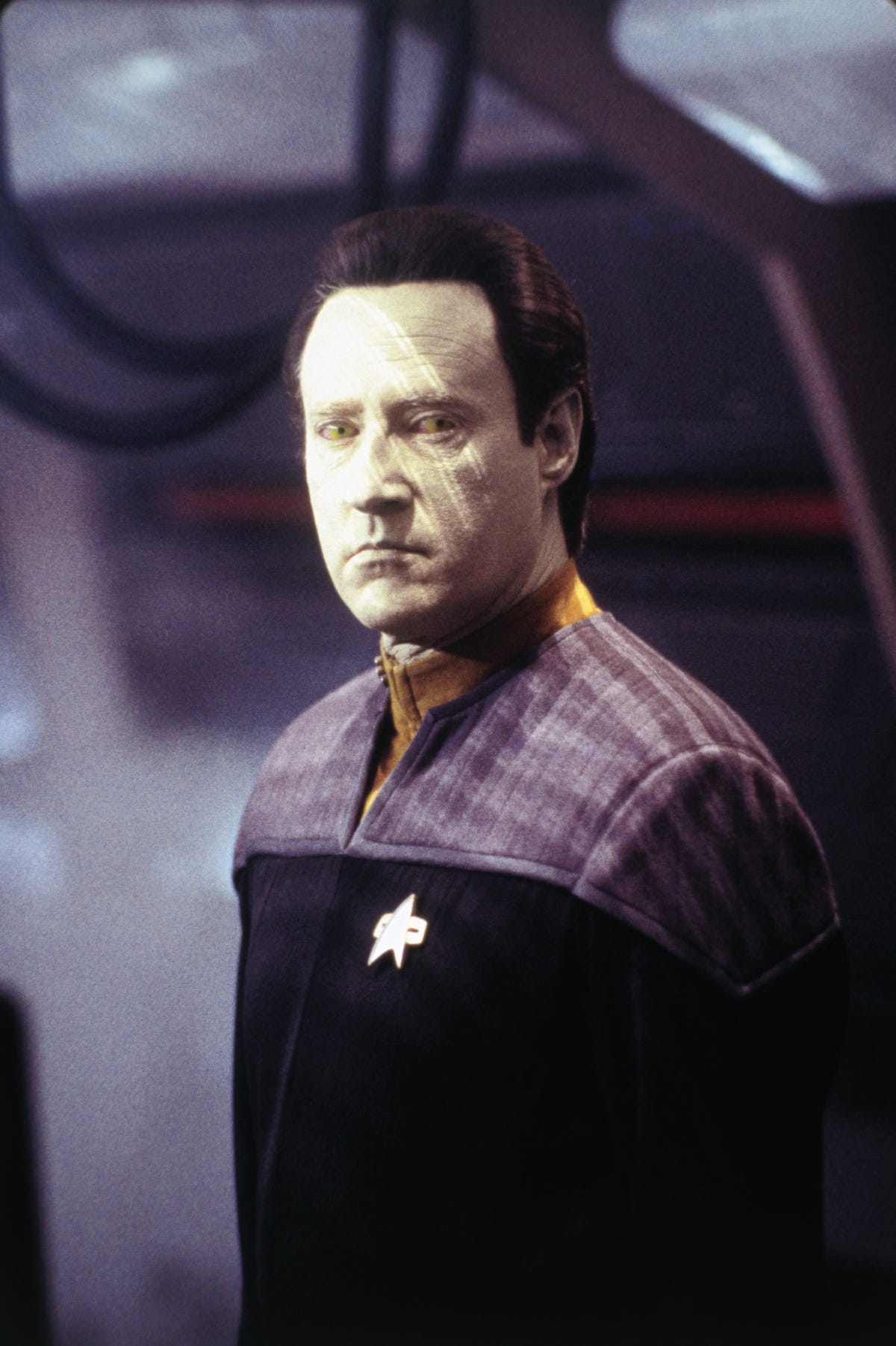
Cooler robots
Yes, Star Wars may have more realistic- looking robots. But thanks to the presence of the unique life form known as Data, Star Trek certainly has cooler robots. Think we're wrong? Consider this: Can C-3PO have sex? Exactly.
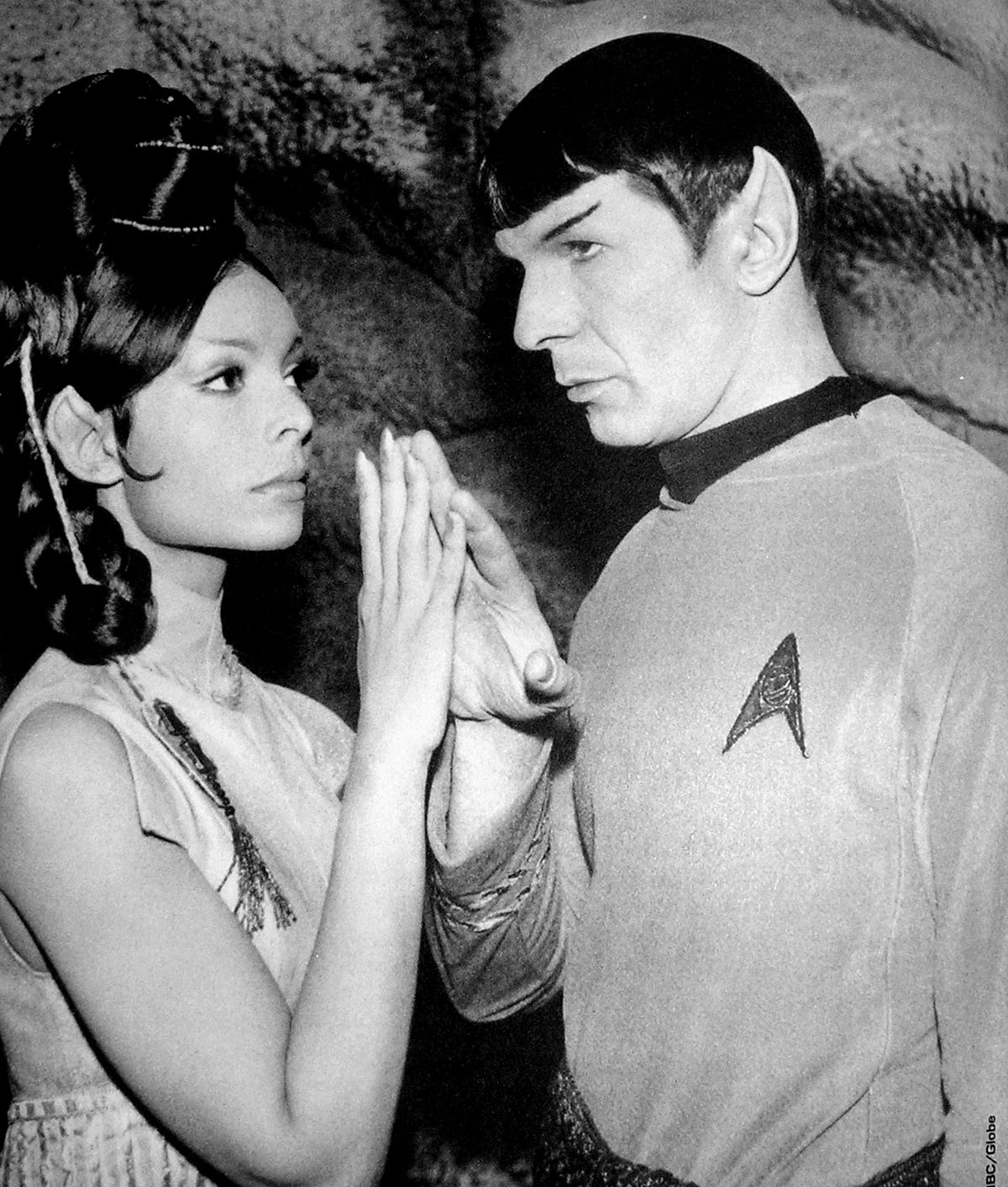
So much sexy
The Star Trek universe is just sexier. Exhibit A: this Vulcan who almost married Spock.
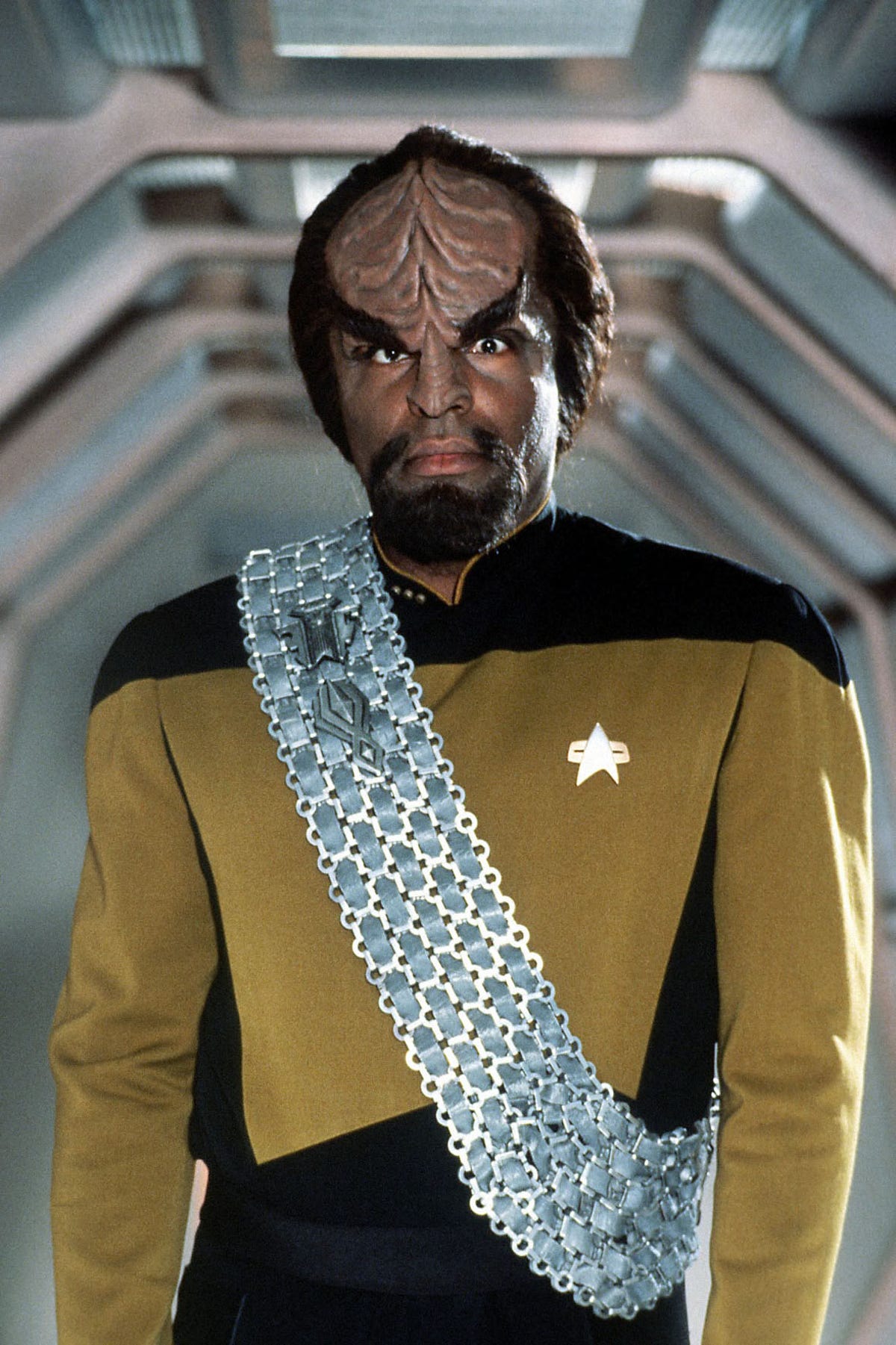
A whole new language
The Klingon language: It's a real thing. With a real institute. With real people who speak it. Look it up .
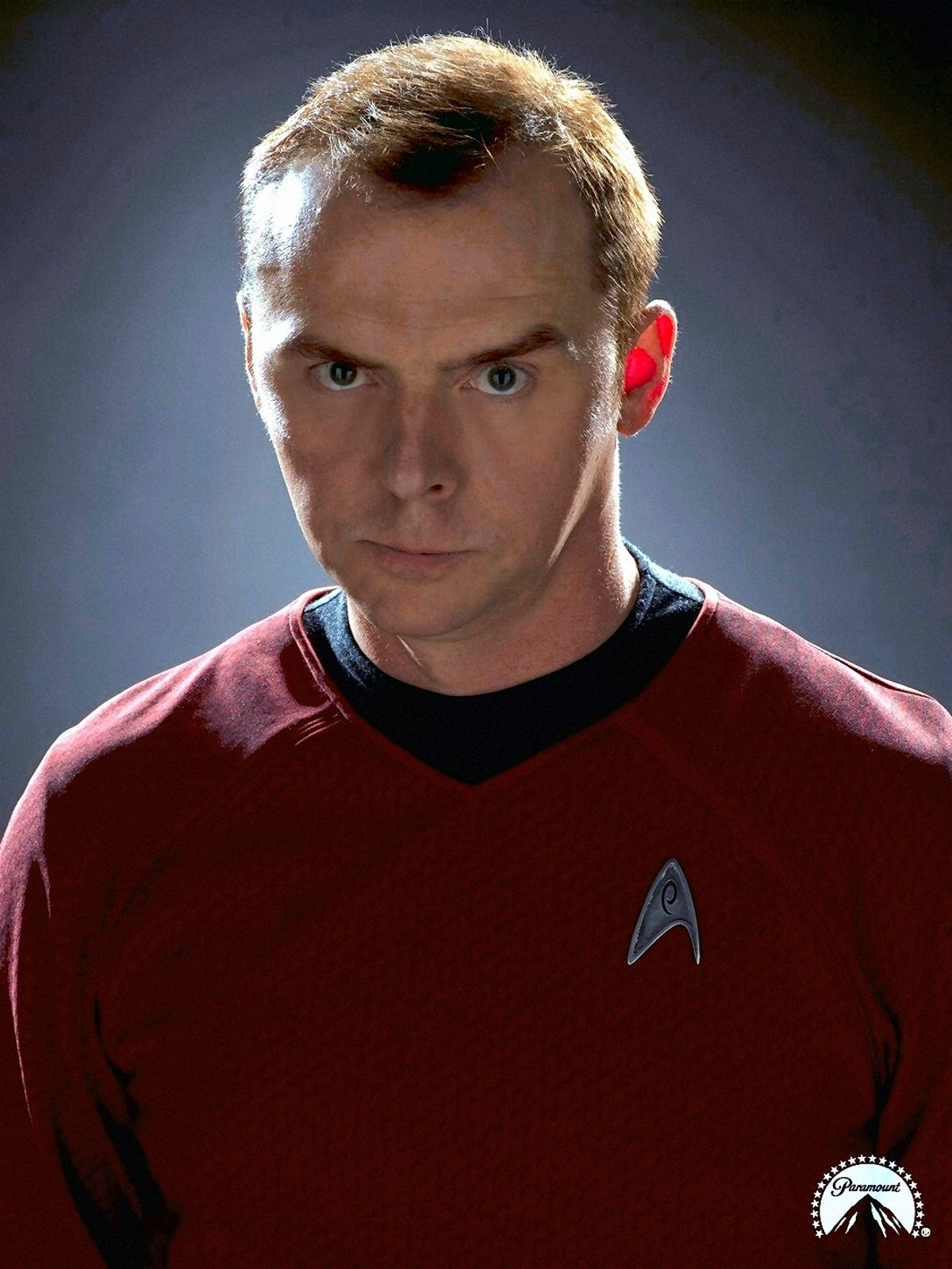
The catchphrases
Star Trek has brought us highly quotable quotes for any occasion: "Live long and prosper," "Beam me up, Scotty" and"To boldly go where no one has gone before," to name but a few.
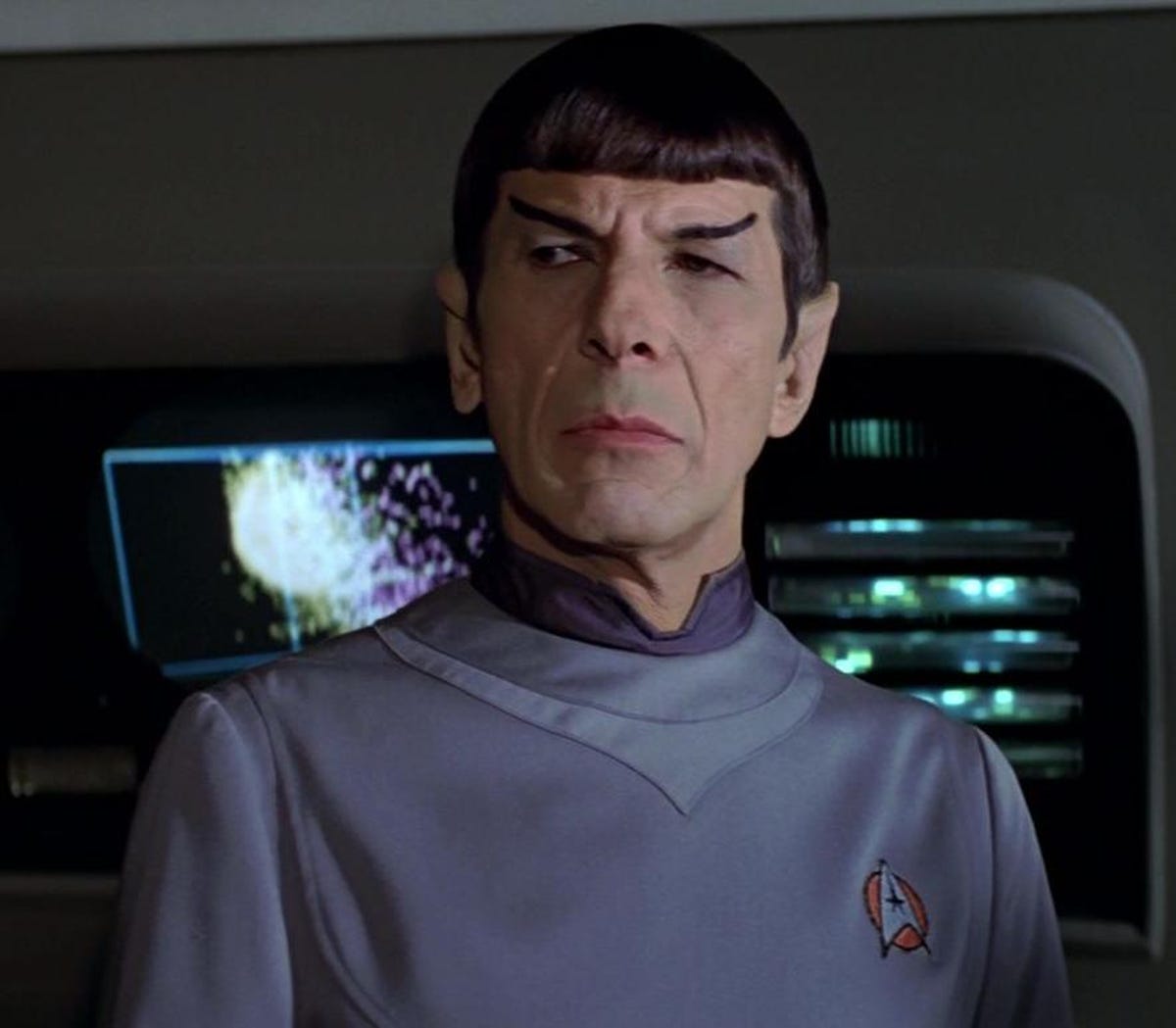
A focus on science
Star Wars has a beautiful, almost classical mythology to it. That's really nice. But the Force, a wellspring of supernatural occurrences, is essentially quasi-religious mumbo-jumbo. Star Trek's imagined future can sometimes be so fanciful it's silly, but at least it celebrates science, a discipline that is often underrated and underplayed in pop culture.
Star Trek even has science officers, like Spock.
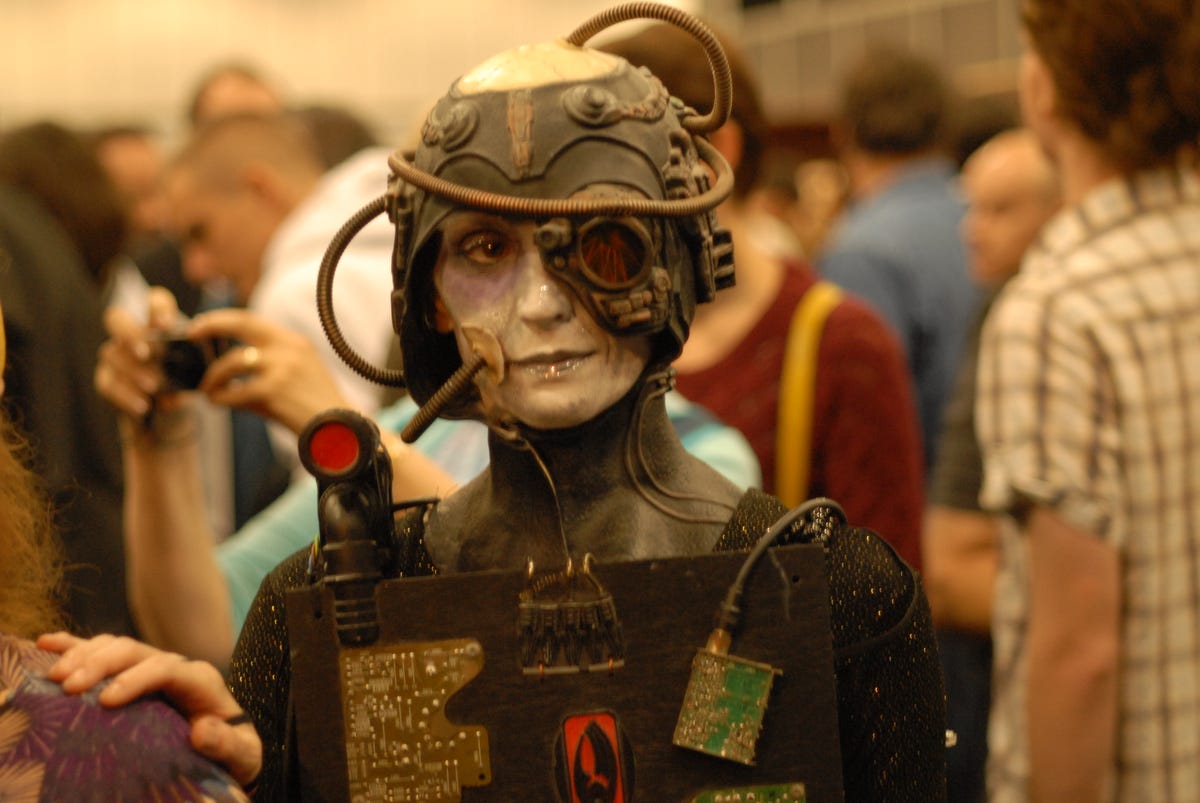
Better conventions
Nobody dresses like this for Star Wars conventions. Yes, there's plenty of good Star Wars cosplay out there, but Star Wars really doesn't have the decades-long convention culture enjoyed by Star Trek fans.
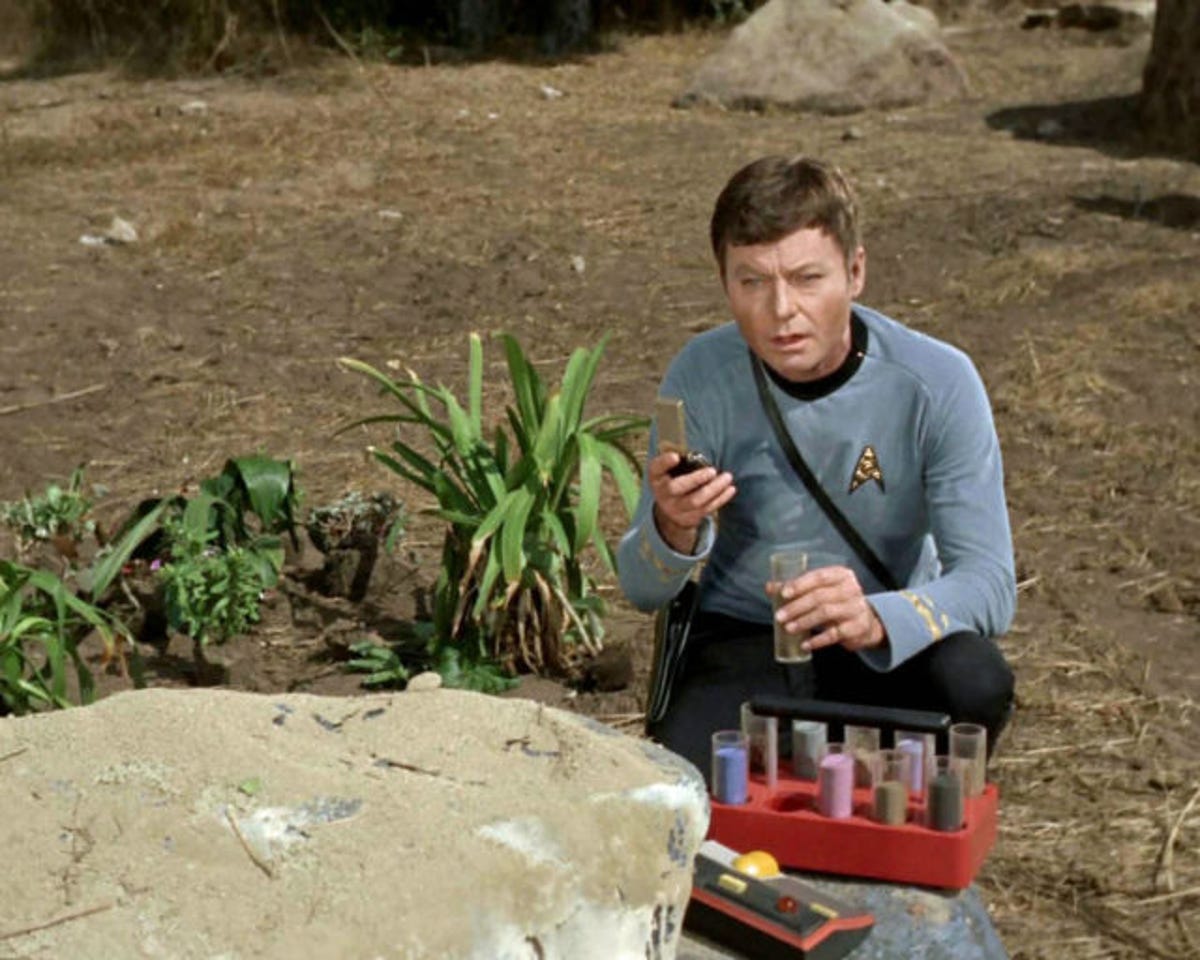
A genuine respect for critical thinking
Star Wars has many noble values. Curiosity and critical thinking are not among them; Jedi padawans are encouraged to keep their yaps shut, isolate themselves from the greater world, and submit themselves completely to the Force and their masters.
Star Trek? To heck with that. If Bones here is questioning conventional medical wisdom or someone in authority, that just means it's Tuesday.
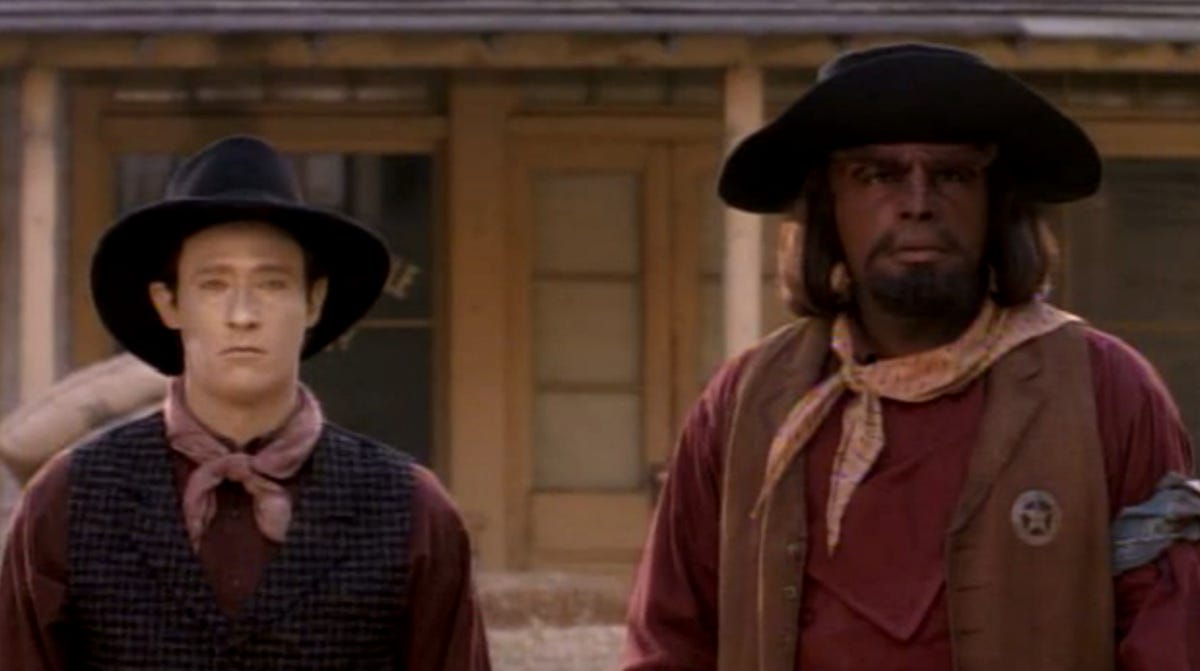
Are there holodecks on the Millennium Falcon? No? Call us when Han installs one.
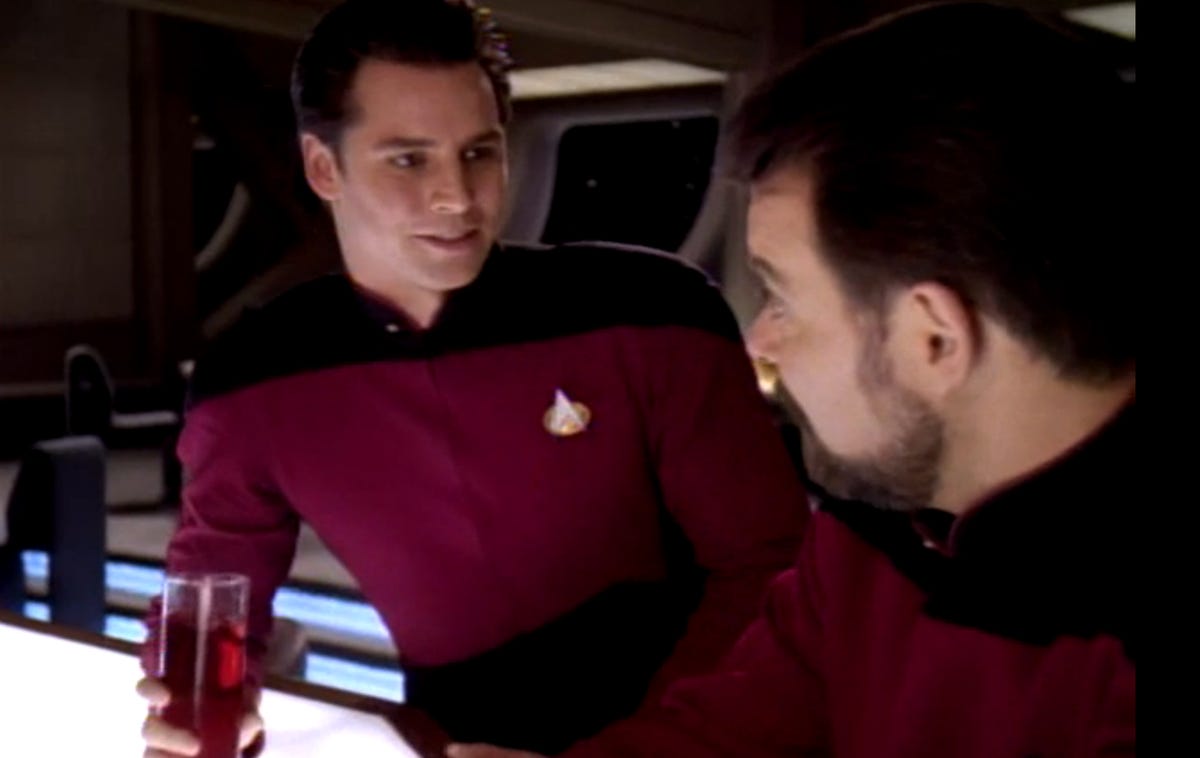
So much more to love
So far, the bulk of the Star Wars saga has taken place over six (soon to be seven) films. The original Star Trek series alone had 79 episodes. TNG produced a breathtaking 178, including rare gems such as "Lower Decks," which dedicated a main storyline to the Enterprise's unsung ensigns. As far as the big screen goes, a dozen Star Trek films have been released and at least two more are on the way.
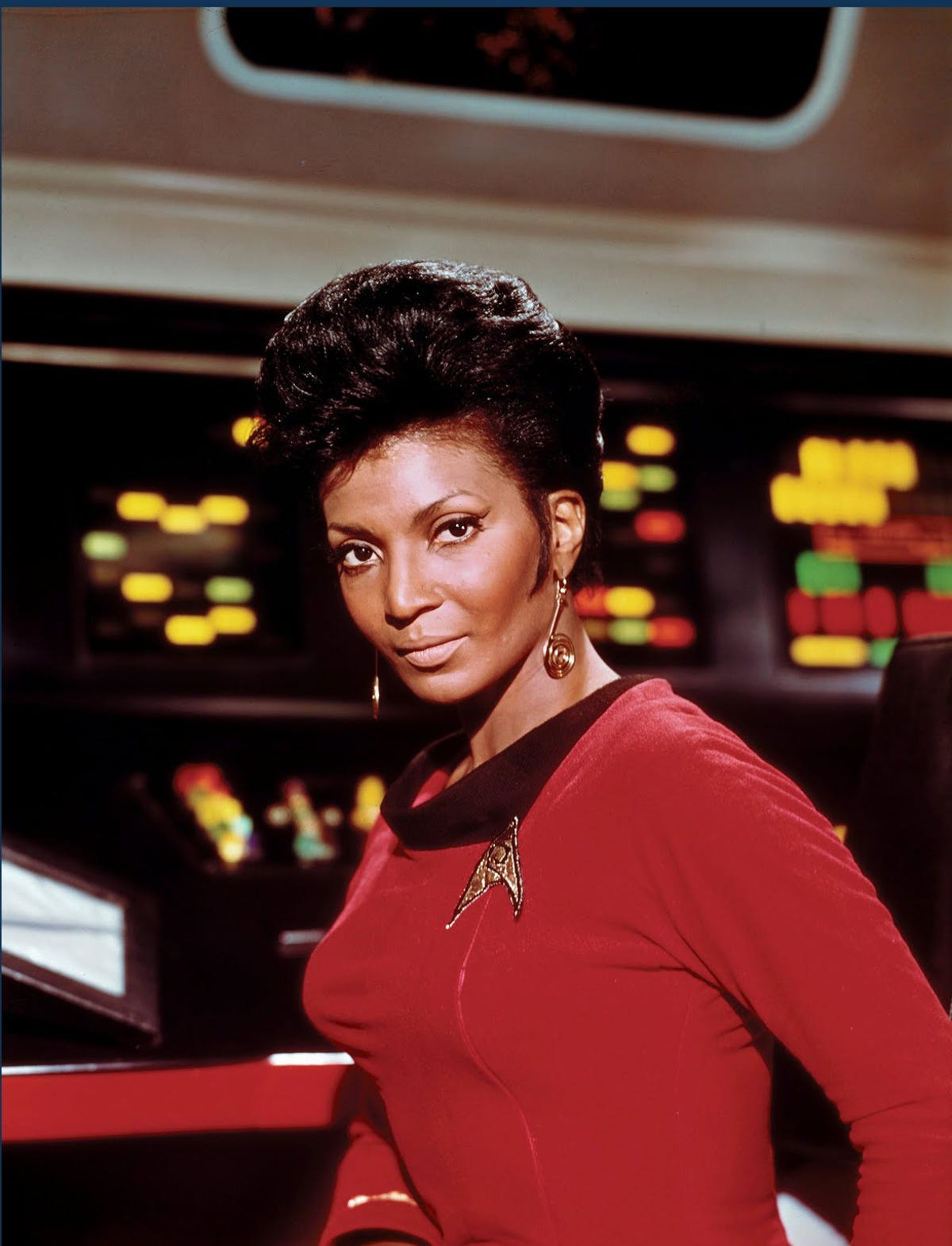
Real social issues
Good versus evil, the anchor of the Star Wars universe, is a nice, safe theme in any genre. Know what isn't? Racism. Homophobia. War crimes. Drug addiction. Abortion. The Star Trek universe has tackled them all, often before it was cool to do so.
And speaking of tackling issues, the Star Trek universe has routinely, since the very beginning, had diverse crews that included esteemed actors such as Michael Dorn, George Takei, LeVar Burton, Nichelle Nichols, Zoe Saldana, Whoopi Goldberg and Avery Brooks.
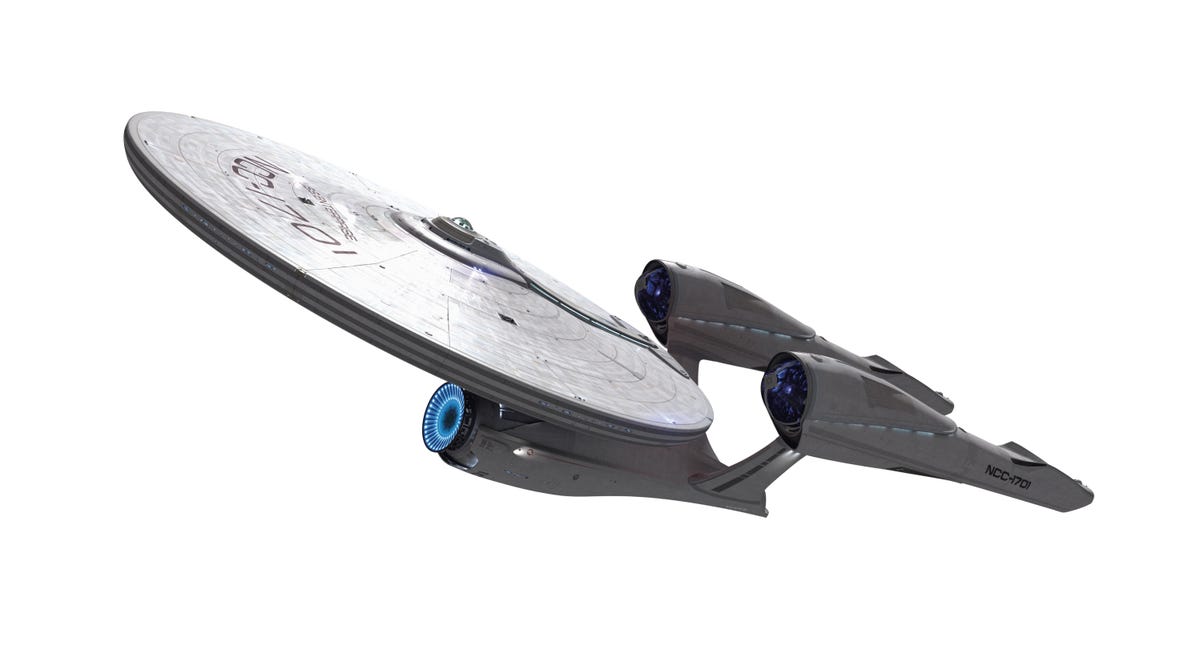
Just look at the Enterprise
The Falcon is kind of a Frisbee compared with the Enterprise.
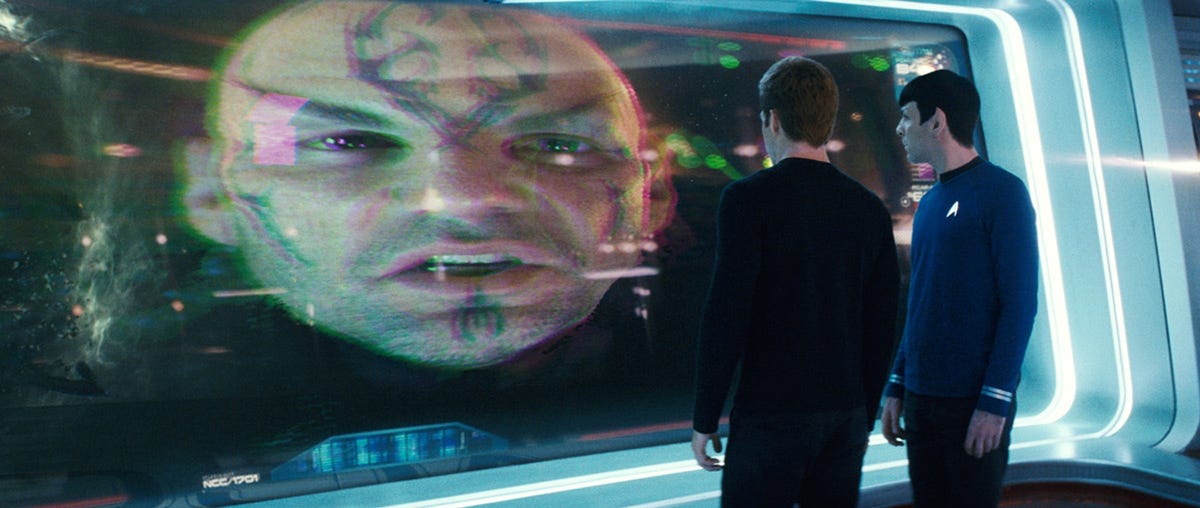
Cooler communications
If you want to get a message across the Star Wars galaxy, you need either a headset or a robot willing to carry your holographic message across enemy lines. But you can't even hang in the Star Trek universe without a big ol' flat screen on your bridge and a communicator pinned to your uniform.
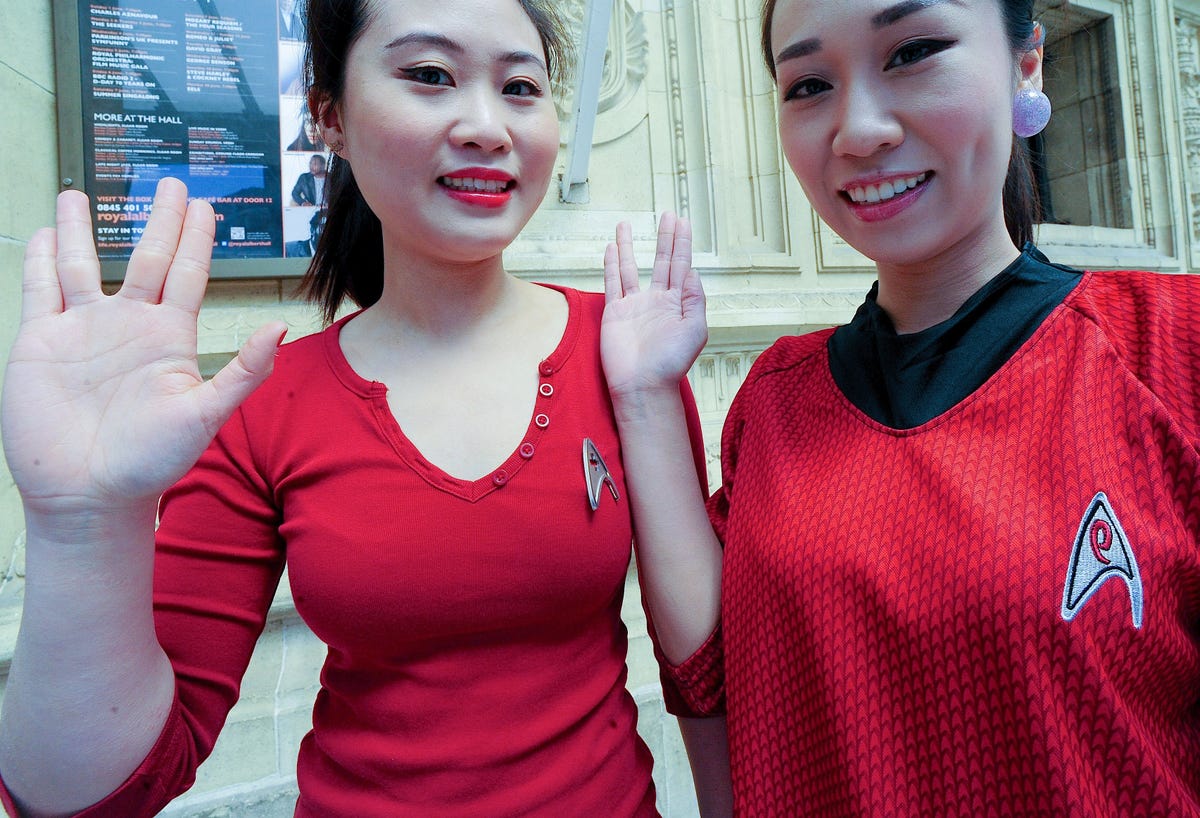
The Vulcan salute
The hand gesture that accompanies Spock's cherished motto, "Live long and prosper," has grown so popular that upon Leonard Nimoy's death, the White House called it "universal." The salute has even been flashed on the International Space Station. In the Star Wars universe, there's simply no equivalent.
More Galleries

My Favorite Shots From the Galaxy S24 Ultra's Camera
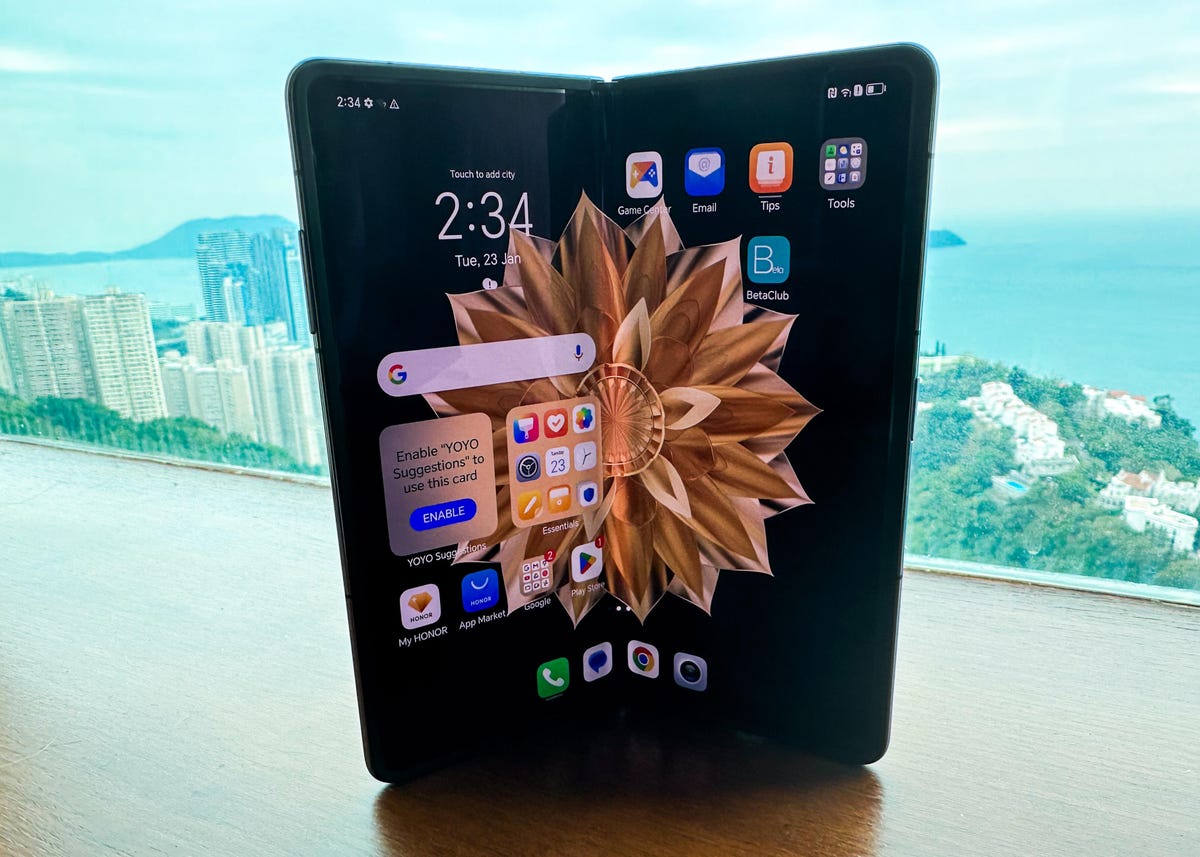
Honor's Magic V2 Foldable Is Lighter Than Samsung's Galaxy S24 Ultra

The Samsung Galaxy S24 and S24 Plus Looks Sweet in Aluminum

Samsung's Galaxy S24 Ultra Now Has a Titanium Design

I Took 600+ Photos With the iPhone 15 Pro and Pro Max. Look at My Favorites
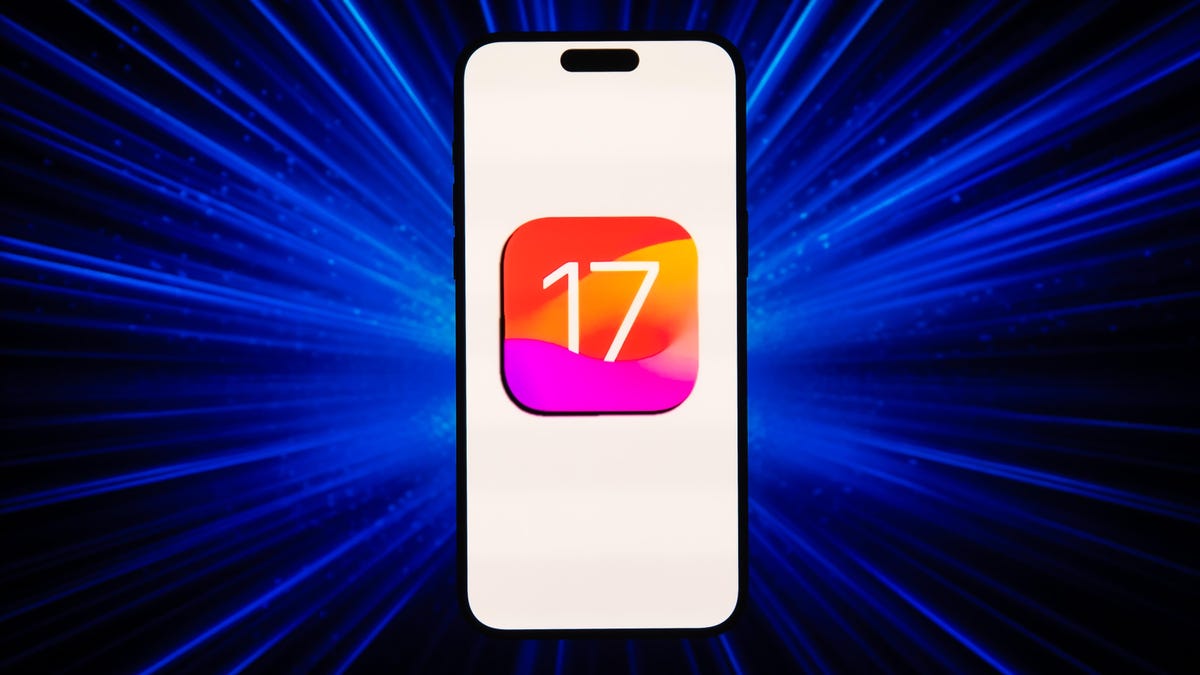
17 Hidden iOS 17 Features You Should Definitely Know About

AI or Not AI: Can You Spot the Real Photos?
Movie Reviews
Tv/streaming, collections, great movies, chaz's journal, contributors, sdcc 2020: the psychology of star trek vs. star wars.

Moderator Brian Ward of "The Arkham Session" posed four topics to pop culture psychologists Dr. Drea Letamendi ("Lattes with Leia") and Dr. Ali Mattu ("The Psych Show") and special guests Todd Stashwick ("Star Trek: Enterprise") and Jennifer Muro ("Star Wars: Forces of Destiny") to analyze "The Psychology of Star Trek versus Star Wars."
Ward did a switcheroo and changed Muro from Team Wars to Team Trek and Stashwick from Team Trek to Team Wars.
· Dr. Ali Mattu
· Jennifer Muro ("Star Wars: Forces of Destiny")
· Dr. Drea Letamendi
· Todd Stashwick ("Star Trek: Enterprise")
First Topic
The Mandalorians and the Klingons have largely been defined by their strong sense of cultural identity, creed and code. How do these two groups demonstrate real-world group dynamics and which group actually shows more promise in terms of social justice? Whose set of principles seems more realistic?
Letamendi of Team Wars : The Mandalorians have a strong code, not unlike the Klingons, that emphasizes strength and bravery in combat. For the Mandalorians, separate pieces of armor have specific significance. The Mandalorians are not a race and they welcome other ethnic groups unlike the Klingons. The Mandalorians "seem to embody what a sophisticated group would think about in terms of actualizing everybody" and "those two components include belongingness and individualism." While she loves Star Trek, with the Klingons, she struggles to understand the concept that a race such as the Klingons are "characterized by aggression and combat and violence." It seems to be implied that "this is an inherent part of this race."
Mattu of Team Trek : Mattu told Letamendi, "You need to watch more Star Trek." While he found that Letamendi brought up some great points, Mattu felt the Klingons "are a better parallel to the world we are living in right now." He also noted that the Klingons "have always been a reflection of the world that we live in." In the 1960s (TOS), even with Mr. Chekov on the bridge of the Enterprise, the Klingons were "kind of the Soviet Union villain." He added, "We didn't really know much about them; we just knew that we hated them." With Worf in "The Next Generation," he noted, "You begin to see that there's actually a lot more diversity to the Klingons, to their beliefs." In "The Next Generation," the Klingons are not so driven by aggression and war, "but they do have this very strict honor code."
In the newer series, "Star Trek: Discovery," the experience with Klingons is mixed. In the first episode of "Star Trek: Discovery," you see that "there are actually different tribes of Klingons that have evolved on different planets. Worf's journey from "The Next Generation" to "Deep Space 9" to the movies, is "a great parallel for how we all experience culture" because in some ways Worf is very much Klingon in that "he's very much integrated with his Klingon identity." He speaks Klingon very well and appreciates Klingon cuisine and music, but in other ways he's separated and "more estranged from his Klingon heritage."
Stashwick of Team Wars : Stashwick stated, "Mandalorian is a choice; it's not a state of birth." There was a planet that had a social hierarchy, but where it stands today, "they have come to the aid of the oppressed." As for Klingons, what he has seen, they have been presented as a very aggressive and Worf is the exception, but not the rule. He is an outlier.
Muro of Team Trek: Muro was 50-50 on this. When she thinks of diversity with Klingons, she thinks there is a psychological diversity. When Worf talks to other Klingons, some are honorable, and some are really bad to him. She feels it is very relevant now because "It is one race, but there is so much psychological diversity in that race. That is kind of how humans are."
Mattu of Team Trek: Mattu added there's something inspirational to have the "these villains who just a few years later are at peace with the Federation and have a Klingon serving on the bridge of the Enterprise."
Second Topic
Ward wanted to talk about emotional intelligence in the context of "someone who started out as an idealist" but who "dipped their toes in the waters of darkness." The hubris and self-doubt of the characters sent them into hermitage, meaning both Luke Skywalker and Jean-Luc Picard. How do their lives show experience of trauma and how do they grow emotionally?
Mattu of Team Trek: Mattu said he was really stressed "because honestly, I love Picard and Luke's journey so much and I think they're just such beautiful stories of trauma." Picard has experienced many traumas. He was assimilated by the Borg and was responsible for the deaths of many humans and humanoids. Picard also lost his brother, his sister-in-law and his nephew in a fire ("Star Trek: Generations"), and then he had to face the Borg again and again. Through this all, "what has helped Picard to stay emotionally intelligent to understand what he's going through to get what he needs, to emotionally be resilient and bounce back, it's his ship; it's his crew." The support of Troi and the meaning and purpose behind being a Starfleet officer is what gave him that resilience and this is "compromised" in "Star Trek: Picard" where he was trying to save Romulans and the Starfleet wouldn't support him. He could not handle that compromise and went into hiding. "That is something many people do who experience trauma." Mattu is also a big fan of the journey seen in "The Last Jedi" with Luke. In both, he thought we're reminded to learn from our failures.
Letamendi of Team Wars : Letamendi agreed that these two stories are about the development of emotional intelligence. EQ is about how we try to override the logic and "just tap into the emotions that we're experiencing." EQ is not just about our emotions, but also being able to empathize and understand the emotions of the people around us and letting those feelings drive our behaviors. She said, "I've always looked at Trek to help understand social relationships and Star Wars is more about the interpersonal." When Luke goes into isolation, he is "not yet learning from his setback; he feels responsible for Kylo Ren becoming darkened in his path...he lets that resentment and feelings of self-doubt and failure permeate." When Rey comes, he's able to understand that it's not about himself all the time.
Third Topic
What do Rey and Michael Burnham show us about healthy coping and self-care? How do they preserve or deny their heritage and identity to maintain their mental well-being? What's the importance of legacy when it comes to saving the universe?
Letamendi of Team Wars : Rey had to adjust and adapt to being a scavenger and this gives her great resilience. Her journey is about developing this sense of resilience. Resilience is "our ability to mentally and emotionally cope with hardship," but also how we use external resources and ask for help. Despite the hardships she faces, Rey finds contentment and joy which is not only difficult to do, but "also shows that she's holding on to a sense of hope."
Mattu of Team Trek: Mattu mostly agreed and added that she "struggled deeply with her being a Palpatine." The notion of legacy is "really what you make of it and what you learn and who you want to be." With Burnham, we find out that she has been raised by "probably the most famous parents in Star Trek and she is a sibling to probably the most famous character, Spock." Mattu highly recommended watching "Short Treks" because there's one about her and her father ("Star Trek: Short Treks," Season 2, Episode 9, "The Girl Who Make the Stars"). She lost her parents and was raised on Vulcan after being adopted by Sarek and Amanda. Burnham has been able to code-switch which adds to her ability to see things from different perspectives. In a sense, this shows how diversity is better. It is harder, but "diversity is a superpower that will help you solve problems you could never do, you could never solve with everyone coming from the same place," Mattu explained.
Stashwick of Team Wars : Stashwick noted that while many people criticized "The Force Awakens" as being a retread of "A New Hope," Rey was looking for a sense of family and belonging while Luke was running away from family and looking for adventure. Rey's newfound family fortified her enough to be able to overcome the darkness.
Muro of Team Trek: Going last left Muro with little to say and expand upon, but she noted that with Burnham, she has invested a lot in attempting to emulate the Vulcan culture, but finds her resilience is from "giving in to the passion of her humanity."
Fourth Topic
The Kelvin Timeline was, according to the Official Star Trek Online Wiki, the alternative quantum universe created when a Romulan starship traveled back and destroyed the USS Kelvin.
Mattu of Team Trek: Mattu talked about "Star Trek Beyond," and how it begins with Kirk and Spock really struggling with their positions. Kirk feels that things have become "episodic." Spock is struggling with the loss of Spock prime "as we all were with the death of Leonard Nimoy ." The whole story is about reconnecting with what is Starfleet. Reconnecting with the meaning of what you do can help you through tough times, including living under COVID-19 restrictions.
Letamendi of Team Wars: Letamendi doesn't know enough about the Kelvin timelines to be critical. These stories have given us purpose. Star Wars "is storytelling around concepts of redemption" and that's something that we struggle with. The human experience is filled with making mistakes, having flaws and dealing with not only our own flaws but the flaws and mistakes of others. The Star Wars story has always been about a sense of "can we work on rebuilding connection and harmony." If you can come back to the good of yourself, "you can accept some of the mistakes you've made." That's something that is hard to do.
Stashwick of Team Wars : Stashwick noted that with J.J. Abrams, he "clearly was a Star Wars man" who was "handed the keys to the Star Trek kingdom and he made a Star Wars version of Star Trek," but Stashwick then noted that with Star Wars, "just because you blew up a Death Star once, your problems aren't over." Beating back the demons is "an eternal struggle" and "a noble pursuit." He concluded with "the struggle is real," and we need to "be strong and be together."
Live Long and Prosper and May the Force be with you in 2020.

Jana Monji, made in San Diego, California, lost in Japan several times, has written about theater and movies for the LA Weekly , LA Times , and currently, Examiner.com and the Pasadena Weekly . Her short fiction has been published in the Asian American Literary Review .
Latest blog posts

O.J. Simpson Dies: The Rise & Fall of A Superstar

Which Cannes Film Will Win the Palme d’Or? Let’s Rank Their Chances

Second Sight Drops 4K Releases for Excellent Films by Brandon Cronenberg, Jeremy Saulnier, and Alexandre Aja

Wagner Moura Is Still Holding On To Hope
Latest reviews.

Challengers
Matt zoller seitz.

Disappear Completely
Brian tallerico.

LaRoy, Texas
Robert daniels.

The Long Game

Sasquatch Sunset
Monica castillo.


Simon Abrams
- The Inventory
Who Would Win in an All-Out Battle: Star Wars or Star Trek?
A classic debate! Good or Evil? Chocolate or Strawberry? Star Trek or Star Wars (excluding the Death Star)? But unlike those timeless questions this one really does seem to have a compelling answer. And its not what the majority seem to think.
Related Content
A few necessary caveats (take heed ye trolls):.
1) Although it (should) hardly need saying— these are both completely fictional universes whose technology and scientific foundations are, at best, bolted on after the fact as part of the setting and/or necessary plot devices. This entire debate is like meaningfully debating the combat prowess of Unicorns vs. Dragons. But of course, we're going to do it anyway.
2) The goal is to assume the most favorable interpretations for each technology as demonstrated most coherently by each canon. Obvious mistakes (i.e using parsecs as a measure of time... Hello Han) or figures completely inconsistent with the results offered (Star Destroyers with power generation of 7.75 x 1024 W... only 100 times less than the sun!) will be ignored.
For those crying foul a Star Destroyer that needs that much power (to create the abilities displayed) would represent the most fantastic inefficiency ever conceived. Likewise, some of the energy readings suggested for Star Wars laser weapons would instantaneously vaporize any unshielded craft—not to mention the atmosphere in between them—in rather spectacular fashion. Nothing in the physical behavior of these weapons supports these values (for instance that Slave 1 has 64,000 GW lasers or 190 Megaton missiles. Never, in any battle, was a blast of that nature or kind observed).
Bottom line: All weapons and systems should be evaluated on how they actually perform as depicted in the canon as opposed to often innumerate and psuedo-scientific gibberish offered in support of them. That being said, where a vaguely credible explanation has been offered, it will generally be taken (i.e. lasers are lasers).
3) The treatment of technology dramatically complicates the task of comparison. Star Trek consciously attempted to provide at least some basis (however weak or novel) for the science behind their technology. Star Trek represents a technological utopia and was promoting the idea of a better future via modern technology. This is also evident in that the technology of Star Trek advances dramatically over the course of the various seasons (including referencing far future Star Trek timelines with mastery over time itself). Star Wars, on the other hand, makes no such claims and depicts an utterly static technological milieu in which no appreciable advances have been made (save perhaps the Death Star itself) in tens of thousands of years. In addition, Star Wars often offers little—if any—scientific explanation for its tech (Hyperspace—it's fast!). I am assuming the general tech capabilities of Trek as found as late as Voyager.
Now, those out of the way lets get to the point. This is not a close fight. Despite the desires of the many fans, the Star Trek universe is rife with economic, tactical, social, and technological superiority. Claims of Star Wars victories all seem to echo the Stalin-esque view that "Quantity has a Quality all its own." But this is profoundly misguided. Let's break down why.
Economic Factors
Star Wars population is very difficult to assess. Some estimates suggest a 1,000,000 world Empire. But the Galactic Senate depicts a vastly smaller political entity. According to Star Wars Wiki , the Empire was divided into units of 50 systems each with a senator. However, the Senate only has 2,000 members. Which means a galactic polity of 100,000 active members. This is still vastly greater than the Federation with something like 150 members and 1-5 thousand worlds.
However, the nature of this population is most important. The Empire, while having far larger population, appears weakly integrated. Entire populations (quite commonly) are depicted as isolated and poor. Basic farming or harvesting seems commonplace. Much of the population appears uneducated and even tribal. While the core worlds are densely populated, they are apparently completely dependent on agricultural and other products from the empire. This means Star Wars retains a traditional resource economy model.
Star Trek, by contrast, has matter/energy conversion. The Federation is deeply integrated with almost no poverty and a large decentralized membership of worlds. The importance of matter/energy conversion cannot be overemphasized. On a war footing, the only limits to the Federation's economic capacity is energy which is in vast supply in both universes.
In addition, each world is at least theoretically capable of self sufficiency. Although there still appears to be strategic resources in Trek (dilithium comes to mind), these are relatively limited and the series has routinely demonstrated that they can innovate when necessary around them. The greatest advantage of the Empire is size. But the small, highly integrated and economically more advanced Federation is similar to the inequality many leading nations in Earth's history have held over their more numerous adversaries. Numbers alone cannot determine the issue.
Social Factors
The Federation is a democracy with fully functioning representative government that has demonstrated unfailing resolve in the face of both invasion and subversion. A careful, adaptive, and strategic mindset is universally depicted with the Federation routinely tackling better armed and more numerous adversaries.
The Empire is a dictatorship deeply riven by insurrection and dissent. Entire planetary economies are in de facto revolt with the best technology of key defense companies is in the hands of the Rebellion (i.e. Incom). Control is maintained through direct rule via regional governors and is shaky enough that planetary obliteration is required in order to maintain control.
When pressed the Federation will coalesce (as it did with the Borg). Its unified tech basis and energy economy means perfectly fluid production and great adaptability. Individual initiative and problem solving is a Trek hallmark. Similar initiative in Star Wars is shown as being a quick way to a Force-induced death. Although both world have great diversity, the Empire is deeply racist and enforces a human-first ethic, which severely restricts the full participation of most of their Empires inhabitants. Star Trek has no such barriers.
Such social cooperation would present a huge propaganda advantage to Trek. Who could offer union to the vast, under-trodden alien masses and endless material support to the Rebellion.
Tactical Factors
Detection, Evasion, Range. These three elements spell the doom of the Empire. The sensors in Star Trek can discern the individual cellular make up of individuals on a planet from orbit, can detect ships from trillions of kilometers away (in other sectors) and can track and successfully target objects at ranges of hundred of thousands of kilometers in space.
By contrast, sensors on a Star Destroyer cannot even detect droids in a unshielded pod. They cannot track down individual aliens (say, Wookie) on a planet, and most combat occurs at visual range with a remarkable rate of misses.
Intimidator Class Star Destroyer
Cloaking technology in Trek, which is effective against that milieu's vastly superior sensor Tech, would be an overwhelming advantage making most Trek vessels effectively invisible. Even without this, the range and accuracy of sensors means that Trek vessels could detect SW vessels at vast distances and engage them while remaining completely invisible. As modern fighter combat has routinely demonstrated the age of the dog fight is past. Long range detection and strike renders numbers almost meaningless. Like a modern F-22 (with nearly unlimited ammo), enemies inside the weapon envelop can be eliminated long before they can even bring their weapons to bare.
Weapon tech is also no contest. Photon torpedoes travel at warp speed. This means that they are unblockable by Star Wars vessels whose reaction time is such that skilled humans can provide superior guidance as compared to their computers. Photon torpedoes are matter/antimatter devices whose yields have been described as being able to wipe out cities with a single torpedo. Proton torpedoes are sublight (and slow) missiles that can destroy city blocks. Given that several laser shots and the impact of a vessel traveling at sublight was sufficient to destroy the shield generators on an Executor Class vessel, it is perfectly possible for Star Trek ships to target the shield of Star Destroyers from ranges well beyond the detection range of those ships—and then bombard them with total impunity.
USS Enterprise firing a photon torpedo
Without going into the difficult discussion around energy outputs of beam weapons, Star Trek beams are computer controlled, use the vastly superior Trek sensors and computer systems, and have an output that has been described as being capable of destroying the entire surface of a planet. Turbo lasers (save and except the Death Star's) have limited firing arcs and, while incredibly numerous, are dramatically limited by poor fire control and range.
In Trek, it would be a foolish captain that would enter firing range but Trek Shielding has repeatedly encountered "laser" weapons and indicated that they posed little or no threat to the shield capacity of their vessels. On more than one occasion, Trek shields have resisted near-nuclear strikes, plasma blasts that have eradicated entire planetary installations, and torpedoes capable of reducing modern vessels into component atoms. Given the ability of small, unshielded craft to survive direct strikes from turbo laser batteries ,the shields of Trek could offer near complete shielding for all but the most intense fusillade.
On this note, much is made of the lack of fighters in Trek. One simple explanation is that such craft simply cannot survive when pitted against capital ship level phasers targeted by near-AI level computer and tracking systems. Put simply , what Trek ships aim at they hit. Nearly always. Small ships simply do not challenge large ships in Trek and with good reason.
Additionally, transporters have huge tactical advantages. Without shields and at distances of tens of thousands of kilometers, the Federation would be able to teleport fusion weapons directly into launch bays or engine rooms. Finally, warp capability means that Federation ships can travel faster than human reaction (which is apparently the benchmark for targeting in Star Wars). This means they can effectively move with impunity through the battle zone.
Bottom line, the sheer size of the Empire presents the most compelling threat to the Federation. But it is facing a small, tightly integrated, post-scarcity Federation possessed of ships with vastly greater tactical flexibility. The political attractions of the Federation are also not to be understated as political warfare is an area the Federation may be uniquely well positioned to capitalize on. If the Federation could survive long enough to ramp up to a war footing sheet, tactical advantages could prove more than a match for the Empire's vast numerical superiority.
Star Trek: 1, Star Wars: 0.
Art by Michael Hession
In an all-out battle (and excluding the Death Star), which star fleet would win, Star Trek or Star Wars? originally appeared on Quora . You can follow Quora on Twitter , Facebook , and Google+ .
This answer has been lightly edited for grammar and clarity.
19 Obvious Reasons Why 'Star Wars' Is Better Than 'Star Trek'
I'm fully aware that writing an article about how " Star Wars " is better than "Star Trek" is flame bait. Especially with " Star Trek Into Darkness " hitting theaters this week. You understand this as well as I do.
But damn it, it's true. Last night, I caught a 9:45 p.m. IMAX 3D showing of "Star Trek Into Darkness" and it just reminded me how much more I enjoy watching the "Star Wars" movies. It kills me that I have to include Episodes I through III. Those aren't "Star Wars" movies, they're abominations. But in the spirit of fairness, I'll count them.
Even counting the newer "Star Wars" installments, the franchise is still better than the "Star Trek" universe. Fightin' words.
The irony here is that new Trek-helmer J.J. Abrams will be taking the reins for the new "Star Wars," so this fight might dwindle in the next few years as "Star Wars" gets Abramified and lens-flared into the next decade.
So let's just enjoy the discussion for now because really, I know you get as much of a kick out of this "debate" as I do.
Here are 19 reasons why "Star Wars" is better than "Star Trek." There are more, but I have some actual work to attend to, so please feel free to sound off in the comments below.
19. Carrie Fisher in a gold bikini chained to a fat alien.
This could conceivably be higher up on the list, but the choice is obviously driven by my male brain, and the fact that my male brain was influenced by this scene when I was but a wee lad of 6 years old.
18. "Star Wars" video games put "Star Trek" games to shame.
While we may not be getting "Star Wars 1313" ( RIP LucasArts ), "Star Wars" has given us one of the best role-playing games ever in " Knights of the Old Republic " and more than double the game titles of any "Star Trek" adaptations .
We have no idea what EA has in store for Disney's next lineup of "Star Wars" games, but it can't be any worse than the latest attempt at a video game tie-in for "Star Trek":
" Playing Star Trek: The Game felt like playing an unfinished version of a game that, even when finished, still wouldn't be very good."
17. A star ship captain of the Enterprise doesn't know how to put sentences together or run a crew.
Who doesn't love the way William Shatner talks? "Bones ... Spock! BonesSpock! I ... can't ... believe we just got shot. I ... hope ... that this is ... over." But come on, seriously? This guy is trusted to command a star ship?
Sure, Han Solo takes some serious risks with his crew and Millenium Falcon, but Kirk is kind of a moron, new Kirk included. Leading away-crews himself with his most important staffers? Right, this is dramatic. They are the main characters, understood. But for a series that gets touted for it's realism based on science, this just takes me way out of it.
16. "Star Wars" has the Millennium Falcon.
Sure, if you placed the Falcon side by side with the Enterprise, it's a tough choice as to which ship is the more iconic of the two. But think about the impact that one ship has had in popular culture from only appearing in three movies compared to the Enterprise appearing in every single "Star Trek."
The Millennium Falcon is cool because it just is. The Enterprise is cool because it is recognizable and we've seen it in movies and on TV for the last 30-some years.
Plus, you can build the Falcon — along with the Death Star — in LEGO sets .
15. "Star Wars" has better music than "Star Trek."
With the exception of the score to "Wrath of Khan," "Star Wars" has the better score. It is iconic. You're humming the title credits theme for "Star Wars" right now as you read this and as soon as you read about Darth Vader the "Imperial March" will start playing in your head. John Williams is a master and he crafted an unforgettable theme that defined just how memorable and iconic film music can be in popular culture.
Not to take anything away from Jerry Goldsmith ("Star Trek: The Motion Picture") and James Horner ("Wrath Of Khan" and "Search For Spock"), who both crafted master scores for the "Star Trek" franchise.
14. The physics of "Star Trek" being more accurate than "Star Wars" doesn't mean squat.
And why should the accuracy of the physics matter? These are movies. Anybody who argues that the universe is more realistically modeled in "Star Trek" than "Star Wars" and says that matters, is wrong. Sorry Neil DeGrasse Tyson . Look, light sabers are awesome, but they're about as realistic as warp drives or an engineer who can fix any problem with a star ship simply by "Giving it a li'itle mer time cap'in!" Just because "Star Trek" inspired a generation of NASA engineers , that doesn't mean we're any more likely to happen upon a race of Klingon aliens flying ships equipped with invisibility cloaks any time soon.
13. Lightsabers.
Pair up the two iconic weapons from each franchise — the light saber and the phaser — and which one wins? A pulsating beam of light that is a sword that slices through metal like butter and Skywalker like ham and is used by Jedi Knights like Obi Wan Kenobi? Or a tiny and un-intimidating handheld gun that can be "set to stun"?
Both weapons are iconic, but the light saber is a truly unique idea to come from Star Wars. Hand-held phaser-type guns have been portrayed in science fiction film and books since people started writing science fiction. And how many memes have come from phasers? Think about all of the squirrel lightsaber fights and how they'd look with phasers.
12. "Star Wars" has better alien and character design.
A bumpy forehead does not an alien make. Yes, "Star Wars" characters do tend to lean towards the humanoid shape, but look at Jabba! Or Yoda. Or Chewbacca, for that matter. "Star Wars" aliens tend to go a more fantastical route than "Star Trek" aliens. In "Star Trek," Vulcans have funny ears, Klingons have ridged foreheads, and Romulans have big ass ears and bad teeth. Where's the variety? Yes, yes there are the big, terrifying creatures that chase Kirk and crew about, but the height of interesting aliens in the "Trek" universe are easily the Borg, that pesky human-mechanical cyborg collective.
But look at Yoda. Look at him! He's tiny, green and 800-something years old he is.
Ewoks don't count. They never happened.
11. The worst "Star Wars" movie, "The Phantom Menace" was still better than the worst "Star Trek" movie, "Star Trek V: The Final Frontier".
Rotten Tomato score on TPM, 57 %. Tomato score on STV: TFF, 23 %.
TPM was a travesty to be sure, but TFF was so bad that people refuse to even bring it up as being a part of the "Star Trek" franchise.
10. Boba Fett.
As far as cool secondary or supporting characters go, Boba Fett is about as good as it gets. Mysterious, tough, and wears awesome armor. A mercenary. His counterpart on "Star Trek"? Jordy with his visor. Point to "Star Wars."
9. Han. Solo.
The Spock of the "Star Wars" universe. Yoda is more Spock-like, but Solo held more screen time as Luke's #2 guy. No emotion vs. all emotion. The scruffy nerf-herder is easily as iconic of a character as Spock, if not more so. This is also the role that set off Harrison Ford's career. What else is Leonard Nimoy known for? Solo was such an impactful character, played so well by Harrison Ford, that he went on to be Indiana Jones.
8. "A Long Time Ago In A Galaxy Far, Far, Away."
This opening sequence set to the "Star Wars" theme is unmistakable. Compare with any "Star Trek" title sequence and "Star Wars" will win every time when it comes to inspiring awe and setting the stage for the viewer to be taken away into a fantasy universe of adventure. It could be considered the greatest opening title sequence of all time.
7. R2D2 and C3PO.
These two robots set the bar for personality for non-human characters in film. They looked real, they had major roles, and they were believable even though they were two guys in tin suits. The Borg in "Star Trek" don't compare. Data is "Star Trek's" attempt at sentience and personality in a robot, and like with "Star Trek's" aliens, Data was distinguished from humans only by his pale skin and funny manner of talking.
6. Star Wars has better special effects and has advanced filmmaking.
At least historically. The original "Star Trek" television show did break ground when it was released, and it did help pave the way for "Star Wars: A New Hope" by proving that adventurous science fiction can reach a wide audience. But "Star Trek's" special effects in the television series were blown away even by older movies such as the original "War Of The Worlds" or "The Day The Earth Stood Still." When it was released in 1977, "A New Hope" was on the cutting edge of special effects and helped pave the way for films like "Alien" (1979) and "Blade Runner" (1982).
Unfortunately, Episode's I through III haven't stood the test of time all that well, and those movie's computer graphics now look dated and fake, even more so than the originals. But that doesn't change the fact they were groundbreaking at the time, and pushed digital film to where it is today. Set phasers to ouch.
5. The Empire is scarier than any "Star Trek" antagonist.
Even with all of the mismanagement and poor planning, (WTF, putting a direct open line of fire to destroy the Death Star?) The Empire had real Galactic domination in mind. They weren't after a star system or two, they wanted it all and woe be to any "Star Trek" Federation, Klingon, Romulan or even Borg that should have the misfortune to go up against Empire hardware. They wouldn't stand a chance.
The scrappy "Star Wars" Rebels were barely able to put up a fight and they still had better firepower than anything in the "Star Trek" universe. They did have Luke Skywalker though ...
4. "Star Trek The Next Generation" subjected viewers to having to watch Tasha Yar and Wesley Crusher.
Yes, "Star Wars" had Jar Jar Binks (shudder) as an annoying character. Possibly one of the worst characters ever. But did you have to sit through multiple seasons of enduring Jar Jar Binks? No. It was only for a movie and a half.
"Star Trek's" Tasha Yar and Wesley Crusher on the other hand ... As a fan of TNG, these two characters would routinely ruin episodes for me with their stupidity and uselessness. It was a glorious day when Tasha Yar died on TNG. The torture was finally over.
3. Tie Fighters, X-Wings and other incredible space ships.
"Star Wars" has space fighters, "Star Trek" has shuttles that ferry people back and forth and have no firepower. Plus, Tie Fighters and X-Wings are, in a word, pure awesome.
The ship design in "Star Wars" is varied and creative. Most all of the "Star Trek" Federation ships look the same, and there isn't much variety in the rest of the universe, as there are typically only a few alien species and they all have very similar ship designs. Borg ships are giant cubes, for example. Menacing cubes yes, but still giant cubes.
2. The Force.
Step back for a moment and pretend Lucas didn't go completely off his rocker and explain the force as being "Midi-chlorians ."
The idea behind The Force is a powerful one. That all things are connected, and the good side of The Force can be harnessed to improve the universe and fight evil. The Force is essentially a religion, and one that plays off the eternal fight between good and evil.
As a relatable plot device, it works well as an overarching reason for why everything is the way it is in the "Star Wars" universe. It is a powerful underlying theme. "Star Trek" deals with morality by placing the Enterprise in situations where they must make the right moral choice and damn to hell the consequences! Over and over again. The crew of the Enterprise have saved whales to save the universe. They have plugged volcanoes to protect the natives. They follow the Prime Directive because that's the right thing to do (unless you're Captain Kirk). There is no overarching theme aside from "do the right thing because its just the right thing to do." In "Star Wars," The Force is behind everything and offers characters a cohesive and compelling reason as to why they do the things they do.
1. Darth Vader.
The greatest cinematic villain of all time, bar none. "Star Trek's" Khan was, in all fairness, one of the best as well. But a plastic-chested, Shakespeare-quoting Ricardo Montalban or venom-spewing Benedict Cumberbatch can't hold a light saber to Vader. Darth Vader is a badass, and he's a great example of a villain having a troubled past and being transformed into what he is. "Star Trek," and any other film with a villainous antagonist who has a complicated past since 1977 has taken inspiration from Vader.
We may think "Star Wars" is better ...
... but these celebrities are Trekkie diehards >

- Main content
Every Actor Who's Been In Both Star Trek And Star Wars
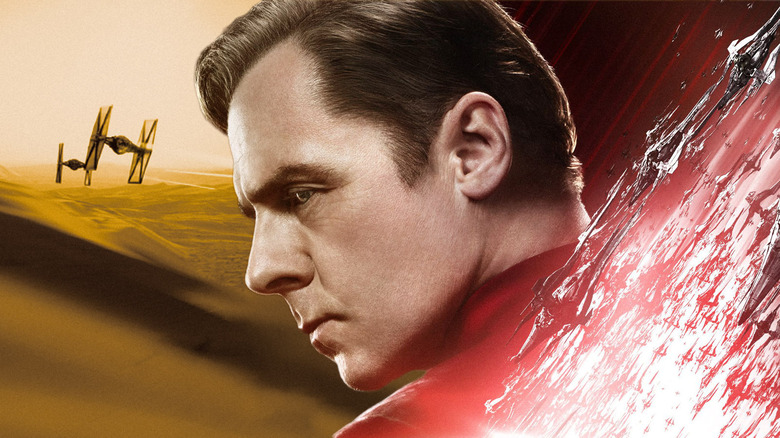
The rivalry is as old as the hills: Is " Star Trek " superior to "Star Wars" or vice versa? While one is a TV show that began in the mid-1960s, and the other is a film series that didn't start until after "Trek" had been off the air for eight year, a schism arose in fandom, pitting the two against one another — perhaps inspired by nothing more than their shared genre, mutual popularity, and similar titles.
One can argue whether or not this rivalry is warranted at all (the arguments are as old as the rivalry; one is sci-fi, the other sci-fantasy. One is speculative fiction about the future, the other is nostalgia for the distant past, etc.), but the rivalry has certainly — often playfully — been in place for decades, creating something of a mental divide between the two. There will be no interaction between the actors and creatives working on the two projects. George Lucas simply cannot direct an episode of "Star Trek," and William Shatner is forbidden from approaching "Star Wars."
Imagine the cognitive dissonance, then, created by the announcement of J.J. Abrams being hired to direct "Star Wars: The Force Awakens" in 2014 ... only a few years after completing "Star Trek Into Darkness." There's no logical way to argue that this felt like an injustice, but for many it felt like an ineffable line had been crossed. Abrams was violating the unwritten rule that "Trek" and "Wars" remain ever separated.
Of course, for those paying attention, multiple actors had been crossing that line for years. Here are all the actors who have appeared in both the "Star Trek" and "Star Wars" franchises.
George Takei
The most notable "Star Trek" luminary to cross over into "Star Wars" (and most of the actors on this list began in "Trek," moving to "Wars" later) was none other than George Takei, the helmsman of the U.S.S. Enterprise starting in 1966. Takei voiced a character named Lok Durd in a 2009 episode of "Star Wars: The Clone Wars." Lok Durd was a Neimoidian general who served as part of a separatist android army, was captured in a skirmish, but managed to escape and continue a campaign of malfeasance. Lok Durd also invented a weapon called a Defoliator that could destroy organic life, but leave the androids unharmed.
While Takei has played a whole range of roles in his career, Lok Durd appears to be one of the few over-the-top villains Takei has been allowed to sink his teeth into. Takei was asked about working on "Star Wars" by CBR in 2009, and argued that "Star Trek," being about diversity, would a relationship with "Star Wars:"
"Well, I guess I'm the only actor associated with ' Star Trek' to have done anything with ' Star Wars ,' but I don't consider it jumping ship. You know, the ' Star Trek' philosophy is to embrace the diversity of life and ' Star Wars' is a part of that diversity ... [W]ith the episodes of 'Star Wars: The Clone Wars' that I worked on, I think there is a merging there. It does deal philosophically with certain issues of the time, which is what 'Star Trek' was known for. War and peace, technology and humanity, sacrifice and courage, these issues I found engaging."
Brent Spiner
Brent Spiner is one of the more prolific "Star Trek" actors, having played Data on " Star Trek: The Next Generation ," but also different models of Data (his evil twin Lore, his prototype B-4) as well as Data's creator, Dr. Noonien Soong. Thanks to "Star Trek: Enterprise" and "Star Trek: Picard," Spiner has played various ancestors and descendants of Soong as well. Spiner has been a mite ambivalent about "Star Trek" over the years: loving that he got to play such an excellent character, but sometimes bristling at being shouldered with it as well.
In the animated TV series "Star Wars Rebels," Spiner played a politician in exile named Gall Trayvis: a noble senator who initially spoke out against the evils of the rising Empire ... until it was revealed he was an Imperial spy who took a great deal of glee in the suffering of the Rebels. Like all good villains, he was also a coward.
Perhaps because "Star Trek" (at least ostensibly) takes place in a morally complex universe, largely absent of "heroes" and "villains" in the archetypal sense, perhaps it was appealing for a "Trek" actor to let loose and be cartoonishly evil. Both Takei and Spiner played villains in the "Star Wars" universe, which has to be enjoyable after playing tied-up, uniform-wearing diplomats.
Ethan Phillips
The final "central" "Star Trek" cast member to have made the move into the "Star Wars" world is Ethan Phillips, better known to Trekkies as Neelix on "Star Trek: Voyager." Neelix was a friendly, hobbit-like person who was brought onto the U.S.S. Enterprise as an ambassador and mess hall chief. "Voyager's" writers often pulled Neelix in two directions, alternately making him a comic relief character, and a deeply tragic figure who lost family in the war. Apart from Neelix, Phillips also appeared on an episode of "Enterprise" as a Ferengi.
Ethan Phillips has voiced multiple roles in "Star Wars," all in video games attached to the franchise. He played a character named Hammam Flatt in "Star Wars: Force Commander," several parts in "Star Wars: Galactic Battlegrounds," and others in "Star Wars: Knights of the Old Republic." After having to be buried in Tallaxian makeup (including false teeth) on "Voyager" for seven full seasons, one can sense Phillips' sigh of relief having to do all of his acting in a recording booth, sans makeup.
Simon Pegg's appearance in both "Star Trek" (2009) and " Star Wars: The Force Awakens " probably came about because director Abrams liked working with the actor. Stepping into the role originated by James Doohan in 1966, Pegg played the Kelvin timeline's iteration of Scotty, the acerbic and peeved engineer aboard the U.S.S. Enterprise, bringing to the role a wry sense of humor along with some comedic exasperation. Pegg, famously a sci-fi nerd, was happy to play the role and would go on to co-write "Star Trek Beyond."
Appearing only briefly in "Star Wars: The Force Awakens," Pegg was cast as a junk trader named Unkar Plutt who ends up selling out the character of Rey to the First Order. Pegg voiced the character, but it was largely a CGI creation based on his movements. This is another case of an actor starting on "Trek" as a noble character, then moving to "Wars" as a wicked one.
Clive Revill
In the case of actor Clive Revill, he was known for a broader, enormous career outside of both "Star Trek" and "Star Wars." Revill, an actor from New Zealand, had an impressive résumé full of British productions and had been nominated for a Golden Globe for his performance in Billy Wilder's "Avanti!" He was also nominated for two Tonys in the 1960s, for "Oliver!" (in which he played Fagin) and for "Irma La Douce." He worked with the Royal Shakespeare Company, appeared on "Columbo," and played various roles on "Alvin and the Chipmunks." Revill, still kicking at 92, is an actor's actor.
In 1980, Revill provided a small amount of voice work in "The Empire Strikes Back," a sequel to " The Star Wars Holiday Special ." In "Empire," Revill voiced the evil Emperor (not yet named in 1980), dubbing over uncredited actress Marjorie Eaton, who wore a cloak and sported scary "monster" eyes. Revill and Eaton would both eventually be replaced in the 2004 remastering of "The Empire Strikes Back" by Ian McDiarmid (who played the role in "Return of the Jedi").
Revill went on to play a notable comedic part in an episode of "Star Trek: The Next Generation" wherein Picard and the crew are magically teleported into Sherwood Forest and find themselves playing the roles of Robin Hood and his Merry Men. Revill, in a poetic piece of casting, would play the wicked Sheriff of Nottingham.
Patty Maloney
And speaking of " The Star Wars Holiday Special ," the Steve Binder-directed 1978 TV movie, and direct canonical sequel to the hit film a year previous, remains one of the most grating and terrible pieces of trash in TV history. In it, Chewbacca the Wookiee — essentially a space sasquatch — must return home to his family of sasquatches in time for Life Day, the closest "Star Wars" analogue to Christmas.
Chewbacca's son is a creature named Lumpy (the "Star Wars" tie-in novel "Aftermath: Empire's End" revealed that his full name is Lumpawaroo) who liked to watch holographic Cirque du Soleil performances and bad TV shows. Lumpy was played by actress Patty Maloney, perhaps best known for the Sid and Marty Krofft series "Far Out Space Nuts." Lumpy, however, only spoke the Wookiee language, so Maloney's voice was not used.
Maloney would go on to star in the best episode of "Star Trek: Voyager," called "The Thaw." In it, the Voyager crew had to project their consciousnesses into a computer simulation where a manifestation of fear (played by Michael McKean) had taken over the world with his army of scary carnival performers. Maloney was one of the members of Fear's retinue.
One could perhaps argue that both of Maloney's "Trek" and "Wars" roles are equally terrifying.
Fionnula Flanagan
Irish actress Fionnula Flanagan started in film in the 1960s with an adaptation of James Joyce's "Ulysses," and had already appeared in high-profile American TV shows like "Gunsmoke" and "Bonanza" — also winning Emmys for "Rich Man, Poor Man" and "How the West Was Won" — before becoming involved in "Star Wars" in 1984. In " Caravan of Courage: An Ewok Adventure ," Flanagan played Catarine Towani, a survivor of a crashed spaceship who ended up in the care of Endor's Ewoks: a species of primitive teddy bear-like aliens last seen in "Return of the Jedi." Catarine would eventually be captured by a minotaur-like creature, but heroically freed by her children Cindel and Mace. In a horrid gut punch, Catarine is mortally wounded right at the film's conclusion.
Flanagan is also Data's mom on "Star Trek." Well, sort of. Data's creator, Dr. Soong, had a wife name Juliana Tainer who died, and whom he replaced with an android counterpart. The episode "Inheritence" is about Data finding about how extensive his family really was. Flanagan would also play a Vulcan ambassador in an episode of "Enterprise," which is a dramatic shift away from the matronly roles she played in both "Trek" and "Wars." Adventure mom, to android mom, to emotionless diplomat. I suppose that could be "motherly" as well; Moms are allowed to be emotionless diplomats.
Jason Wingreen and Ed Begley, Jr.
Another victim of Lucasfilm's tinkering with the "Star Wars" movies after the fact was actor Jason Wingreen, who played the voice of the mysterious, helmeted bounty hunter Boba Fett in "The Star Wars Holiday Special," in "The Empire Strikes Back, " and in "Return of the Jedi." In the prequel films that followed, the character was recast with actor Temuera Morrison, who would replace Wingreen's vocals in 2004 — but Wingreen can still lay claim to the character.
Prior to "Star Wars," however, Wingreen's face can be seen in the original series "Star Trek" episode "The Empath," a third-season cheapie wherein Kirk, Spock, and McCoy are tortured by aliens on an avant-garde theater set. Wingreen played a doctor who was trapped in a tube-like prison. Not a huge role and, according to an interview in StarTrek.com , one he didn't even remember shooting, but a "Trek" role nonetheless.
Boba Fett's voice was also once provided by actor Ed Begley, Jr. in a (relatively obscure) 1996 audio adaptation of "Return of the Jedi," a piece of media for deep-cut Starwoids. Begley, as fans of "Star Trek: Voyager" know, also played a Bill Gates-like supervillain in a two-part time travel episode called "Future's End" wherein a computer impresario was stealing 29th-century technology to invent dial-up internet. Yes, that is real. Both villains, I suppose, but Bill Gates and Boba Fett are very, very different characters. Only one, for instance, has a charity foundation.
Felix Silla
The amazing Felix Silla has an impressive list of roles on his résumé. He played Cousin Itt on "The Addams Family." He played Twiki on "Buck Rogers in the 25th Century," he was a stunt double for the character of Short Round in "Indiana Jones and the Temple of Doom" (he was an extensive stunt performer, often standing in for child characters), and if you've ever seen the bonkers 1975 "Maltese Falcon" spoof "The Black Bird," you'll have seen him play the character of Litvak, a gnashing, hilarious Nazi villain.
Silla, having such a broad variety of roles, perhaps inevitably would appear in both "Star Trek" and "Star Wars." In the former, he played one of the creepy psychic Talosians who imprisoned Capt. Pike in the original Trek pilot "The Cage." He had no lines, but a lot of menace. Silla likewise had no lines in "Return of the Jedi," wherein he played one of the many Ewok characters. Specifically, Silla played an Ewok who flew a hang glider.
Prior to films, Silla also worked in an Italian circus as a horseback rider and trapeze artist. In short, you want to know this man's biography.
Ron Perlman
Who could forget " Star Trek: Nemesis ?" As it turns out, most people. Released in 2002, it was one of the least successful "Trek" movies, and indicated that the franchise was, after a glorious 15-year heyday, finally on the wane.
"Nemesis" was about a clone of Picard's (played by Tom Hardy) who instigates a revolution of Remans against their oppressors, the Romulans. The Remans have an orc-like appearance and can read minds through touch. Picard's clone had an unnamed right-hand henchman Reman viceroy, played by the glorious Ron Perlman . Perlman is no stranger to the makeup chair, having played animals and creatures in many iterations (he was in the "Beauty and the Beast" TV series, "The Island of Dr. Moreau," and he was Hellboy), so appearing as an alien orc was right in his wheelhouse.
In "Star Wars: The Clone Wars," Perlman voiced a character named Gha Nachkt, a big-mouthed goblin creature of the Trandoshan species (thank you Wookieepedia). Gha Nachkt was a feckless trader who found R2-D2 on a derelict Rebel vessel, hid the droid from Anakin Skywalker, and tried to con General Grievous out of some cash. Gha was murdered for his trouble. Perlman typically plays strong or imposing characters, so it's a delight to see him play someone a little more sniveling.
Ian Abercrombie
Another character-actor-about-town is Ian Abercrombie, whom " Seinfeld " fans might recall as Mr. Pitt, Elaine's boss. " Army of Darkness " fans will recognize him as the Wise Man . Fans of the 2002 "Birds of Prey" TV series (who are legion) will know him as Alfred, Batman's butler. Those with a keen ear, however, might recognize his voice from the 2008 animated feature film "Star Wars: The Clone Wars." Abercrombie played the role of Senator Palpatine, prior to his becoming the evil Emperor, and played the part up until his death in 2012. He was replaced by Tim Curry.
Over in the Delta quadrant, meanwhile, Abercrombie appeared in two episodes of "Star Trek: Voyager." In the fifth season, he was in an episode entitled "Someone To Watch Over Me," where he played the stern Abbot, overseeing a visiting alien who is going a little overboard with hedonism (the visiting alien is played by "Kids in the Hall" star Scott Thompson). In the sixth season episode "Spirit Folk," Abercrobie plays an Irish drunk. Whether his character was evil, stern, or broadly comedic, Abercrombie nailed it.
Olivia D'Abo
In the sixth season episode of "Star Trek: The Next Generation," called "True Q," Olivia D'Abo played a Starfleet intern who is on board to acquire some field experience on a real starship. The omnipotent prankster Q (John de Lancie) then appears to her and tells her that, while she was raised as a human, she's actually a Q herself and is now ready to join the ranks of enlightened trickster gods. As one might, she is reluctant to give up being a human at the drop of a hat and tests out her godlike powers first; she cheats on tests and tries to kidnap her crush, Cmdr. Riker. D'Abo is sweet in the role, playing an inexperienced youngster on a show full of stuffy adults.
"Star Wars: The Clone Wars" gave many Trek actors a chance to infiltrate "the other side," and D'Abo appeared on the show in 2008 playing Luminara Unduli, a background Jedi character previously played by Mary Oyaya in " Star Wars: Episode II – Attack of the Clones ." Luminara was known for her skill as a swordfighter and the strength of her mind powers. Perhaps not too much a stretch from playing a Q. The main difference being one is an inexperienced god, the other an experienced mortal. There's a metaphor somewhere in there about meeting in the middle.
David Birney
It's possible that more actors have played Darth Vader within a single continuity, within a single entertainment franchise than any other character. Several actors have worn the suit, others have played him at different ages, and multiple people have provided his voice. In the same 1996 " Return of the Jedi " radio drama listed above (the one wherein Ed Begley, Jr. played Boba Fett), Irish actor David Birney played the voice of Darth Vader, bringing a new kind of menace to the role. That audio drama, by the way, is far more in keeping with "Star Wars'" pulpy spirit than any of the movies made after 1980.
Birney was also on "Star Trek: Deep Space Nine," in the sixth season finale "Tears of the Prophets." By that point on "DS9," a full-fledged war had broken out, and many, many new characters — generals, soldiers, politicians and the like — began appearing on the show. Birney played a Romulan senator named Letant. While Darth Vader is a notable cinema villain, Romulans aren't slouches and Birney could draw from one to play the other.
Birney passed away in April of this year.
George Coe played a notable role in one of the better episodes of " Star Trek: The Next Generation ," titled "First Contact" (not to be confused with the feature film). In the episode, Cmdr. Riker had disguised himself and infiltrated a species that was on the cusp of inventing warp drive (an event in "Star Trek" that allows starship-controlling species to make contact). Riker gets found out, however, and Starfleet's first contact doesn't go so well. Coe plays the president of the planet in question, and he has some legitimate, intelligent concerns when he finds out about the aliens on his homeworld. The discussions he has with Picard are pure "Trek."
Coe was also one of the many actors who snuck in the back door of "Star Wars: The Clone Wars," playing a spindly sloth-like alien named Tee Watt Kaa. Although a "Star Wars" character, Tee Watt Kaa was — in "Trek" tradition — a pacifist who refused to fight. This becomes difficult when an evil Neimoidian — OMG, is that Lok Durd played by George Takei? — invades his village. By the end of the episode, Lok Durd is fought off, but Tee Watt Kaa understood that conquering came at a price.
Both roles question the fundamental ideas behind their respective franchises. One might wonder if Coe had considered that.
Brian George
Brain George is another actor one might recognize from "Seinfeld," having played the character of Babu Bhatt, owner of the Dream Café, whose life is casually ruined by the title character. George appeared on " Star Trek: Deep Space Nine " as Dr. Bashir's father, a doting man who pressured his son to succeed. Also, Dr. Bashir was secretly genetically engineered (illegal in "Star Trek"), leading to additional conflict between the two.
George would also play the animated "The Clone Wars" version of Ki-Adi-Mundi, a cone-headed Jedi council member first seen in "Star Wars: Episode I — The Phantom Meance," played by actor Silas Carson (who also played various other aliens throughout the "Star Wars" prequel films). Ki-Adi-Mundi is ... a Jedi. He ... talks about diplomacy. He is ... stoic? One must admit that Ki-Adi-Mindi isn't much of a character, at least not as far as the feature films go.
Greg Grunberg
If you need a bearded engineer type to look sternly over the planned actions of a deathly serious upcoming skirmish, Greg Grunberg is your guy. Grunberg started his career with the stellar straight-to-video horror/smut film "Witchcraft V: Dance with the Devil," though he may be better known for his role as psychic cop Matt Parkman in "Heroes." He's also worked with J.J. Abrams on a number of occasions, including his regular role in the TV series "Felicity" and his brief role as an ill-fated pilot in "Lost."
Being in Abrams' camp is likely what led to Grunberg's roles in both his "Star Trek" and his "Star Wars" movies In "The Force Awakens," "The Last Jedi," and "The Rise of Skywalker," Grunberg played a character named Temmin "Snap" Wexley, a serious engineer of some kind. In Abrams' "Star Trek," Grunberg played the voice of James T. Kirk's stepfather. The original actor, Brad William Henke, was cut from the film, and Abrams brought in Grunberg to fill in Henke's lines in post-production.
It counts! It counts!
Another long-time actor in Hollywood with a fascinating acting career, Deep Roy has been a stunt performer and actor since the 1970s. He served as the stunt performer for Warwick Davis in "Leprechaun." One of his early roles was playing a stand-in for Yoda in "The Empire Strikes Back," and one can find amusing behind-the-scenes photos of Roy getting into the Yoda costume. Roy would also play the weird-looking musician Droopy McCool, a.k.a. Snit, a member of the Max Rebo Band. Oh and an Ewok. He also played an Ewok. It is unknown if Deep Roy, Felix Silla, and Warwick Davis ever conversed in their Ewok costumes.
Roy would also play the mute engineer Keenser, a co-worker of Scotty's, in the 2009 "Star Trek" film. Given Roy's plaintive looks at Scotty, one might posit that he was in love with his friend. Their romance, sadly, is never explored.
Roy frequently plays silent characters, although he was given a magnificent acting challenge in Tim Burton's film "Charlie and the Chocolate Factory," wherein he played every single Oompah-Loompah.

- View history
The Klingons ( tlhIngan in Klingonese ) were a humanoid warrior species that originated from the planet Qo'noS (pronounced Kronos ), an M-class planet in the Beta Quadrant . One of the major powers of the galaxy , the Klingons were a proud, tradition-bound people who valued honor and combat. The aggressive Klingon culture had made them an interstellar military power to be respected and feared.
- 1.1 Parallel universes
- 3.1 Origins
- 3.2.1 Anatomy
- 3.2.2 Augment virus
- 3.2.3 Hybridization
- 3.2.4 Physiology
- 4 Religion and tradition
- 5 Science and education
- 6.1 See also
- 8 Klingon space
- 9 Food and beverages
- 10.1 Appearances
- 10.2 Background information
- 10.3 Apocrypha
- 10.4 External links
History and politics [ ]
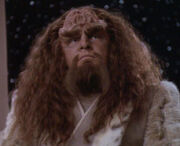
A clone of Emperor Kahless
Recorded history begins with the story of the creation of Kortar and his mate , who were recognized as the first Klingons. Together they were responsible for destroying the gods who created them. ( VOY : " Barge of the Dead ")
Kahless the Unforgettable founded the Klingon Empire some time in the 9th century through the performance of many heroic feats. He unified the Klingon people when he killed the tyrant Molor . Kahless came to be revered in Klingon society to the point of near-deification, and many aspects of Klingon culture came to revolve around an emulation of Kahless' life. ( TNG : " Rightful Heir ")
The warrior ethos had been an important aspect of Klingon society since the time of Kahless, but the warrior aspects became much more dominant beginning in the early 22nd century . Over time, the warrior caste gained greater prominence to the point where the Klingons widely came to be regarded as a "warrior race." ( ENT : " Broken Bow ", " Judgment ")
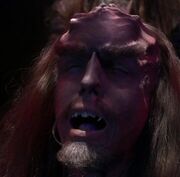
A Klingon's cranial ridges dissolving
The Klingons' relationship with Humans and the Federation was rocky at best. Following the disastrous first contact between the two species during in the Broken Bow Incident , tense rivalries and unavoidable conflicts often developed between the two races. ( ENT : " Broken Bow "; TNG : " First Contact ") In the year 2154 , the Klingons gained access to the genetic material of Human Augments and tried to adapt this genetic engineering to improve themselves. The test subjects did gain increased strength and intelligence, but then, their neural pathways started to degrade and they died in agony. One of the subjects suffered from the Levodian flu , which was modified by the Augment DNA to become a fatal, airborne, mutagenic plague that spread rampantly through the Empire, from world to world. In the first stage of this plague , Klingons lost the ridges on their foreheads and began to look more Human. With the help of a Klingon scientist named Antaak , Dr. Phlox of the Earth starship Enterprise was able, using the DNA of Captain Archer , to formulate a cure that halted the genetic effects of the virus in the first stage. This retained the changes in appearance, along with some minor neural re-ordering. The neural ordering caused changes in the emotional make-up of the Klingons. For example, the infected started to feel fear. Even though the infected did not develop any stage-two characteristics – such as enhanced strength, speed, or endurance – they did not die from it. This left millions of Klingons changed. These alterations were even passed on to their children. ( ENT : " Affliction ", " Divergence ")
In the 2250s and 2260s , groups of Klingons with and without ridges had been encountered by the Federation. ( DIS : " The Vulcan Hello "; TOS : " Errand of Mercy ") By the 2270s it had become more commonplace to encounter Klingons with forehead ridges than not. ( Star Trek: The Motion Picture , et al.) Klingons did not discuss the circumstances of this mutation with outsiders and, by the 24th century , the reason for smooth-forehead Klingons was not widely known outside the Empire. ( ENT : " Affliction ", " Divergence "; DS9 : " Trials and Tribble-ations ")
By 2223 , relations between the Federation and the Klingon Empire degenerated to a point of relentless hostility, which lasted for several decades. ( Star Trek VI: The Undiscovered Country ; TNG : " First Contact ")
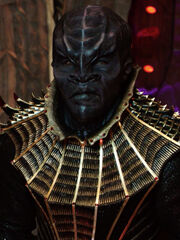
T'Kuvma , a Klingon leader in 2256
The lingering tensions between Klingons and Humans continued to rise, eventually leading to the Battle of Donatu V , near Sherman's Planet in 2245 and the Battle of the Binary Stars in 2256 , which was provoked by T'Kuvma in order to unite the squabbling Great Houses against the Federation. ( TOS : " The Trouble with Tribbles "; DIS : " Battle at the Binary Stars ") This resulted in the first Federation-Klingon War , where the Klingon Empire successfully invaded and occupied nearly twenty percent of Federation space. ( DIS : " The War Without, The War Within ")
Later, another conflict erupted into the Federation-Klingon War of 2267 . The Organians quickly intervened and ended the war after only four days of fighting. ( TOS : " The Trouble with Tribbles ", " Errand of Mercy ") Over the next several decades an uneasy peace developed, broken only by brief but fierce skirmishes and conflicts. ( Star Trek III: The Search for Spock ; Star Trek V: The Final Frontier ) A true and lasting peace finally came in 2293 , with the signing of the Khitomer Accords , thanks to the efforts of Chancellor Gorkon and the Human Starfleet officer James T. Kirk . ( Star Trek VI: The Undiscovered Country ; TNG : " Unification II "; VOY : " Flashback "; DS9 : " You Are Cordially Invited ") Since then, despite several periods of rocky relations (see Federation-Klingon War (2372-73) ), the Federation and the Klingon Empire have been steadfast allies, especially in the face of Dominion aggression in the 2370s . ( DS9 : " The Way of the Warrior ", " By Inferno's Light ")
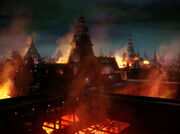
Qo'noS on fire during the Civil War
The Klingon relationship with the Romulan people was extremely erratic. The Klingons typically regarded the Romulan Star Empire as a "blood enemy" since at least the 23rd century . Sporadic Romulan attacks against Klingon colonies , such as the Khitomer Massacre , and interference in Klingon affairs, including the Klingon Civil War , continued to sour relations between the two peoples. ( TOS : " The Enterprise Incident "; TNG : " The Neutral Zone ", " The Enemy ", " Sins of The Father ", " Redemption II ")
Parallel universes [ ]
In the mirror universe , the Klingons were one of the races subjugated by the Terran Empire . ( DIS : " Vaulting Ambition ") By the 24th century Klingons and Cardassians founded the Klingon-Cardassian Alliance and eventually defeated their Terran occupiers. ( DS9 : " Crossover ")
In the alternate reality , in 2233 , the crew of the USS Kelvin briefly considered whether a particular lightning storm effect, observed by the Kelvin near the edge of Klingon space, might be Klingon in origin. Starfleet discarded this possibility. The phenomenon preceded the arrival of the Romulan mining vessel Narada from the prime universe . The Narada attacked and obliterated an armada of 47 Klingon warbirds in 2258 . ( Star Trek )
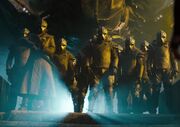
Klingon patrol officers
By 2259 in the alternate reality, after Starfleet's first contact with the Empire, the Klingons had conquered and occupied two planets known to the Federation and fired on Starfleet ships half a dozen times. Tensions between the two powers were high and an all-out war was considered inevitable. During that year, before surrendering to the Federation, Khan Noonien Singh destroyed three D4-class patrol ships on the Klingon homeworld, killing the crews of the vessels. ( Star Trek Into Darkness )
According to Daniels , the Klingons joined the Federation by the 26th century in one possible timeline. ( ENT : " Azati Prime ")
Society [ ]
Klingon society was extremely complex. Before its decline in the mid-22nd century and again in the late 23rd century, Klingon society was based on a feudal system organized around traditional Great Houses of noble lineage, to which various parts of the population owed fealty. The Great Houses are traditionally represented in the Klingon High Council , which was led by a Chancellor , replacing the heredity leader of Emperor .
The decline of Klingon culture was demonstrated in the acts of the Klingons themselves. They stopped caring about their weapons to the point that they let them rust and even stopped caring for true honor. ( ENT : " Marauders ", " Judgment ") Sometime after the augment virus took hold of the Klingon Empire , a new regime took control, turning the Empire into an authoritarian state that kept tabs on all who served. ( DIS : " Battle at the Binary Stars "; TOS : " Errand of Mercy ") The old ways returned in the latter 23rd and early 24th centuries respectively.
Males traditionally dominated public life in the Empire, assuming the leading roles in politics and the military with only rare exceptions. ( TNG : " Redemption ") There were three notable exceptions to the prohibition of women serving on the High Council. In 2257 L'Rell rose to High Chancellor and Dennas served on the High Council. The third instance occurred in 2293 when Azetbur became Chancellor of the High Council after her father, Gorkon, was assassinated ( Star Trek VI: The Undiscovered Country ). Women traditionally dominated the household and the management of the family's affairs. ( DS9 : " You Are Cordially Invited ") Klingon women were treated as equals, except in politics and matters of inheritance. Law prohibited them from serving in the High Council and they could not take control of their Houses unless they had the money and no male successors of the lineage. Otherwise, Klingon women were expected to exhibit the same physical prowess and lust for blood and honor as the men.
Klingon society functioned through a system of family reputation and honor. Tradition was an integral part of their lives and breaking from observances was considered a grievous insult to society, an insult not forgotten easily. An offense usually brought shame to the offender's name for several generations. The highest shame was discommendation , an action by the High Council to officially strip a Klingon of his personal or family honor. Bloodlines and relations were also taken very seriously by any "true" Klingon. Lines comprised more than mere family members. ( TNG : " New Ground ")
The military was integral to Klingon society, as it provides opportunities for warriors to die in battle. For the same purpose, the Empire often seeks to expand through conquest. Discipline was strictly enforced, by one's superiors and subordinates both; the latter may assassinate his superior and take his place. This gives Humans the false impression that there are no rules, but in fact, this can be done only under certain conditions, dereliction of duty and cowardice among them, and the challenge can be made only to a direct superior. ( TNG : " A Matter Of Honor ", " Sins of The Father ")
An integral part of tradition was the various rituals that marked milestones in a Klingon's life or the history of the Empire. Most notable of the rites was the Rite of Succession , which a future leader of the Empire had to complete with a valid Arbiter of Succession ( Captain Jean-Luc Picard , in the case of Gowron ) overseeing the proceedings. Before the Rite could begin, there was another elaborate ceremony needed to confirm the death of the previous leader. This was known as the Sonchi ceremony . ( TNG : " Reunion ") Individual Klingon warriors were expected to go through the Rite of Ascension to be recognized as a full adult. ( TNG : " The Icarus Factor ") If the house that an individual Klingon belonged to was dissolved or fell into dishonor, he could be adopted into another house through the R'uustai or alternative ceremonies that symbolically marked the joining of kinship and allegiance. ( TNG : " The Bonding "; DS9 : " Sons of Mogh ", " Soldiers of the Empire ", " Sons and Daughters "). The Right of Vengeance , allowed Klingons to seek redress for the deaths of their family members by engaging the one responsible in single combat. The right was so important, that even the discommended could claim it against important political figures, as the discommended Worf was able to challenge Duras (a candidate for the title of Chancellor. ( TNG : " Reunion ")
Klingons were extremely territorial. According to the first known Klingon linguist, there was no such thing as an "insignificant corner of Klingon space". ( ENT : " Bounty ")
Evolution [ ]
Origins [ ].
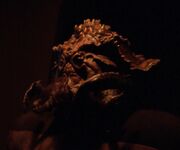
Worf's transformation into a de-evolved Klingon
Like their Human, Cardassian , Vulcan , and Romulan counterparts, Klingons and many of the Milky Way's species all shared a common ancestry back to the ancient humanoids and the DNA code they produced and seeded across the galaxy. Though each evolved under separate conditions from each other, their shared DNA allowed these species to remain roughly compatible and viable with each other. ( TNG : " The Chase ", " Genesis "; VOY : " Distant Origin ", " Threshold ")
Possessing extreme strength and speed, early Klingons were quite large, weighing up to 200 kilograms . They were armored with an exoskeleton , with spines and bony plates protruding from their sides, upper arms, and back, arms ended with clawed pincers. On their face were venom sacs , filled with bio-acidic compound and spitting glands inside their mouth that were used for defense and to mark territory. Along with these sacs, these early Klingons had two mandibles protruded from their lower jaw. ( TNG : " Genesis ")
These prehistoric males used vocalizations to frighten other predators , mark its territory, and commence its mating process. These early Klingons mating rituals involving biting its intended mate, to induce pheromone production in the sebaceous glands . Once the mate was ready, the pheromones drew the male Klingon back to its location. ( TNG : " Genesis ")
The Modern Warrior [ ]
Modern Klingons developed a varied line of physical attributes, ranging from well pronounced cranial ridges to what was best described with the dysphemism "pointy-headed", as coined by Harry Mudd .
Anatomy [ ]
Like most humanoids, the essence of the Klingon anatomical form consisted of a head , neck , torso , and four limbs .
Internally, the Klingon anatomy was markedly different from that of other humanoids. There was a great deal more multiple redundancies in their organs, a principle they called brak'lul . This allowed Klingons to survive severe injuries in battle. They had twenty-three ribs , two livers , an eight-chambered heart , three lungs , two urinary tracts , and even redundant neural function as well as multiple stomachs . Some geneticists believed that the extra organs, notably the third lung, evolved to give Klingons greater stamina on the battlefield. Klingons had relatively little knowledge of their own biology and their medicine was very poorly developed. This was largely due to their warrior traditions – a Klingon who was wounded was expected to be left to either survive through his own strength, die, or undergo the hegh'bat , a form of ritual suicide. ( TNG : " Ethics "; VOY : " Lineage "; DIS : " Will You Take My Hand? ") Conversely, their society having dueled and killed each other for generations taught them what is immediately lethal for their species. ( TNG : " Reunion "; DS9 : " Tacking Into the Wind ")
The most distinctive feature of the modern Klingon was a sagittal crest, beginning on the forehead and often continuing over the skull. ( Star Trek: The Motion Picture , et al.) Klingons head shape differed between individuals, with some having skulls that extended backwards into an elongated cone shape. ( DIS : " The Vulcan Hello ", " Choose Your Pain ", " Magic to Make the Sanest Man Go Mad ") The cranium, itself, was encased in an exoskeleton, which possessed a feature known as the tricipital lobe . ( TNG : " Descent ")
The lower half of the face tended to follow a familiar humanoid appearance, and even the ridges on the back of their heads if any tend to be less pronounced and slight, leaving the general shape as Human skull and covered in more skin than bone (see Chang for example), it was in these regions where hair was most likely seen to grow. Eyebrows tend to grow in a more diagonal direction than other humanoids, but also had noticeably diagonal suborbital ridges where eyebrows otherwise existed.
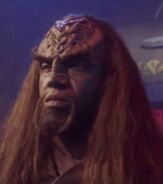
Klingons ears included both external auricle and pinna and recessed pinna. External auricle structures tended to be rounded, and the recessed pinna tended to come to a point before forming into the back of the head, Klingons of the alternate reality had pointed auricles of a similar size and shape to the recessed pinna, with slight ridges along the top. ( Star Trek Into Darkness )

Klingon eye
Klingon eyes were generally round in size and shape (consisting of varying shades with white sclera). They may flash more white of their eyes which they use to intimidate a rival or enemy. ( TNG : " Reunion "; DS9 : " Tacking Into the Wind ") Other Klingon eyes had large corneas, pink sclera, and almost gem-like reflective quality to them. ( DIS : " The Vulcan Hello ", et al.) Klingons, especially females, were said to lack tear ducts . ( Star Trek VI: The Undiscovered Country ) However, for males Klingon myth stated that Kahless once filled the ocean with his tears, and at least one Klingon, Kurn , produced tears. ( TNG : " Birthright, Part II "; DS9 : " Sons of Mogh ")
They also had more physically pronounced cheeks, and a vertical ridge that went down their chin into their neck which expanded into ridges on their upper chest and shoulders and between the breasts of at least the females. The neck structure varied from smooth flesh to flesh containing pits and bony structures that led up the side of their head, and down the back of their head and spine.

Klingon nose
Klingon noses tended to vary having between several slight horizontal ridges on the brow of their noses, or a single vertical ridge or crack from the top of the brow to the tip of the nose to being wider and flatter, nearly flush against the forehead. They also had heavier ridges over their nostrils, compared to the two minimally ridged or un-ridged nostrils. The nose tended to lay flatter on the face than in other Klingons as well and wider. ( TNG : " Heart of Glory "; DIS : " The Vulcan Hello ")
Klingon teeth typically consisted of two sharp fangs (incisors) with crooked or sharpened teeth (it was said they sharpen their teeth, often before going into battle). ( VOY : " Unimatrix Zero "; ENT : " Broken Bow "; DS9 : " Apocalypse Rising ") However, not exclusive, others had pronounced thick lips with sharp teeth, with each tooth being considerably larger size. ( DIS : " The Vulcan Hello ", et al.)
Klingons of both sexes usually had hair on their heads while male Klingons often had facial hair as well. ( TOS : " Day of the Dove "; TNG : " Redemption ") Hair was usually long, curly and wavy, described as thick and luxuriant. ( TNG : " Schisms ") Accelerated hair growth was often experienced by Klingons during puberty, or jak'tahla , along with severe mood swings and unusual aggressive tendencies. ( Star Trek: Insurrection ) Klingon hair greyed with age. ( DS9 : " You Are Cordially Invited ") Other Klingons were completely bald , lacking facial hair. ( DIS : " The Vulcan Hello ", et al.) For Klingons with hair, cases of receding hairlines or full or partial baldness existed during 2160s , and later in the 2260s through 2290s ( Star Trek: The Motion Picture ; Star Trek VI: The Undiscovered Country ; Star Trek Into Darkness ; ENT : " Divergence "; TOS : " The Trouble with Tribbles ", " Day of the Dove "; DS9 : " Trials and Tribble-ations ") Klingons as young as those who had reached the Age of Ascension , typically did not wear beards. ( TNG : " Birthright, Part II "; DS9 : " Sons and Daughters ", " You Are Cordially Invited ", " Penumbra ") Klingons of the alternate reality vary from balding and no facial hair, to those with long hair and beards. ( Star Trek Into Darkness )
Some Klingons also had sharp thick talons on their hands that make up the end of their digits.
The chest of the Klingon males appeared to be largely smooth and slick, while the females had a large chest area with ridges that came down to the top of their breasts across their shoulders. The backs of these Klingons were highly covered with ridges from shoulder to shoulder and across the small of their back radiating from highly defined and thickly ridged spines. The sides of the abdomen of at least the females appeared to be highly defined with rib-like ridges as well. The buttocks region was even heavily ridged. ( DIS : " The Vulcan Hello ", " Battle at the Binary Stars ", " Si Vis Pacem, Para Bellum ", " Into the Forest I Go ")
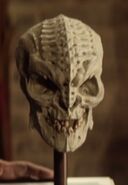
Klingons had ridged spines, chests and feet (though these ridges and other armor like structures extend out covering almost the entire back, sides and abdominal region on the 'pointy-headed' Klingons). ( TNG : " Ethics "; DS9 : " Sons of Mogh "; ENT : " Broken Bow ") After birth, some Klingon infants experienced a pronounced curvature to the spine, a form of scoliosis, which was correctable by surgery. This "defect" tended to run in Klingon families, especially among females. Federation medicine, fortunately, advanced beyond that, allowing an additional choice of treatment involving genetic modification of the fetus. ( VOY : " Lineage ")
Augment virus [ ]
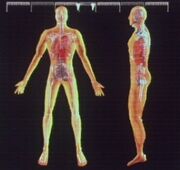
The anatomy of a Klingon male afflicted with the Augment virus
Klingons afflicted with the augment virus , propagated by a mutation of the Levodian flu was inadvertently created by Klingon researchers who were attempting to bio-engineer enhanced warriors using DNA from genetically-modified Human embryos left over from Earth 's Eugenics Wars . These Klingons lost their cranial ridge features, and were in essence, remarkably similar in appearance to modern Humans. ( ENT : " Affliction ", et al.)
Though the cure for the virus had been distributed throughout the Empire, the afflicted Klingons' DNA had been altered by the virus, and condition was passed onto the descendants of the infected. Initially there were millions of Klingons who had to live with the disfigurement for well over a century. ( ENT : " Divergence "; TOS : " Errand of Mercy ", et al.)
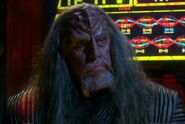
Though Human in appearance and distinguishable primarily by tricorder readings alone, Tribbles were still able to single out and identify these Klingons. ( TOS : " The Trouble with Tribbles ")
Hybridization [ ]
Klingon pregnancies normally ran thirty weeks, but with mixed species, gestation times were shorter. As early as seven weeks (at which point a Human fetus doesn't even have legs) a fetus with a single Klingon grandparent was already able to kick the uterine wall hard enough to be felt externally. ( VOY : " Lineage ") Klingons were said to have a different, not fully compatible number of reproductive organs than Humans. ( DIS : " Choose Your Pain ") However, basic anatomy does actually appear to align between Humans and Klingons. ( DIS : " Into the Forest I Go ") Whenever Klingons interbred with other species they showed characteristics of both species.
The odds against Klingon-Human conceptions were rather high. However, when successful, Klingon and Human metabolisms sometimes clashed, causing biochemical fluctuations in the mother, which may lead to fainting. Klingon traits remained dominant for several generations, even with a single ancestor; therefore, a child even ¼ Klingon still possessed forehead ridges. It is possible to see the eventual phenotype of a hybrid while the fetus is still gestating using a holographic program and projection. If early enough in development, genetic manipulation can be taken to remove Klingon DNA from the developing fetus. ( VOY : " Lineage ")
Hybridization revealed that Klingon DNA tended to be more dominantly expressive in the physical appearance of their offspring .
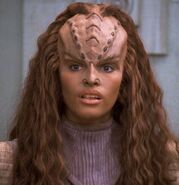
This was found to be especially true in the case of hair color and appearance of cranial ridges, especially with Humans. ( VOY : " Lineage "; TNG : " Reunion ", et al.) In the case of Romulan -Klingon hybridization, the ears were the only visible telltale indication of their non-Klingon heritage. ( TNG : " Birthright, Part II ")
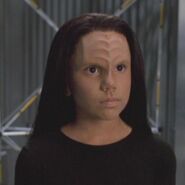
Physiology [ ]
Skin colors ranged from olive, brown, and black to pearlescent/metallic across the entire spectrum of the rainbow, varying from purple, pink, burgundy red, yellowish tan, dark orange, umber brown, grey, blue, dark green, coal black, and chalky white. Their skin had a shimmery slick metallic semi-reflective sheen to it. Albino Klingons were often considered outcasts in Klingon society. ( DIS : " Battle at the Binary Stars ")
Klingon children matured far more quickly than Human children. At the age of only one Earth year, a Klingon child had the appearance a Human child had at about four. By the age of eight Earth years, a Klingon attained the maturity a Human did not reach until about age sixteen. ( TNG : " Reunion "; DS9 : " Sons and Daughters ") Rop'ngor was a common childhood disease among Klingons. ( TNG : " Up The Long Ladder ") When Klingon children began growing into adults, they went through jak'tahla , a Klingon form of puberty. ( Star Trek: Insurrection ) Like other mammalian species, Klingon females were capable of lactating to breast-feed infants. ( TNG : " A Matter Of Honor ")
Klingons tended to live for over 150 years. Even into advanced old age, Klingons were usually still strong enough for combat, but were still susceptible to various mental conditions associated with old age. ( DS9 : " Blood Oath ", " Once More Unto the Breach ")
Klingons were notably stronger than most humanoids, at least as strong as Vulcans. They might have even been stronger, as the half-Klingon B'Elanna Torres was able to wrestle with the Vulcan Vorik on equal grounds and eventually defeat him, despite the fact that he was larger than her. However, despite their endurance and general robustness, Klingons had a considerably lower tolerance to the cold than Humans. ( VOY : " Blood Fever ", " Displaced "; DS9 : " Change of Heart ", " Take Me Out to the Holosuite ")
The Klingon sense of smell was notably acute; in fact, it was powerful enough to be used effectively to track down prey during a hunt. Their sense of smell was also suggested to play an integral role in their mating practices. ( TNG : " Birthright, Part II ", " Genesis ")
Doctor Julian Bashir once sarcastically noted that the natural odor produced by Klingons was comparable to an "earthy, peaty aroma with a touch of lilac ." ( DS9 : " Trials and Tribble-ations ") To Humans and Vulcans alike, Klingon ships smelled bad. ( Star Trek IV: The Voyage Home ; ENT : " Sleeping Dogs ") For example, Leonard McCoy once referred to the environment of a Klingon Bird-of-Prey, operated until recently by Klingons, as having a "stench." ( Star Trek IV: The Voyage Home )
Klingons such as Kurn had the instinctive ability to sense the decision to kill by looking into the eyes of their opponents. ( DS9 : " Sons of Mogh ") Worf despite being raised by Humans on Earth, retained this ability when he sensed Martok's warrior spirit returning enough to win their duel without killing Worf. ( DS9 : " Soldiers of the Empire ")

Klingon blood floating in zero gravity
Klingon blood could contain ribosomes that were compatible for transfusion with a Romulan. ( TNG : " The Enemy ") Klingon blood varied in color from dark red to more of a lightish pink. ( Star Trek VI: The Undiscovered Country , DIS : " Point of Light ")
Klingon nutritional requirements were typical of most humanoids, whereas, Dr. Pulaski once noted that, while their food was considered by most to be unpalatable, usually, "what kills us, kills them." ( TNG : " A Matter Of Honor ") One exception of this observation was the tea used in the Klingon tea ceremony , which was toxic to the point of being deadly to Humans, and capable of seriously sickening Klingons, as it did. ( TNG : " Up The Long Ladder ")
Religion and tradition [ ]
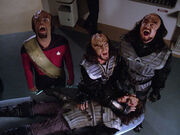
Klingon death ritual
Ritual was a very important element in Klingon society.
Klingons did not believe in fate; however, they did appear to believe in some form of luck . ( DS9 : " Rules of Engagement ", " Tears of the Prophets ")
A Klingon who was unable to fight, and hence unable to live as a warrior anymore, had the traditional obligation of committing the hegh'bat , which was the Klingon ritual suicide. Tradition dictated that the eldest son or a close personal friend must assist. That person's role was to hand the dying Klingon a knife so that he could plunge it into his heart, remove it, and then wipe the blood on his own sleeve. ( TNG : " Ethics ")
Klingon rituals included the R'uustai , a bonding ceremony which joined two people together in a relationship similar to brotherhood. ( TNG : " The Bonding ") Klingon tradition held that "the son of a Klingon is a man the day he can first hold a blade." ( TNG : " Ethics ")
If a Klingon warrior struck another Klingon with the back of his hand, it was interpreted as a challenge to the death. Klingon warriors spoke proudly to each other; they did not whisper or keep their distance. Standing far away or whispering were considered insults in Klingon society. ( DS9 : " Apocalypse Rising ")
According to Worf, taking hostages was considered by Klingons to be a cowardly act. Although, there was an incident in which a Klingon aimed his disruptor at the Enterprise-D's warp core, thus taking the ship hostage, in effect. ( TNG : " Heart of Glory ")
When choosing a mate, it was traditional for a female Klingon to bite the male's face, allowing her to taste his blood and get his scent. Males were also known to bite the face of the female they were interested in. ( VOY : " Blood Fever ", " Prophecy ", " Infinite Regress ")
A Klingon can divorce their mate by backhanding them across the face and saying “N’Gos tlhogh cha” which means “our marriage is done”. (Star Trek Adventures: “the Klingon Empire Core Rule Book)
Worf once told Wesley Crusher that, per Klingon mating rituals , " Men do not roar. Women roar. Then they hurl heavy objects. And claw at you. " Of men, Worf said, " He reads love poetry. He ducks a lot. " ( TNG : " The Dauphin ") Klingon daughters traditionally were given a piece of jewelry called a jinaq when they became old enough to select a mate. ( TNG : " Birthright, Part II ")
Long hair was important part of the ancient traditions of Klingons as told in the legend of Kahless ; it was said he took a lock of his long hair thrusting into the caldera of the volcano of Kri'stak, where it began to burn, and then after plunging it into the lake of Lusor, he molded and twisted into his legendary Sword of Kahless , which he used to kill the tyrant Molor, and then gave it the name Bat'leth, the sword of honor. ( TNG : " Rightful Heir ") To grow a beard was an ancient tradition, to Klingons in the 24th century especially it was a symbol of courage, which they were against shaving (though they were okay with a trim). Klingons did not like having too much hair removed either, letting it continue to grow, and only a little bit of trimming. ( TNG : " The Quality of Life ", " Schisms ", " Family ").
Science and education [ ]
As of the 2150s , the warrior caste had a dominant role in Klingon society, causing science and education to be neglected virtues. Nevertheless, Kolos ' father was a teacher and his mother a biologist at a university . Antaak , on the other hand, was disowned by his father when he chose to become a " healer ", i.e., a doctor. In 2149 , he was an expert in metagenic research and attended an Interspecies Medical Exchange conference, albeit in disguise, as the Klingons were not invited. By 2151 , Klingons possessed technology to encrypt intelligence data within an operative 's DNA . ( ENT : " Broken Bow ", " Judgment ", " Affliction ")
As of 2154 , medical research was not considered "a priority" for the Klingon High Council, which was why the Empire did not possess the medical expertise to confront the Augment virus without assistance . ( ENT : " Affliction ")
By the late 23rd century , the Klingon Empire sent out expeditions, one of which made first contact with the Ventaxians in 2297 . Hired Klingon craftsmen went on to construct homes on Ventax II . ( TNG : " Devil's Due ")
As of 2365 and onward, Klingon vessels had dedicated science stations . ( TNG : " A Matter Of Honor "; DS9 : " Soldiers of the Empire ")
In 2369 , Kurak was a warp field specialist from Qo'noS. While she was a brilliant expert in the field of subspace morphology , her efforts went unappreciated by her fellow Klingons. ( TNG : " Suspicions ")
Although the concept of a healer tending a warrior's wounds after a glorious battle was considered sufficiently honorable to be mentioned in songs (e.g., Dr. Bashir and Worf at Internment Camp 371 ), Klingon medical expertise kept having a bad reputation in the 24th century . In 2367 , Lt. Cmdr. Hobson of the USS Sutherland remarked that no one would ever suggest a Klingon to be a good ship's counselor , as he considered them unsuited for such a position. In 2374 , Klingon General Martok preferred to be treated by the Human Dr. Bashir, opining that "Klingons make great warriors, but terrible doctors." In 2376 , when Lewis Zimmerman was faced being treated by an "obsolete" EMH Mark I , he claimed he would be "better off being treated by a Klingon field medic ". In one particularly extreme case, the crew of Kohlar's battle cruiser , a Klingon generational ship, lived with the Nehret , a fatal virus, for over a century, without ever even considering it might be an actual illness, instead believing it was simply " old age " that kills those unlucky enough to not die in combat. ( TNG : " Redemption II "; DS9 : " By Inferno's Light ", " A Time to Stand "; VOY : " Life Line ", " Prophecy ")
In the year 2404 of an alternate timeline that diverged in 2378 , Klingon scientist Korath created the chrono deflector , a time travel device. ( VOY : " Endgame ")
Technology [ ]
According to Quark , Klingons achieved warp drive sometime after 1947 . By the year 2152 , Klingon vessels were capable of warp 6 . ( DS9 : " Little Green Men "; ENT : " Judgment ")
As of the early 2150s , Klingon vessels were comparatively advanced. In contrast to their Earth Starfleet counterparts, Klingon ships were equipped with photon torpedos , deflector shields , tractor beam emitters , and had thicker hulls reinforced with a coherent molecular alloy . However, as of 2151 , Klingons had no knowledge of holodeck technology. ( ENT : " Unexpected ", " Sleeping Dogs ", " Judgment ", " The Augments ")
By 2256 , cloaking screens began to be used on Klingon vessels, such as the Sarcophagus , but Starfleet was quickly able to penetrate them. As of 2268 , the Klingon D7 class battlecruiser design was used by the Romulans. In 2269 , Starfleet assumed at least Cmdr. Kor's IKS Klothos to possess effective cloaking capability against their sensors, a technology thought to be uniquely Romulan the previous year. Kor would later reminisce that, when his ship was equipped with a cloak, it was still a new piece of technology for the Klingons, understood only by a handful of engineers in the Imperial Fleet. By 2285 , at least one more Klingon ship was definitely using a cloaking device. ( DIS : " The Vulcan Hello "; TOS : " The Enterprise Incident "; TAS : " The Time Trap "; Star Trek III: The Search for Spock ; DS9 : " Once More Unto the Breach ")
As of 2367 , Klingon transporter systems had a range of 20,000 kellicams , which was a common Klingon unit of length measurement as early as 2285 . (e.g., Star Trek III: The Search for Spock ; TNG : " Redemption ")
See also [ ]
- Klingon starship classes
- Klingon starships
- Klingon blade weapons
- Klingon language
- List of Klingons
- List of unnamed Klingons
Klingon space [ ]
- See : Klingon space
Food and beverages [ ]
- See : Klingon foods and beverages
Appendices [ ]
Appearances [ ].
A list of all appearances of Klingons (excluding the regular appearances of Worf and B'Elanna Torres).
- " Errand of Mercy " ( Season 1 )
- " Friday's Child " ( Season 2 )
- " The Trouble with Tribbles "
- " A Private Little War "
- " Elaan of Troyius " ( Season 3 )
- " Day of the Dove "
- " The Savage Curtain " ( Excalbian recreation only)
- " More Tribbles, More Troubles " ( Season 1 )
- " The Time Trap "
- Star Trek: The Motion Picture
- Star Trek III: The Search for Spock
- Star Trek IV: The Voyage Home
- Star Trek V: The Final Frontier
- Star Trek VI: The Undiscovered Country
- Star Trek Generations
- Star Trek: First Contact ( Borg drones )
- Star Trek Into Darkness
- " Hide And Q " ( illusion only) ( Season 1 )
- " Heart of Glory "
- " A Matter Of Honor " ( Season 2 )
- " The Icarus Factor " ( holograms only)
- " The Emissary "
- " Shades of Gray " (archive footage only)
- " The Offspring " (hologram only) ( Season 3 )
- " Sins of The Father "
- " Ménage à Troi "
- " Reunion " ( Season 4 )
- " Future Imperfect " (hologram only)
- " The Drumhead "
- " The Mind's Eye "
- " Redemption "
- " Redemption II " ( Season 5 )
- " Unification II "
- " Unification I "
- " New Ground "
- " Cost Of Living "
- " Imaginary Friend "
- " Rascals " ( Season 6 )
- " A Fistful of Datas "
- " Birthright, Part I "
- " Birthright, Part II "
- " The Chase "
- " Suspicions "
- " Rightful Heir "
- " Gambit, Part II " ( Season 7 )
- " Firstborn "
- " Preemptive Strike "
- " Past Prologue " ( Season 1 )
- " Dramatis Personae "
- " Invasive Procedures " ( Season 2 )
- " Playing God "
- " Blood Oath "
- " The Maquis, Part II "
- " Crossover "
- " The House of Quark " ( Season 3 )
- " Visionary "
- " Through the Looking Glass "
- " The Way of the Warrior " ( Season 4 )
- " The Sword of Kahless "
- " Return to Grace "
- " Sons of Mogh "
- " Rules of Engagement "
- " Shattered Mirror "
- " Broken Link "
- " Apocalypse Rising " ( Season 5 )
- " Looking for par'Mach in All the Wrong Places "
- " Nor the Battle to the Strong "
- " Trials and Tribble-ations "
- " In Purgatory's Shadow "
- " By Inferno's Light "
- " Soldiers of the Empire "
- " Children of Time "
- " Blaze of Glory "
- " Call to Arms "
- " A Time to Stand " ( Season 6 )
- " Sons and Daughters "
- " Favor the Bold "
- " Sacrifice of Angels "
- " You Are Cordially Invited "
- " In the Pale Moonlight "
- " His Way "
- " The Reckoning "
- " Tears of the Prophets "
- " Image in the Sand " ( Season 7 )
- " Shadows and Symbols "
- " Treachery, Faith and the Great River "
- " Once More Unto the Breach "
- " The Emperor's New Cloak "
- " Chimera "
- " Strange Bedfellows "
- " The Changing Face of Evil "
- " When It Rains... "
- " Tacking Into the Wind "
- " The Dogs of War "
- " What You Leave Behind "
- " Flashback " ( Season 3 )
- " Real Life " (hologram only)
- " Day of Honor " (hologram only) ( Season 4 )
- " The Killing Game " (hologram only)
- " The Killing Game, Part II " (hologram only)
- " Infinite Regress " ( Borg drone) ( Season 5 )
- " Someone to Watch Over Me " ( photo only)
- " Barge of the Dead " ( dream only) ( Season 6 )
- " Unimatrix Zero " (Borg drone)
- " Unimatrix Zero, Part II " (Borg drone) ( Season 7 )
- " Flesh and Blood " (hologram only)
- " Lineage "
- " Prophecy "
- " Endgame "
- " Broken Bow " ( Season 1 )
- " Unexpected "
- " Sleeping Dogs "
- " Marauders " ( Season 2 )
- " Judgment "
- " The Expanse "
- " Borderland " ( Season 4 )
- " The Augments "
- " Affliction "
- " Divergence "
- " The Vulcan Hello " ( Season 1 )
- " Battle at the Binary Stars "
- " Context Is for Kings "
- " The Butcher's Knife Cares Not for the Lamb's Cry "
- " Choose Your Pain "
- " Magic to Make the Sanest Man Go Mad " (as Ash Tyler)
- " Si Vis Pacem, Para Bellum "
- " Into the Forest I Go "
- " Despite Yourself "
- " The Wolf Inside "
- " Vaulting Ambition "
- " The War Without, The War Within "
- " Will You Take My Hand? "
- " Point of Light " ( Season 2 )
- " Perpetual Infinity "
- " Through the Valley of Shadows "
- " Such Sweet Sorrow, Part 2 "
- ST : " The Escape Artist " ( Season 1 )
- " Envoys " ( Season 1 )
- " Temporal Edict "
- " Kayshon, His Eyes Open " ( Season 2 )
- " We'll Always Have Tom Paris "
- " An Embarrassment Of Dooplers "
- " wej Duj "
- " The Least Dangerous Game " ( Season 3 )
- " Mining The Mind's Mines " ( nightmarish illusions only)
- " Room for Growth "
- " Reflections "
- " Hear All, Trust Nothing "
- " The Stars At Night " ( sculpture only)
- " Twovix " ( Season 4 )
- " The Inner Fight "
- " Kobayashi " (holograms only) ( Season 1 )
- " Crossroads "
- " Preludes "
- " The Broken Circle " ( Season 2 )
- " Under the Cloak of War "
- " Subspace Rhapsody "
Background information [ ]
- See : Depicting Klingons
The Klingons are the only non-Federation species to have appeared in twelve films. In Star Trek: The Motion Picture , they attempt to attack V'ger and are vaporized. They appear in the simulation of the Kobayashi Maru test in Star Trek II: The Wrath of Khan . They are the primary villains after the Genesis technology in Star Trek III: The Search for Spock . In Star Trek IV: The Voyage Home , the primary vessel is a Klingon Bird-of-Prey and the Klingon ambassador appears early on, to have Kirk extradited . In Star Trek V: The Final Frontier , a Klingon ambassador is featured again, on Nimbus III , and they also appear as secondary villains, as a young brash Klingon officer chases Kirk for the glory of defeating an infamous enemy of the Empire. In Star Trek VI: The Undiscovered Country , General Chang is the primary villain as a Klingon and they also appear throughout the film during the peace process of the Khitomer Accords .
In all TNG movies, Worf appears despite his commitments to Deep Space 9 , and the Duras sisters appear in Star Trek Generations . At least three Borg drones seen in Star Trek: First Contact are also of Klingon origin.
Star Trek: Picard is currently the only series in which no Klingons appear (though an image of Klingons from a TNG episode does appear in first episode during a news report). Martok ’s skull appears in season 2; and Worf appears in Season 3.
The Klingon ships once again appear in the Kobayashi Maru scenario in the film Star Trek . Their full appearance was cut from the film, their prevalence up to then leading Damon Lindelof – who worked on the movie as a producer and a writer of the film's screenplay – to remark, " What Trek film would be complete without Klingons? The answer is... ours. " ( deleted scene "Klingons Take Over Narada" audio commentary , Star Trek (Special Edition and Three disc Blu-ray) ) Klingons were shown on Ketha Province of Qo'noS in Star Trek Into Darkness . Klingons do not appear in Star Trek Beyond however in Star Trek Beyond - The Makeup Artistry of Joel Harlow , it is revealed a Klingon was intended to appear in the film, but ultimately cut.
Alex Kurtzman has explained that if Worf is ever introduced into Star Trek: Picard , he would look the same as he did in previous shows, and explained that Discovery Klingons differences are regional racial differences like the differences between Romulans is explained in Picard.
Apocrypha [ ]
In the novel Summon the Thunder , part of the Star Trek: Vanguard series, the Klingons who had a Human appearance (descendants of the victims of the Klingon Augment virus) are referred to as " QuchHa ", or "the unhappy ones". They usually served in their own units although they also were known to mix with the rest of the fleet on occasion.
" Against Their Nature ", the first installment of " Star Trek: Klingons - Blood Will Tell ", an IDW Comics series which tells the stories of " Errand of Mercy ", " The Trouble with Tribbles ", " A Private Little War ", and " Day of the Dove " from the Klingon point of view, suggests that, while Phlox and Antaak's cure removed Augment strength and Augment intelligence, those affected retained the superior ambition of Augments, and as such these Klingons were largely responsible for the Empire's expansion in the century between Star Trek: Enterprise and TOS , eventually becoming powerful enough to achieve a majority on the High Council.
In the novel Pawns and Symbols , Klingons are discovered to be color blind in the Human sense, unable to distinguish red from black. It is also discovered that their vision extends into the ultraviolet, to 32,000 Ångströms .
In the novel Ishmael , the Klingons are described as having been economically conquered and uplifted by the Karsid empire. The Klingons then rebelled and overthrew the Karsids, obtaining their high technology. This was given as one reason for why the Klingons were the way they were, and also how they could have developed star-faring technology given their current social structure.
In Star Trek Online , most Klingons are once again enemies with the Federation by 2399, having taken advantage of the Romulans by conquering much of their territory in the wake of the death of Shinzon and then the destruction of Romulus . The Klingons have also conquered the Gorn , the Orions , and the Nausicaans . Evidently, Klingons are seen joining Starfleet, if unlocked. The Federation-based mission "Past Imperfect" gives a possible answer to how the Augment virus' alterations was eventually cured by revealing that the mad Klingon Admiral B'Vat had kidnapped Miral Paris and brought her to the past, where they used her Klingon/Human DNA to manufacture a cure.
In the online game Star Trek Timelines , includes all three types of Klingons appearing from their various respective eras accurately portraying each character's respective and different physiological differences in appearances. Kor , Koloth , Kang appear reflecting the 23rd century TOS era "Human-augment" part of the history, T'Kuvma appears representing the 23rd century era Klingon/Federation war, characters such as Chang, Kruge, Colonel Worf representing the 2270s-90s period, characters such as Gowron , Worf , Martok , Alexander , B'Elanna Torres , and Duras Sisters appear reflecting the 24th century.
The Discovery related event which introduces T'Kuvma and involves Katherine Janeway (including a 24th century Klingon variant Janeway) is described as such " The USS Shenzhou has arrived in the 24th Century, engulfed in a destructive temporal anomaly. Starfleet has yet to make contact with the crew, but the anomaly has brought all manner of things from the Shenzhou's time into the present day... " [4]
External links [ ]
- Klingon at StarTrek.com
- Klingon at Memory Beta , the wiki for licensed Star Trek works
- Klingon at Wikipedia
- The Evolution of Klingon Foreheads at Ex Astris Scientia
- KlingonSearch.com – dedicated Klingon search portal
- 3 Ancient humanoid
GameSpot may receive revenue from affiliate and advertising partnerships for sharing this content and from purchases through links.
Star Trek Prequel Movie In The Works With Star Wars Director
Toby Haynes, who directed episodes of Black Mirror, Doctor Who, and Andor, is lined up to make a Star Trek movie.
By Eddie Makuch on April 11, 2024 at 12:06PM PDT
A Star Trek prequel movie is in the works with Star Wars director Toby Haynes attached to direct, Paramount announced during CinemaCon. This has been rumored since January , and now it's confirmed. The movie is set for release sometime in 2025.
Haynes previously directed episodes of Doctor Who, Black Mirror, Sherlock, and the Star Wars series Andor. Collider reported on these details from CinemaCon.
Seth Grahame-Smith, who wrote The Lego Batman Movie, is writing the untitled Star Trek film. Haynes has never directed or written a Star Trek movie, but he directed Black Mirror's Star Trek-inspired USS Callister episode.
The film is said to be an "origin story" that will take place prior to the events of 2009's Star Trek, which took place in 2255 and was itself an origin story. This likely means it will feature a different cast. The stars of the latest series, including Chris Pine, Karl Urban, Zachary Quinto, and Zoe Saldana, have been rumored to be coming back for a fourth film in their series, but it hasn't happened yet.
2016's Star Trek Beyond is the latest entry in the main Star Trek movie series, but the franchise has lived long and prospered on streaming with the TV shows Picard and Strange New Worlds.
The 2009 Star Trek reboot and its 2013 sequel Into Darkness were directed by JJ Abrams, before he handed off directing duties to Justin Lin for Star Trek Beyond. The three movies collectively earned around $1.2 billion at the global box office.
In addition to Pine, Saldana, and Quinto, the latest Star Trek movie series featured John Cho as Sulu and Anton Yelchin as Chekov. Yelchin tragically died in 2016 at the age of 27 after a motor vehicle accident in his driveway.
Got a news tip or want to contact us directly? Email [email protected]
- Leave Blank
Join the conversation
Use your keyboard!
Log in to comment
A Star Trek origin story movie is officially on the way from Andor and Black Mirror director
It's set to take place decades before 2009's Star Trek
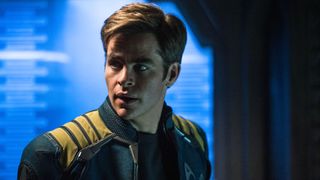
Paramount has officially announced a new Star Trek movie – but it's not Star Trek 4.
The Untitled Star Trek Origin Story was unveiled at CinemaCon, with J.J. Abrams set to produce (H/T The Wrap ). The film will take place decades before 2009's Star Trek, with Andor's Toby Haynes set to direct and Abraham Lincoln, Vampire Hunter author Seth Grahame-Smith set to pen the script. Plot details have yet to be released. Deadline first announced the film earlier this year.
Haynes directed the popular Black Mirror episode U.S.S Callister, which acts as a Star Trek parody. Black Mirror season 7 will feature a sequel to U.S.S Callister , though it has not yet been announced who will direct.
Paramount also stated that the origin pic would begin production later this year to make it in time for a 2025 theatrical release. Star Trek 4, the sequel to Abrams' 2009 flick, is still in development. WandaVision's Matt Shakman was previously attached to direct, but left the project in August 2022 around the same time he was announced as the new Fantastic Four director. Last month, Variety reported that Sucker Punch and Supernatural writer Steve Yockey would pen the fourth Star Trek film, which intends to bring back Chris Pine, Zachary Quinto, and the rest of the cast.
The Untitled Star Trek Origin Story does not yet have a release date. For more, check out our list of the most exciting upcoming movies in 2024 and beyond, or, skip right to the good stuff with our list of movie release dates .
Sign up to the GamesRadar+ Newsletter
Weekly digests, tales from the communities you love, and more

Lauren Milici is a Senior Entertainment Writer for GamesRadar+ currently based in the Midwest. She previously reported on breaking news for The Independent's Indy100 and created TV and film listicles for Ranker. Her work has been published in Fandom, Nerdist, Paste Magazine, Vulture, PopSugar, Fangoria, and more.
A live-action TMNT: The Last Ronin adaptation is officially in the works - and it's rated R
Civil War star Kirsten Dunst says director Alex Garland is a risk-taking "auteur" – even though he "hates" the word
Are we sure Star Wars Outlaws is a Ubisoft game? Its director says there are no map towers to climb out in the open world
Most Popular
By Dustin Bailey 11 April 2024
By Hirun Cryer 11 April 2024
By Emily Garbutt 11 April 2024
By Iain Harris 11 April 2024
By Amy West 11 April 2024
By Bradley Russell 11 April 2024
By Catherine Lewis 11 April 2024
By Molly Edwards 11 April 2024
By Megan Garside 11 April 2024
The No Apologies Tour, pt.2 Star Trek Wars
- TV & Film
“And now…the conclusion.” In the second Part of two specials, Jeremy & Connor move on to discuss their "No Apologies" picks, going over opinions and thoughts they had about classic Trek (The Original Series, The Next Generation , Deep Space Nine, Voyager, and Enterprise) that has remained true and unwavered throughout the years. Plus Jeremy plays an excerpt from the tell all novel based on Connor's whereabouts during the year he took off from Star Trek Wars, reveals his secret segments alluded to in part one, reads your comments and in a stunning development, the final fate of Guns N Roses "Nightrain" is decided. The Bootneck: (02:15) a very real excerpt from the first book of the Connor Reed series of novels. No Apologies: (07:26) Tonight’s main topic. Not all our opinions were wrong, some held up. What were they? Nightrain: The Last Stop. (59:07) Jeremy revisits one of his most controversial opinions on Star Trek Wars and gives his final verdict. Nightrain by Guns N Roses, great actually, or still terrible? Comments: (1:03:23) thanks for writing in on tonight’s topic! Here’s what you had to say. Closing credits:(1:06:56) Thanks for listening and to all that participated. Heres what's coming up next. Join the Council and start voting and leaving comments with the potential of having your comments read on air! https://www.facebook.com/groups/startrekwars/ You can support us by becoming a Patreon Member here! https://www.patreon.com/startrekwars Talk to us using (720)372-4019 or through Speakpipe! Please leave a 5 Star Review on iTunes to have your review read on air, plus a chance to win sweet STW swag! Talk to us on Twitter @TheStarTrekWars Email us at [email protected] Buy sweet Star Trek Wars Merchandise!
- Episode Website
- More Episodes
Top Podcasts In TV & Film

New Star Trek Prequel Movie Is Officially Official, Andor And Black Mirror Director Confirmed
C aptain's Log: Stardate 2024. It's been eight years since the USS Enterprise's last voyage on the big screen, with the franchise having since returned to its roots on television. During that period, the property has proliferated thanks to an influx of streaming series that's included everything from a "Next Generation" reunion to a raunchy cartoon and a wonderfully silly musical episode . But through it all, the question has lingered: when will Trekkies get to undertake another mission painted on the largest canvas available?
It's not been for lack of effort on Paramount's part. Ever since the commercial disappointment of 2016's "Star Trek Beyond" brought the escapades of the Kelvin Universe film series to a halt, the studio has cycled through one filmmaker after another in its quest to get "Star Trek" up and running in theaters once more. Most recently, it turned to "Black Mirror" director Toby Haynes to helm a new chapter based on a script by "Abraham Lincoln: Vampire Hunter" and "The LEGO Batman Movie" scribe Seth Grahame-Smith. At the same time, Paramount has continued to try and mount a fourth and final chapter in the Kelvin Timeline story that began with J.J. Abrams' "Star Trek" in 2009, having only barely recruited Steve Yockey ("The Flight Attendant") to work his magic on the screenplay.
Thankfully, we finally got an official update today during Paramount's CinemaCon presentation in Las Vegas (which /Film's Ryan Scott was there to witness with his own two eyes). The studio confirmed that Haynes' film will usher in the franchise's long-awaited return to theaters while, apparently, also functioning as a prequel to the previous Kelvin Universe movies. Production will begin later this year.
Read more: 12 Reasons Why The Original Series Is The Best Star Trek Show
Star Trek Will Boldly Go Before It's Never Gone Before
Literally winding back the clock for a mission is common practice in "Star Trek," so much so that the property even has a strict set of rules covering all the do's and don'ts of time travel (lest anyone step on a butterfly and wipe James Kirk out of existence). Prequels, on the other hand, only really came into vogue in the 2000s with the one-two punch of "Star Trek: Enterprise" and Abrams' film, the latter of which also introduced the alternate timeline known as the Kelvin Universe. Now, much as its big screen reboot 15 years ago served to reinvigorate the franchise while also appealing to a new generation of Trekkies, it's possible Paramount's goal here is for Haynes' prequel to revive the Kelvin series before bringing the main cast back while at the same time offering a jumping-on point for those who're new(ish) to the whole trekking across space thing.
Haynes' movie itself has previously been described as an "origin story" for "Star Trek" at large , which certainly supports the idea of it functioning as a soft reset without actually wiping out any earlier continuity (just like Abrams' movie). The director, for his part, has already demonstrated an appreciation for the property with his acclaimed "Black Mirror" episode "USS Callister" -- a darkly satirical take on "Star Trek" tropes and toxic fandom -- while his work on the "Star Wars" series "Andor" proves he's more than up for the task of taking a beloved sci-fi property and subverting it in fresh and exhilarating ways. With a little luck, these past eight years will prove to be more than worth the wait.
Keep it tuned to /Film for further updates on anything and everything "Star Trek."
Read the original article on SlashFilm

Screen Rant
Star trek origin movie officially announced by paramount for 2025 release.
Paramount Pictures officially announces the next Star Trek movie at CinemaCon, which will arrive in movie theaters in 2025.
- Paramount Pictures announces new Star Trek movie for 2025, directed by Toby Haynes and written by Seth Grahame-Smith.
- Chris Pine-led Star Trek 4 remains in development, while the new film is an origin story set decades before Abrams' 2009 movie.
- Alongside the Star Trek origin movie, Paramount reveals a packed slate of exciting films for 2025-26 at CinemaCon in Las Vegas.
Paramount Pictures officially announces the next Star Trek movie, which is scheduled to arrive in theaters in 2025. As reported in January, the next Star Trek movie isn't the long-delayed, Chris Pine-led Star Trek 4 produced by J.J. Abrams, which remains in development at Paramount. Rather, the next Star Trek movie is an origin story directed by Toby Haynes ( Star Wars: Andor ) and written by Seth Grahame-Smith (A braham Lincoln: Vampire Hunter ).
Screen Rant' s Rob Keyes (@rob_keyes) is at CinemaCon in Las Vegas where Paramount Pictures confirmed the next Star Trek movie , currently called Untitled Star Trek Origin Story , to be released in 2025. J.J. Abrams is also producing Untitled Star Trek Origin Story, which takes place decades before Abrams' Star Trek 2009 movie. See Rob Keyes' Tweet below:
Paramount also confirmed Untitled Star Trek Origin Story will begin production later this year for theatrical release in 2025.
Every Upcoming Star Trek Movie & TV Show
Star trek's new movies in theaters and paramount plus explained, star trek is finally making movies again.
After nearly a decade, Star Trek i s back to making movies. Star Trek on Paramount+ has created a television renaissance for the franchise, but the theatrical side of Star Trek overseen by Paramount Pictures has languished in development hell since Star Trek Beyond bowed in the summer of 2016. Toby Haynes' Untitled Star Trek Origin Story is yet another prequel, but as it's said to be set decades before Star Trek 2009, it could very well be set after Star Trek: Enterprise 's mid-22nd century voyages but otherwise be an origin story for both Star Trek 's Prime and alternate Kelvin timelines .
Meanwhile, J.J. Abrams' Star Trek 4 , which is the "final chapter" of the USS Enterprise crew led by Chris Pine's Captain James T. Kirk and Zachary Quinto's Spock, has seen some movement with a new screenwriter, Steve Yockey ( The Flight Attendant ), tackling the long-delayed sequel. Pine and his fellow Star Trek actors, including Quinto, Zoe Saldana, Karl Urban, and Sofia Boutella, have all expressed their eagerness to return if Star Trek 4 can come together.
It's a positive sign that Star Trek movies are finally coming back.
Paramount+ is making their own Star Trek movies, with the recently-wrapped Star Trek: Section 31 awaiting a release date. Starring Academy Award-winner Michelle Yeoh, Section 31 i s the first made-for-streaming Star Trek movie, and it is reportedly set during Star Trek 's "lost era" with connections to Star Trek: The Next Generation. Section 31 could get a sequel if successful, and the Star Trek: Picard spinoff dubbed Star Trek: Legacy may also become a streaming movie instead of a series. However all this shakes out, it's a positive sign that Star Trek movies are finally coming back.
Source: Rob Keyes Twitter
A Star Trek Origin Movie Is Coming in 2025 From 'Andor' and 'Doctor Who' Director Toby Haynes
'Star Trek' (2009) director J.J. Abrams is attached to produce.
The Big Picture
- A new Star Trek prequel film, an "origin story", is in development, at Paramount.
- The Star Trek history before Kirk's missions on the Enterprise is largely unwritten, leaving room for creativity with the new film.
- Director Toby Haynes, known for Andor , is working on the film alongside writer Seth Grahame-Smith; a 2025 release window was announced at CinemaCon.
Star Trek may finally be coming back to the big screen. A prequel to the 2009 J.J. Abrams reboot of the franchise is in the works from director Toby Haynes . The news comes from Paramount's presentation at CinemaCon today, as reported by Collider's Steve Weintraub and Britta DeVore . With Haynes, who recently helmed six episodes of the acclaimed Star Wars series Andor , at the rudder, the film will be written by Seth Grahame-Smith .
So far, other details on the new film are scarce, but it will reportedly be an "origin story", taking place decades before the 2009 Star Trek film, which took place in 2255. That likely means that it will not feature the cast from the 2009 reboot, which has so far been difficult for Paramount to wrangle together for a fourth film, despite numerous attempts to do so . That doesn't necessarily mean that a fourth movie isn't happening: back in March, Paramount hired The Flight Attendant scribe Steve Yockey to pen a new script for the film. For their part, the cast is game as well, with Zoe Saldaña recently stating her willingness to return for a fourth mission on the USS Enterprise .
What Happened Decades Before Kirk's First Missions on the Enterprise?
The history of the Star Trek universe prior to the celebrated voyages of the Enterprise is largely unwritten. The first starship Enterprise 's adventures in the 22nd century were chronicled on the UPN prequel series Star Trek: Enterprise . That series ended with the founding of the United Federation of Planets in 2161, which leaves almost a century of mostly unexplored history between that and the history now being charted on Star Trek: Strange New Worlds (and the first two seasons of mothership show Star Trek: Discovery ).
At some point, the nascent Federation faces a devastating war against the Romulan Star Empire , while also engaged in a Cold War with the Klingons. The USS Enterprise will eventually be launched in the 23rd century, under the captaincy of Robert April, who has been briefly glimpsed on Star Trek: The Animated Series and Strange New Worlds , before being handed off to Christopher Pike . Apart from that, however, Haynes and Graeme-Smith have a near-blank canvas upon which to make their mark.
In addition to Andor , Haynes has also helmed episodes of Doctor Who , Sherlock , and Black Mirror ; his work on the latter series includes the episode " USS Callister ," a loving pastiche of Star Trek . Graeme-Smith wrote the novels Pride & Prejudice & Zombies and Abraham Lincoln, Vampire Hunter ; he worked on the story for the upcoming horror comedy sequel Beetlejuice Beetlejuice .
A new Star Trek prequel film is in development; no date has yet been set beyond a 2025 release window . Stay tuned to Collider for future updates.

IMAGES
COMMENTS
Star Trek is an aspirational sci-fi series set in humanity's future, while Star Wars is a bombastic fantasy adventure that takes place in a far-off galaxy. One has primarily lived on weekly ...
Star Trek was introduced in 1966 as a live-action television series and lasted three years with 79 episodes. Star Trek: The Animated Series premiered in 1973 and lasted two seasons with 22 episodes. With the subsequent publication of novels, comics, animated series, toys, and feature films, Star Trek grew into a popular media franchise. Star Wars was introduced as a feature film, Star Wars (1977).
SpaceNews Senior Staff Writer Jeff Foust, third from left, moderates the Star Trek vs. Star Wars debate Thursday at Redwire's booth during the 39th Space Symposium in Colorado Springs. Credit ...
While "Star Wars: Episode IV - A New Hope," opened on May 25, 1977, "Star Trek: The Original Series" premiered on NBC over a decade prior, with its first episode, "The Man Trap," airing on ...
Pop Culture and Legacy. Star Trek has a devoted cult following of hardcore fans known as "Trekkies". There are various Trekkie conventions all over the world where fans dress up in costumes and may have a chance to meet cast members, or to discuss the issues of the show. Some Trekkies even learn the show's constructed language, Klingon.There was a Star Trek-themed attraction in Las Vegas ...
Academy Award-winner Nicolas Cage explains why he prefers Star Trek to Star Wars.Cage is part of the generation that grew up watching Star Trek: The Original Series in syndication in the 1970s. By 1977, the blockbuster success of Star Wars led Paramount Studios to turn its planned sequel series, Star Trek: Phase II, into a full-blown movie adventure, Star Trek: The Motion Picture.
9 Star Trek: Utopia. While Star Wars is focused on having faith in an external source (although the Force is also an internal source. It really is hard to explain), Star Trek is about faith in humanity. Gene Roddenberry's vision of the future is one where Earth is a utopia.
But the answer is more complex than that, and ultimately seems to favor Star Trek Star Wars. Obi-Wan Kenobi is set roughly a decade before the events of the original Star Wars adventure, with Ewan ...
Star Wars has long been one of pop culture's biggest franchises, a juggernaut that brought sci-fi to the masses in a way few other movies or TV shows have. Star Wars has left an indelible mark on the world with over eleven movies, multiple TV shows, comics, and novels.However, for Star Wars to run, Star Trek had to walk.. RELATED: 10 Greatest Star Trek Villains Of All Time, Ranked
Commentary: In the long-running Star-Trek-or-Star-Wars debate, strong arguments can be made for both sides. ... So far, the bulk of the Star Wars saga has taken place over six (soon to be seven ...
Stashwick of Team Wars: Stashwick noted that with J.J. Abrams, he "clearly was a Star Wars man" who was "handed the keys to the Star Trek kingdom and he made a Star Wars version of Star Trek," but Stashwick then noted that with Star Wars, "just because you blew up a Death Star once, your problems aren't over."Beating back the demons is "an eternal struggle" and "a noble pursuit."
For decades fans of Star Wars and Star Trek have debated over which one is better. With plenty of opinions on either side the internet often turns into a battleground on this subject. Back in ...
Star Trek premiered on television in 1966, and the first Star Wars film hit theaters eleven years later; the two have been compared to each other ever since. On the surface, the comparisons make sense: both Star Trek and Star Wars belong to a subset of science fiction called "space opera." Space operas stress concepts such as galactic federations or empires, as well as epic battles and ...
Star Wars population is very difficult to assess. Some estimates suggest a 1,000,000 world Empire. But the Galactic Senate depicts a vastly smaller political entity. According to Star Wars Wiki ...
6. Star Wars has better special effects and has advanced filmmaking. At least historically. The original "Star Trek" television show did break ground when it was released, and it did help pave the ...
The following is a list of all military conflicts, rebellions, coups, etc. that have occurred from the distant past to the far future, organized by date. Slaver war: one billion years ago (TAS: "The Slaver Weapon") Arretan final war: 500,000 years ago (TOS: "Return to Tomorrow") Orbital bombardment of Iconia: 200,000 years ago (TNG: "Contagion"; DS9: "To the Death") Unspecified Mesopotamian ...
The most notable "Star Trek" luminary to cross over into "Star Wars" (and most of the actors on this list began in "Trek," moving to "Wars" later) was none other than George Takei, the helmsman of ...
Star Wars is a science fantasy/fiction multi-media franchise created by George Lucas. From its very inception in the form of the first 1977 Star Wars film installment, there has been a definite rivalry between the Star Wars and Star Trek franchises, which Rod Roddenberry - son of Star Trek creator Gene Roddenberry - learned of through first-hand experience, though he was a much bigger fan ...
Star Trek has had many wars over the decades, ranging from smaller conflicts between species to galaxy-wide battles that have gone down as defining points in history. The Star Trek franchise began in 1966 with Star Trek: The Original Series, and to date has produced nine television shows and thirteen films.With the sheer amount of stories that have been told, it isn't surprising storylines ...
Disney (DIS) and Lucasfilm released the new trailer to " Obi-Wan Kenobi " — the latest Star Wars series for Disney (DIS) + on Wednesday. The series, which premieres May 27, brings back Ewan ...
Klingon patrol officers. By 2259 in the alternate reality, after Starfleet's first contact with the Empire, the Klingons had conquered and occupied two planets known to the Federation and fired on Starfleet ships half a dozen times. Tensions between the two powers were high and an all-out war was considered inevitable. During that year, before surrendering to the Federation, Khan Noonien Singh ...
Originally released and created over 20 years ago, the Star Trek vs Star Wars Total Conversion has been put back into the wild alongside the re-release of th...
By Eddie Makuch on April 11, 2024 at 12:06PM PDT. A Star Trek prequel movie is in the works with Star Wars director Toby Haynes attached to direct, Paramount announced during CinemaCon. This has ...
Brent Spiner is one of the most prolific actors from Star Trek: The Next Generation. Best known as Data, Spiner has played the identical androids Lore and B-4, as well as multiple members of the Soong family in TNG, Star Trek: Enterprise, and Star Trek: Picard. In Star Wars: Rebels, voiced Galactic Senator Gall Trayvis.
Paramount also stated that the origin pic would begin production later this year to make it in time for a 2025 theatrical release. Star Trek 4, the sequel to Abrams' 2009 flick, is still in ...
Plus Jeremy plays an excerpt from the tell all novel based on Connor's whereabouts during the year he took off from Star Trek Wars, reveals his secret segments alluded to in part one, reads your comments and in a stunning development, the final fate of Guns N Roses "Nightrain" is decided.
Literally winding back the clock for a mission is common practice in "Star Trek," so much so that the property even has a strict set of rules covering all the do's and don'ts of time travel (lest ...
Paramount Pictures officially announces the next Star Trek movie, which is scheduled to arrive in theaters in 2025. As reported in January, the next Star Trek movie isn't the long-delayed, Chris Pine-led Star Trek 4 produced by J.J. Abrams, which remains in development at Paramount.Rather, the next Star Trek movie is an origin story directed by Toby Haynes (Star Wars: Andor) and written by ...
Star Trek may finally be coming back to the big screen. A prequel to the 2009 J.J. Abrams reboot of the franchise is in the works from director Toby Haynes.The news comes from Paramount's ...